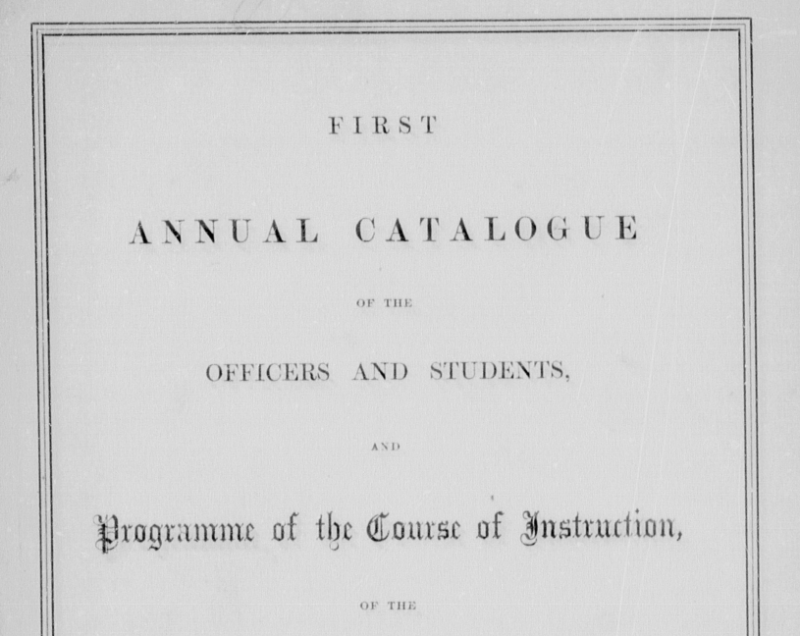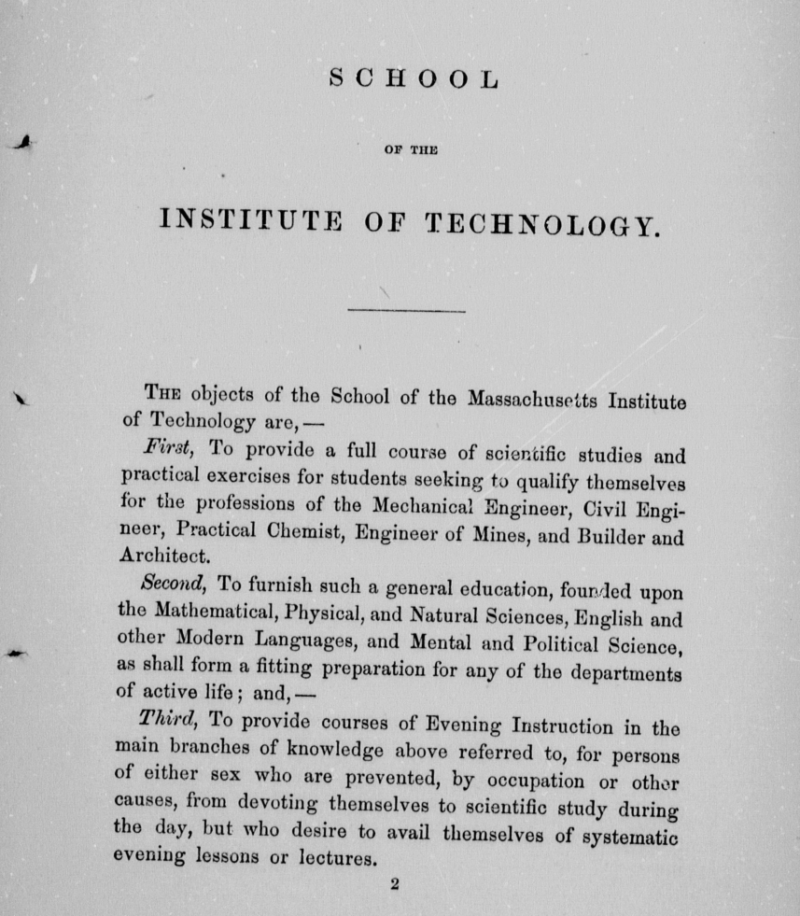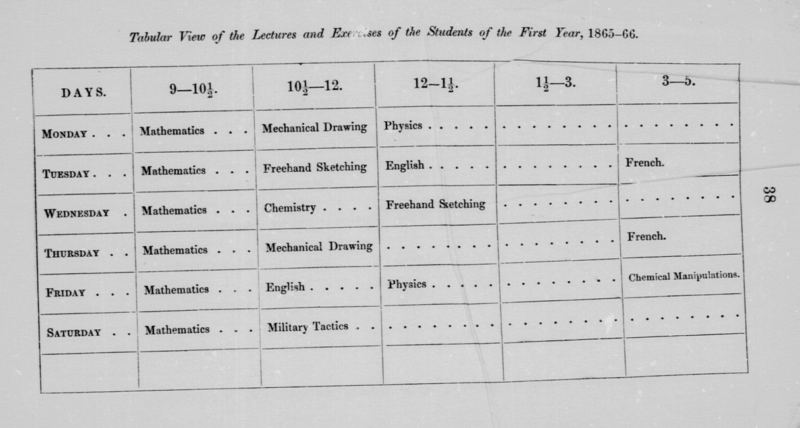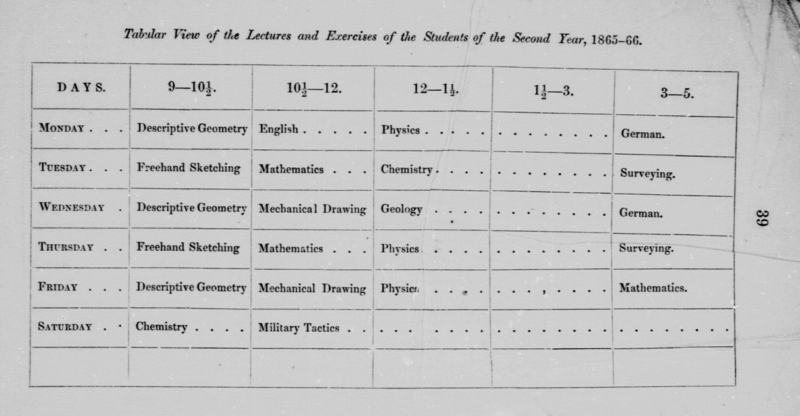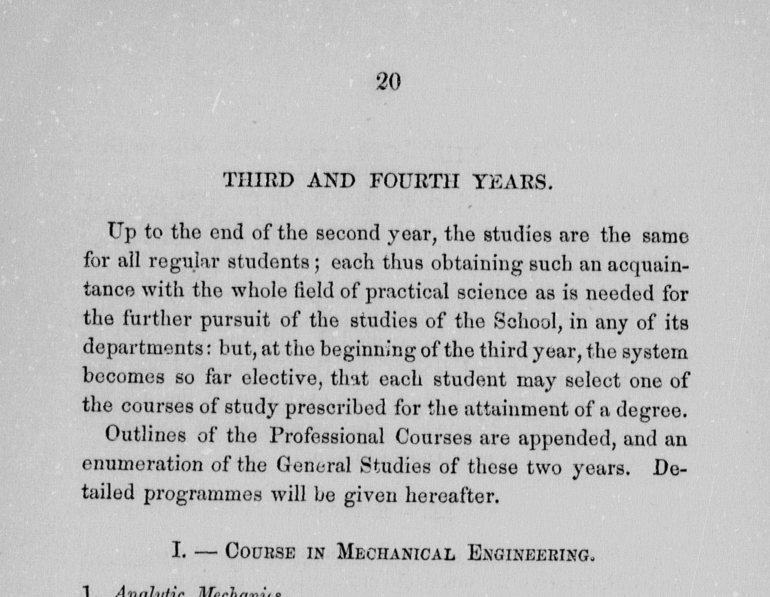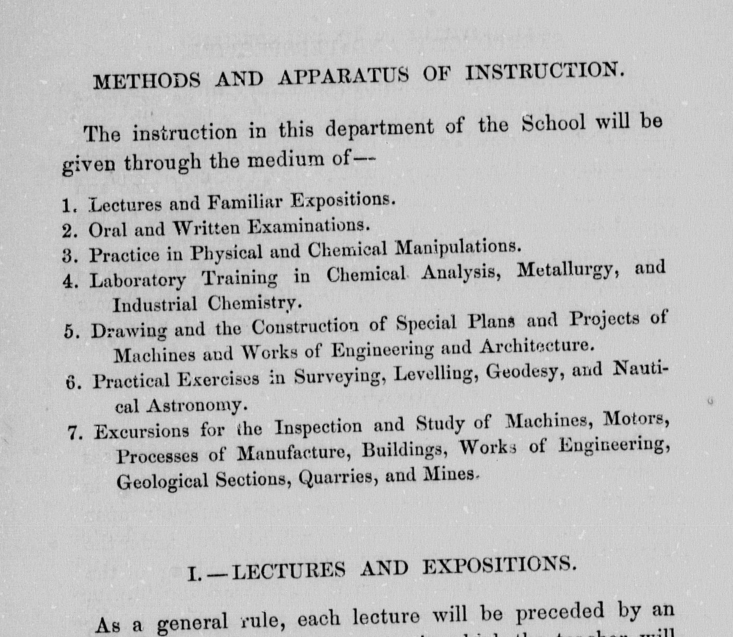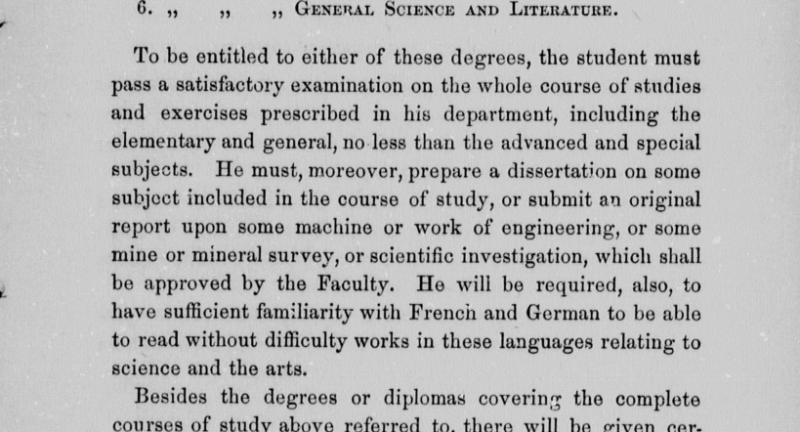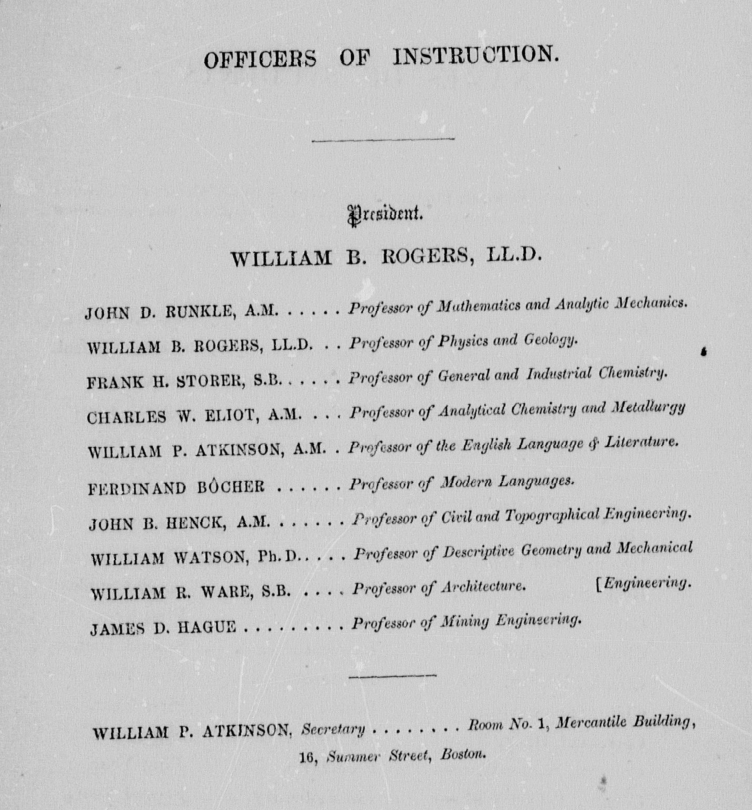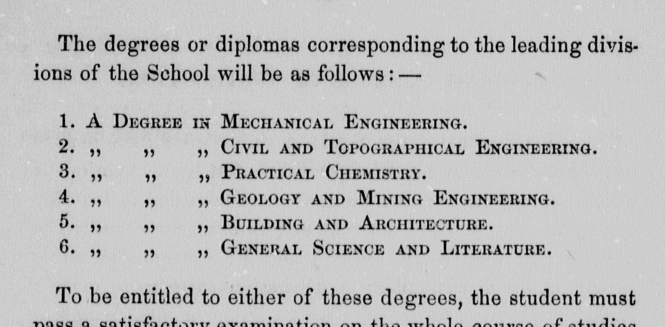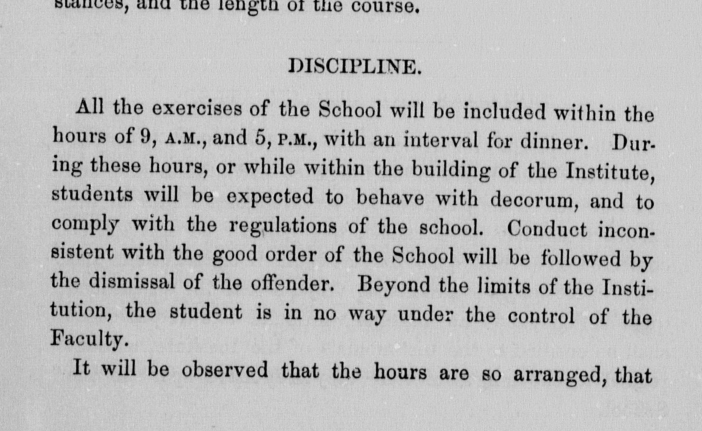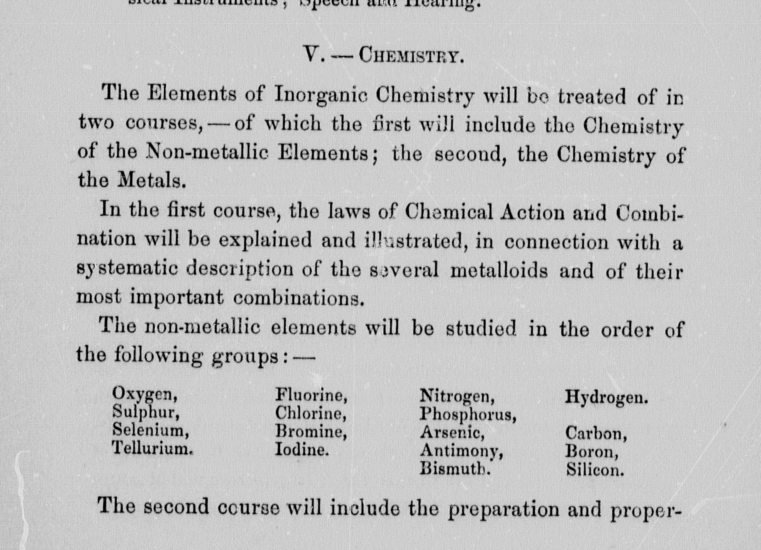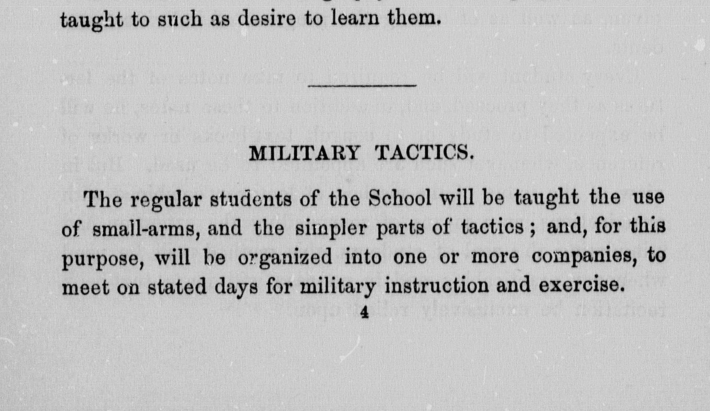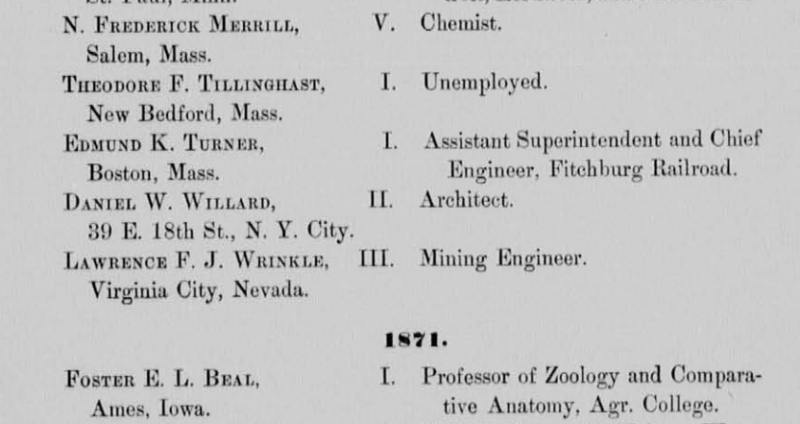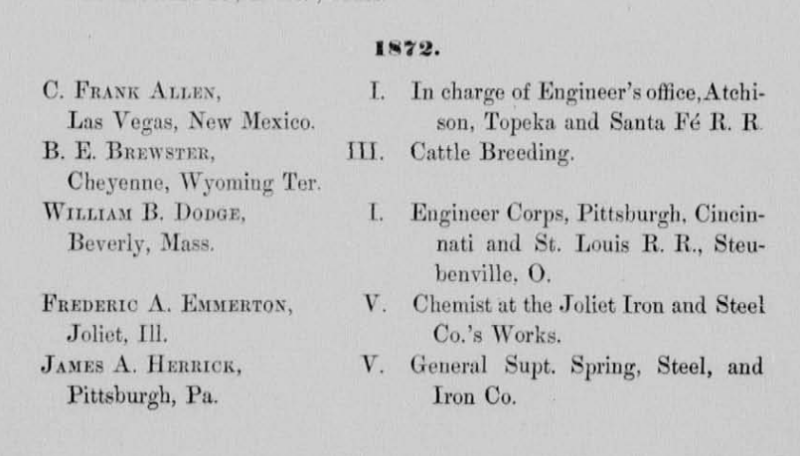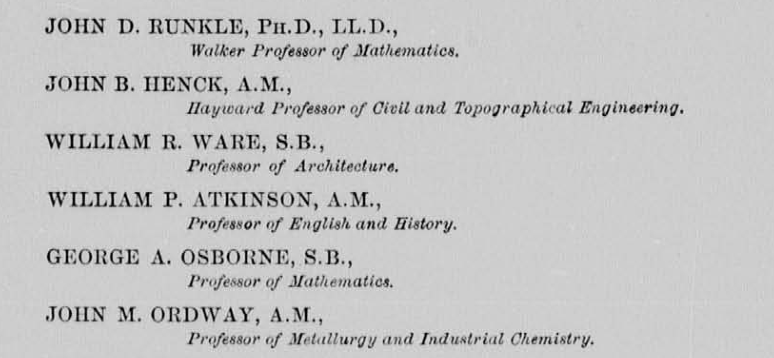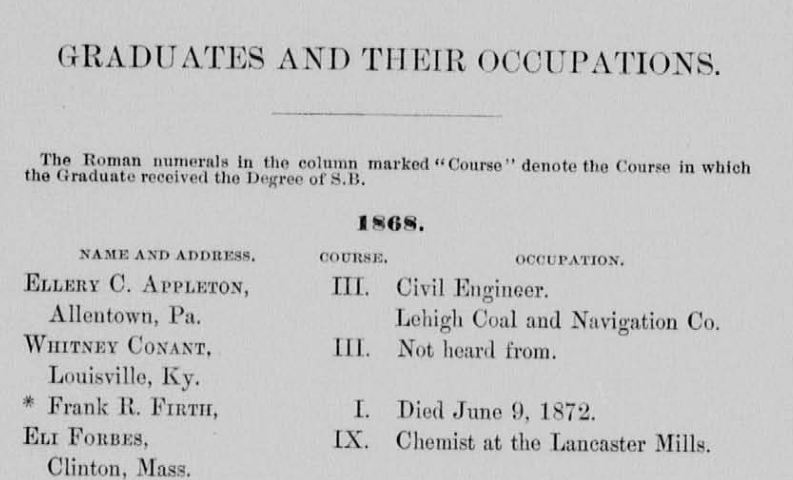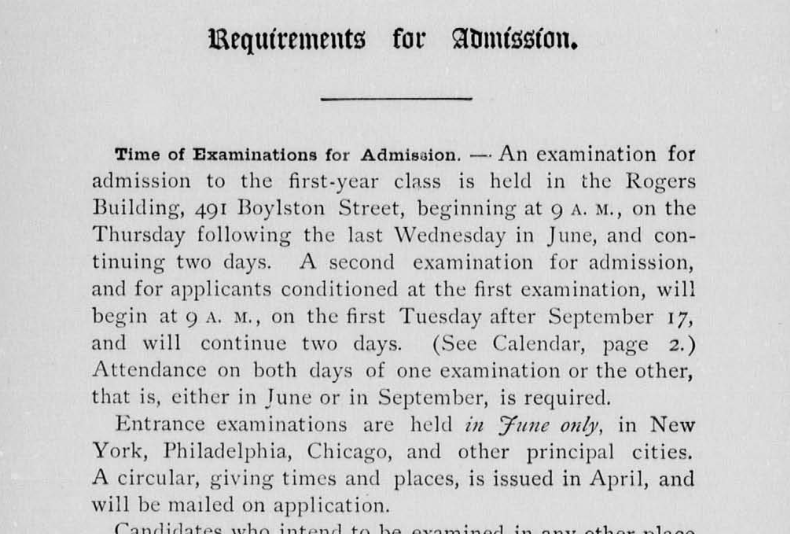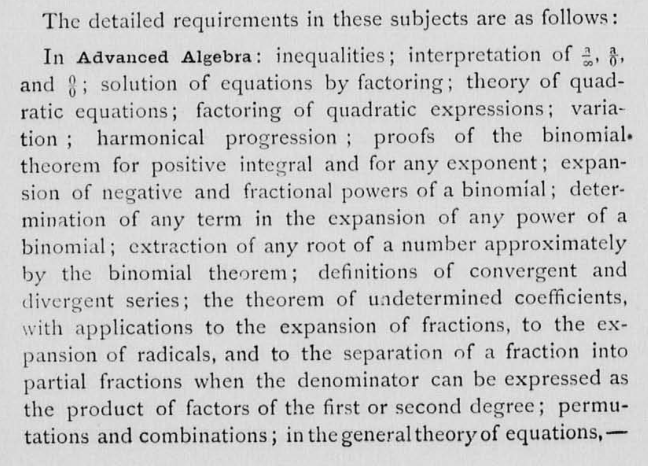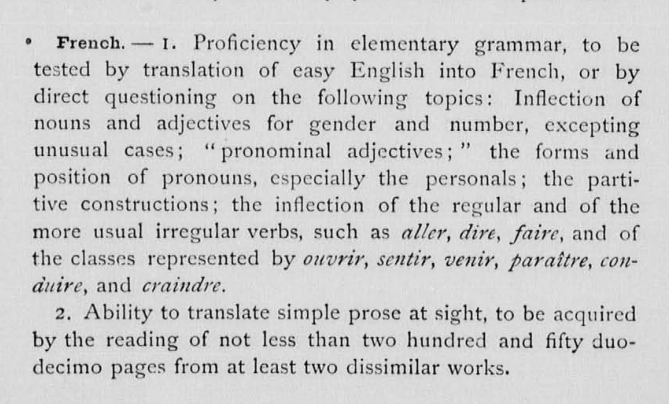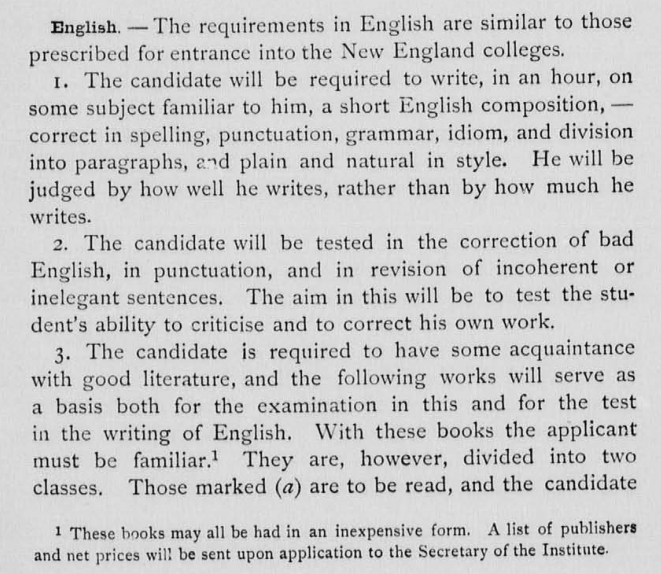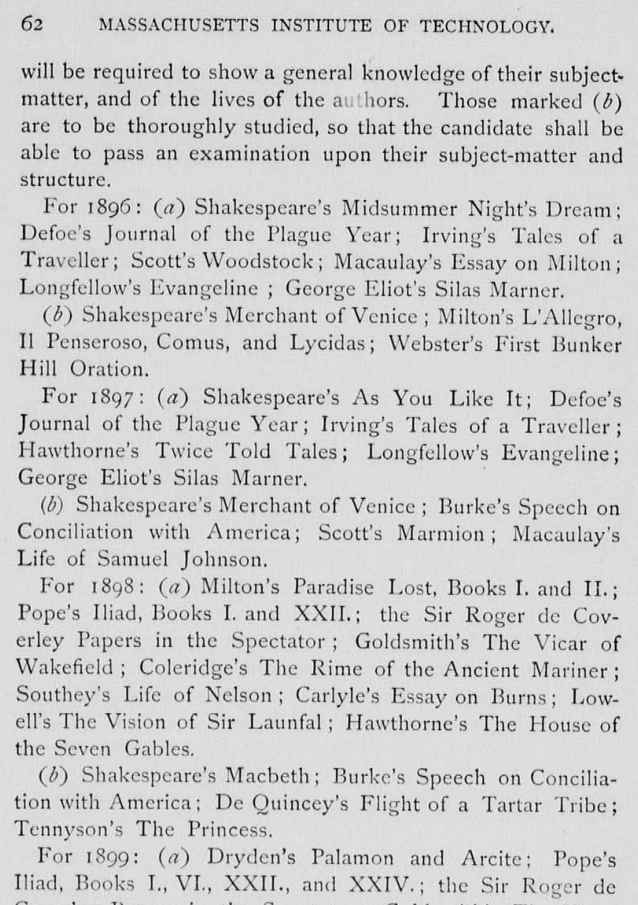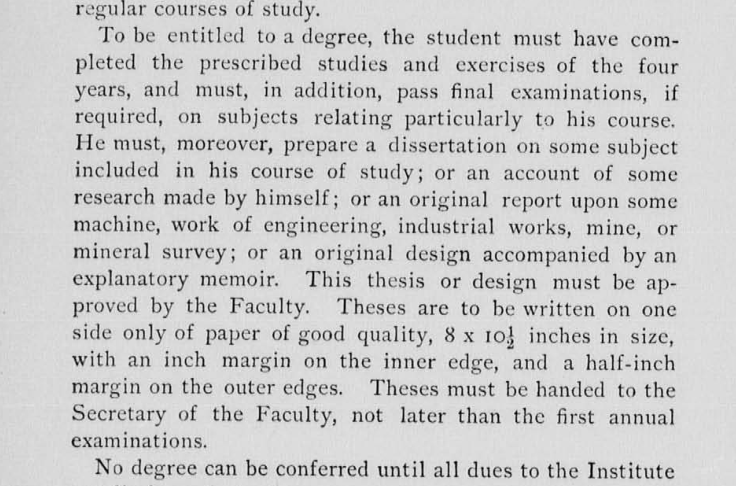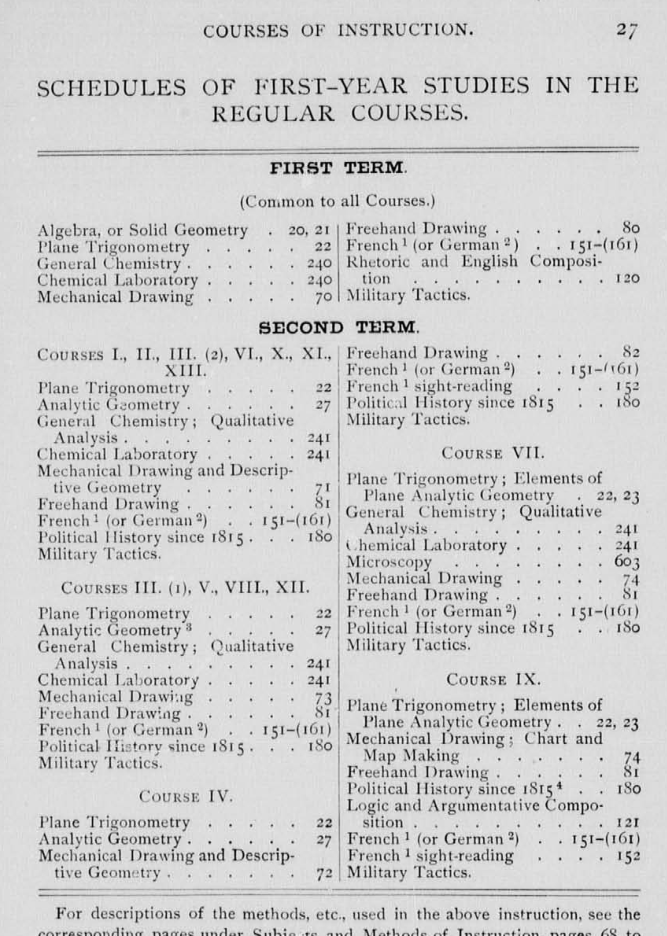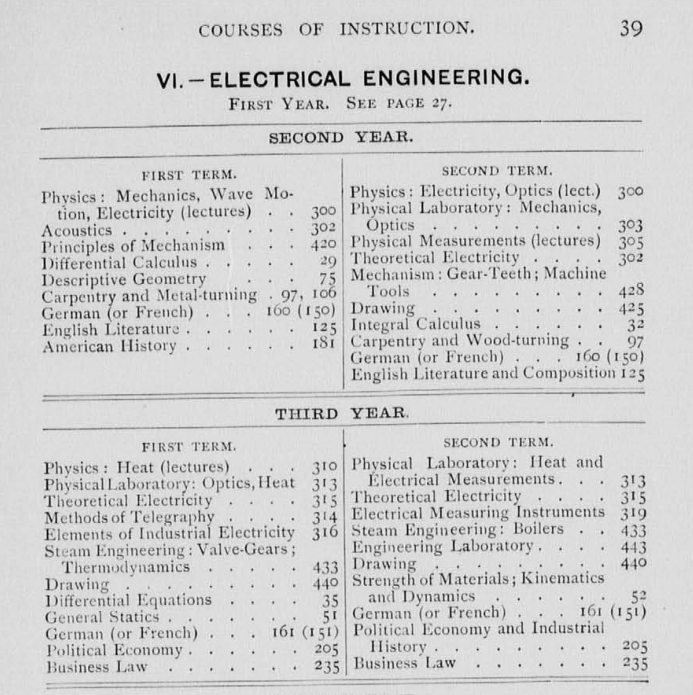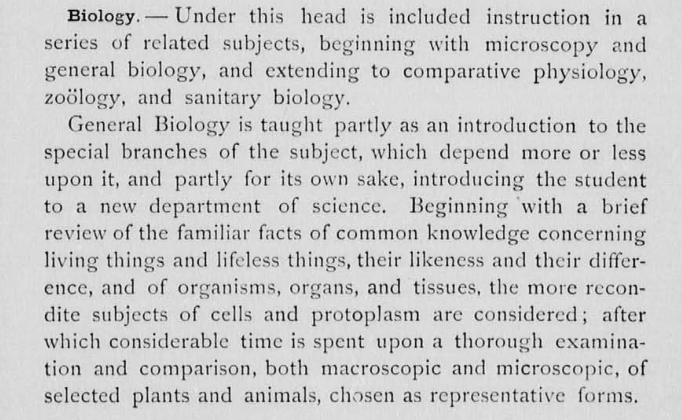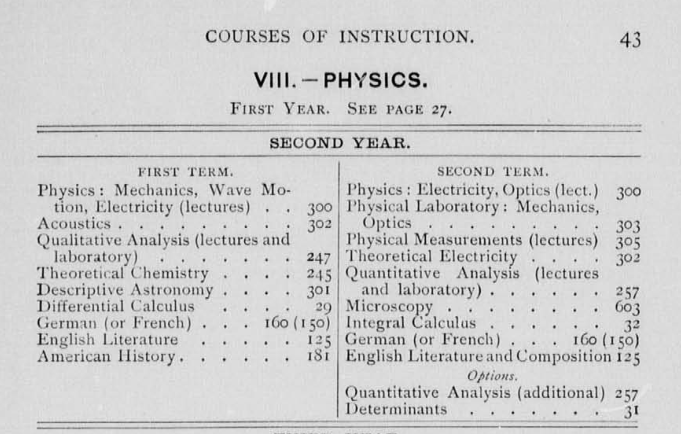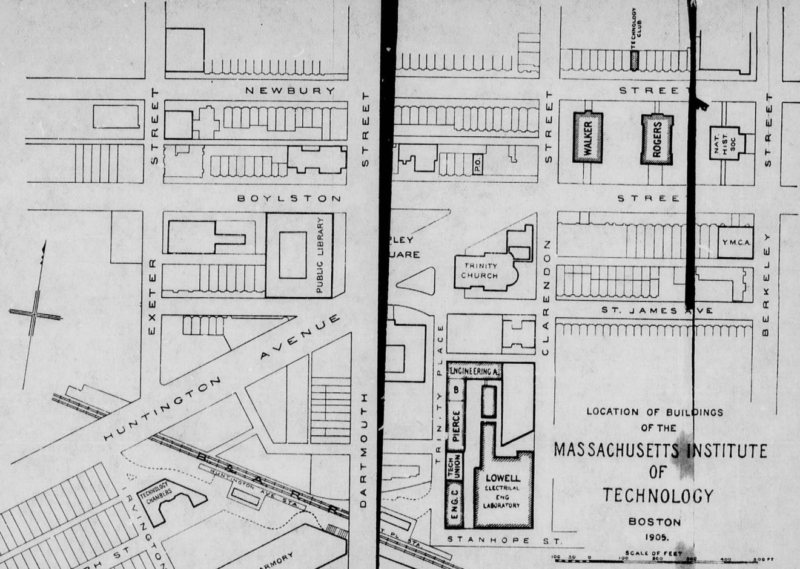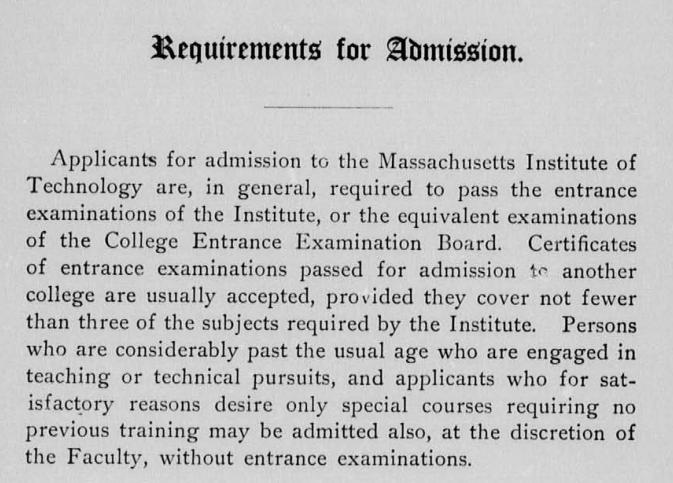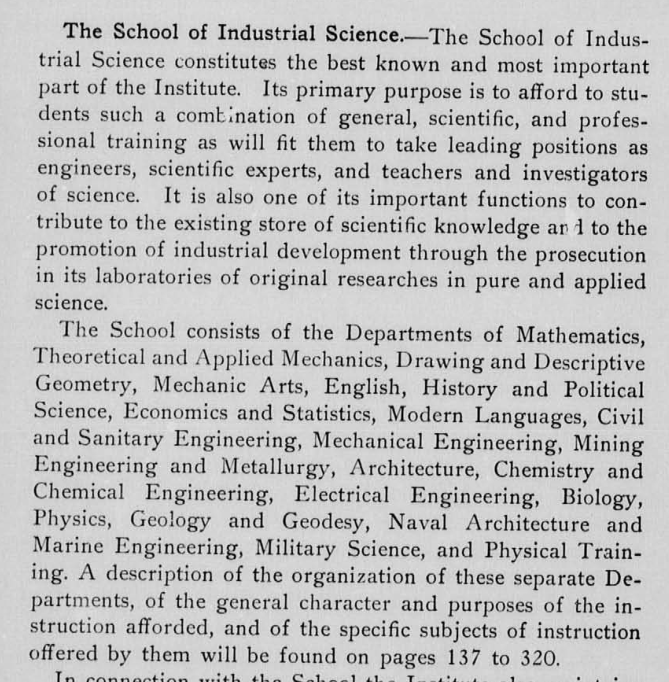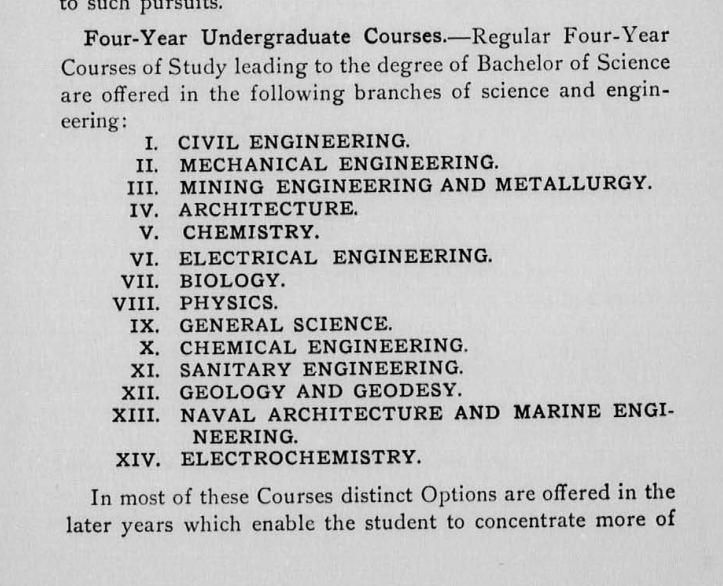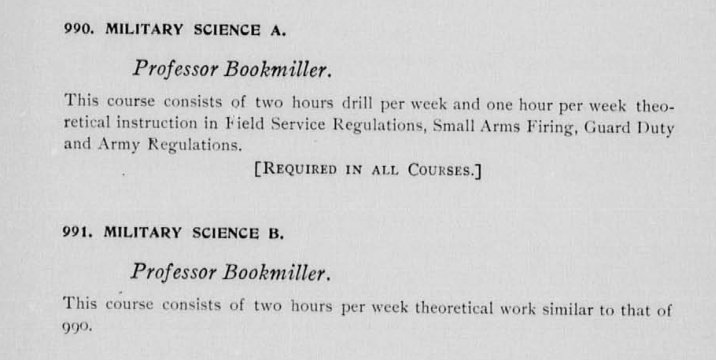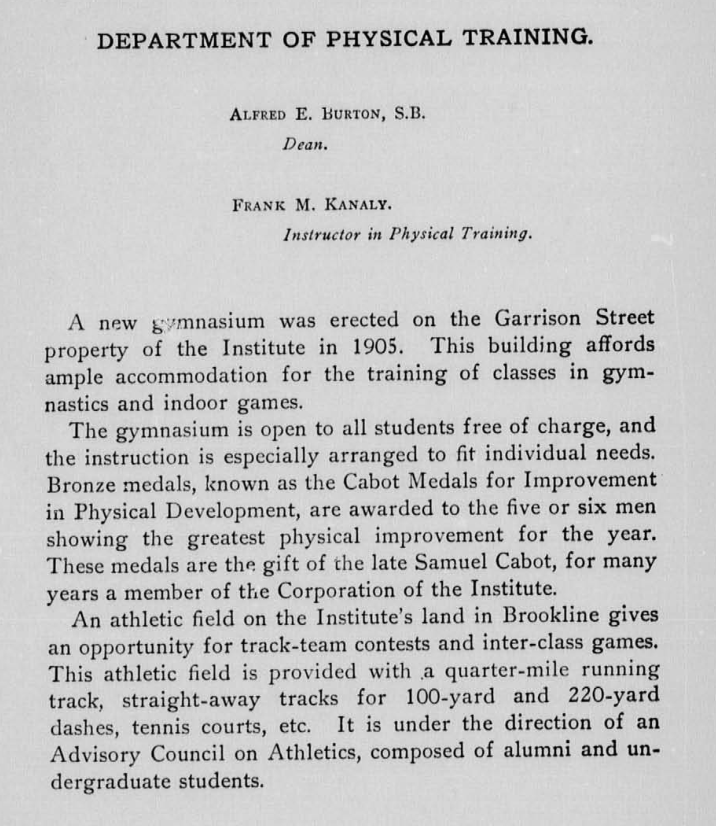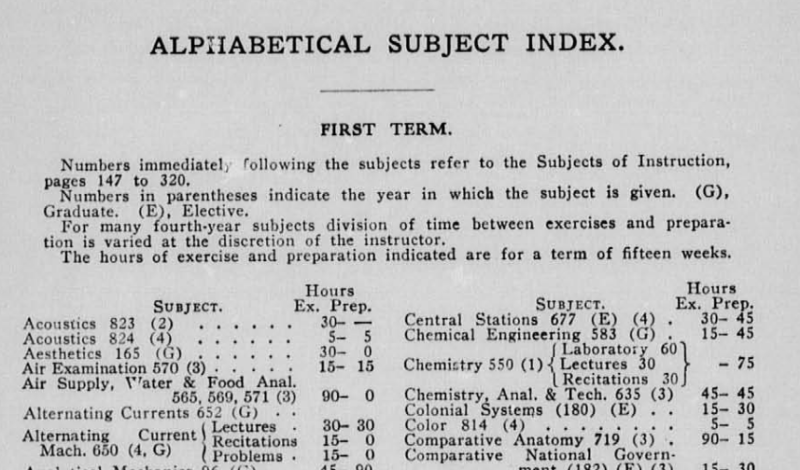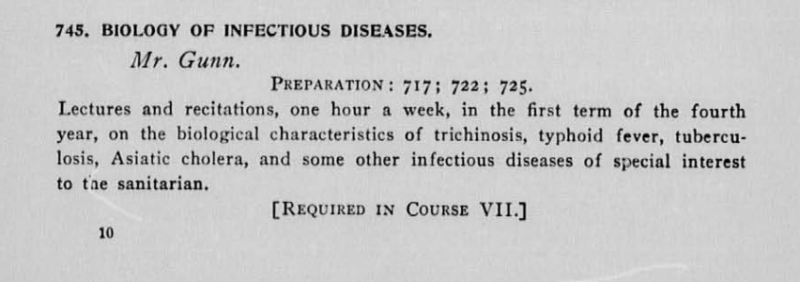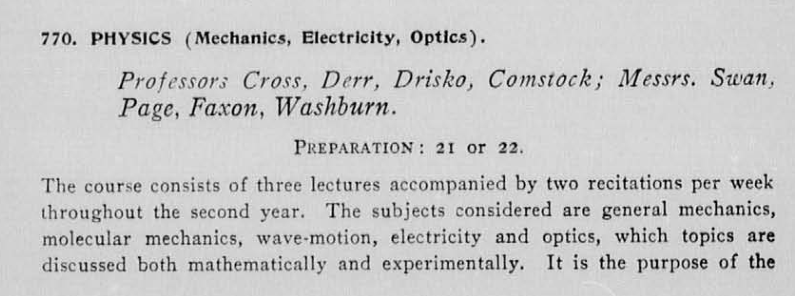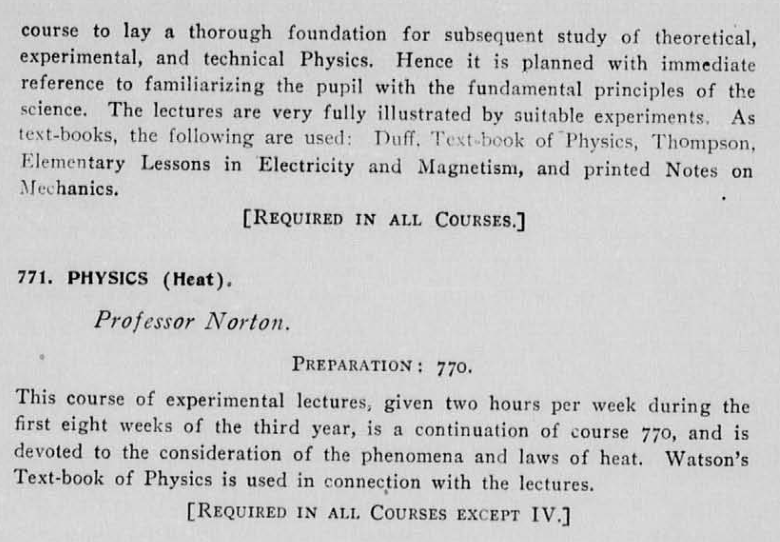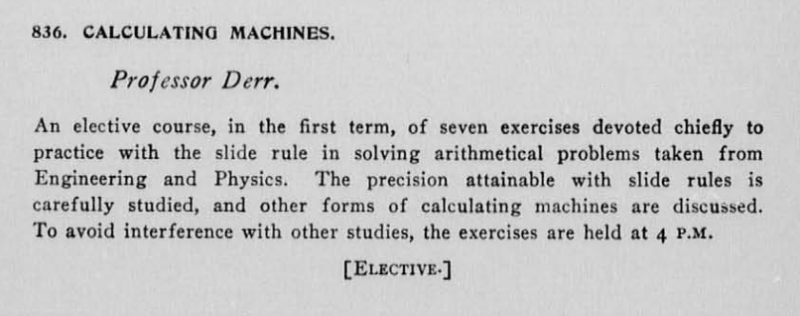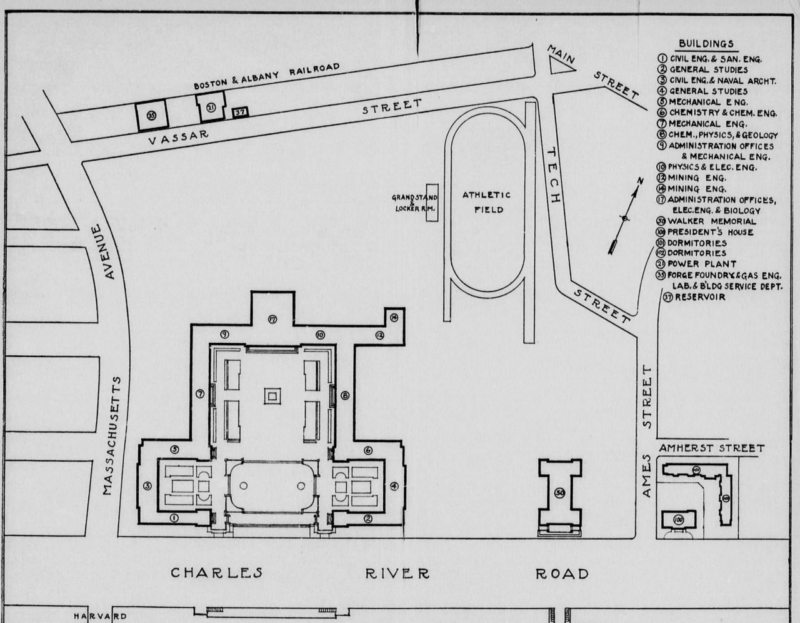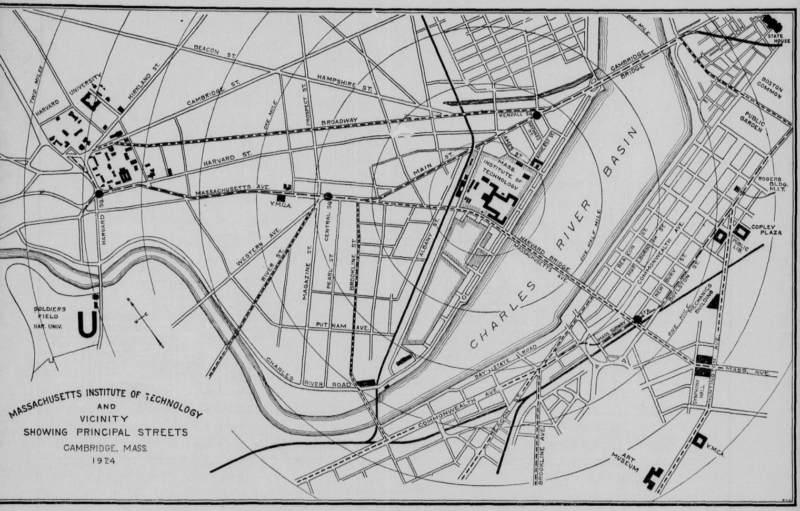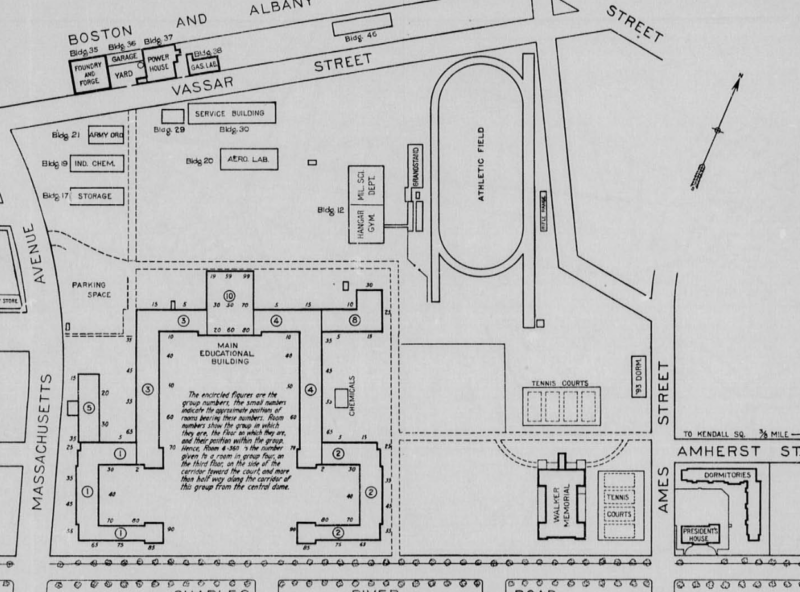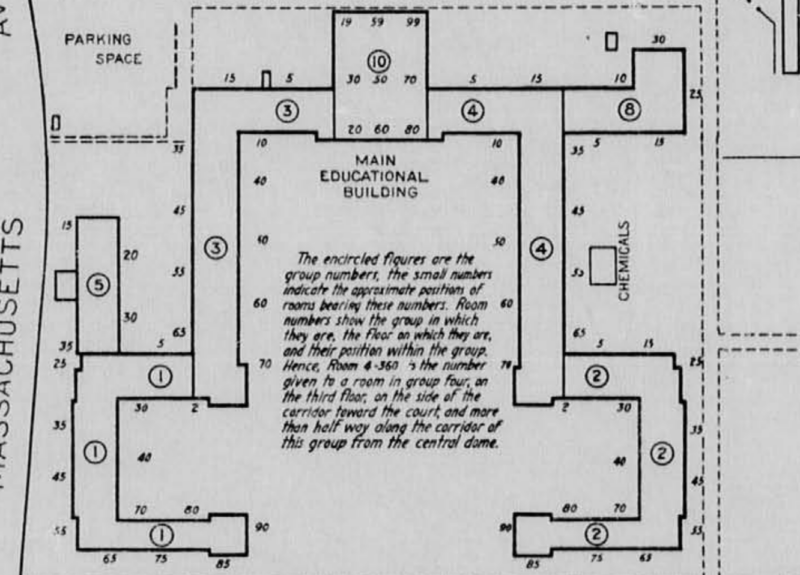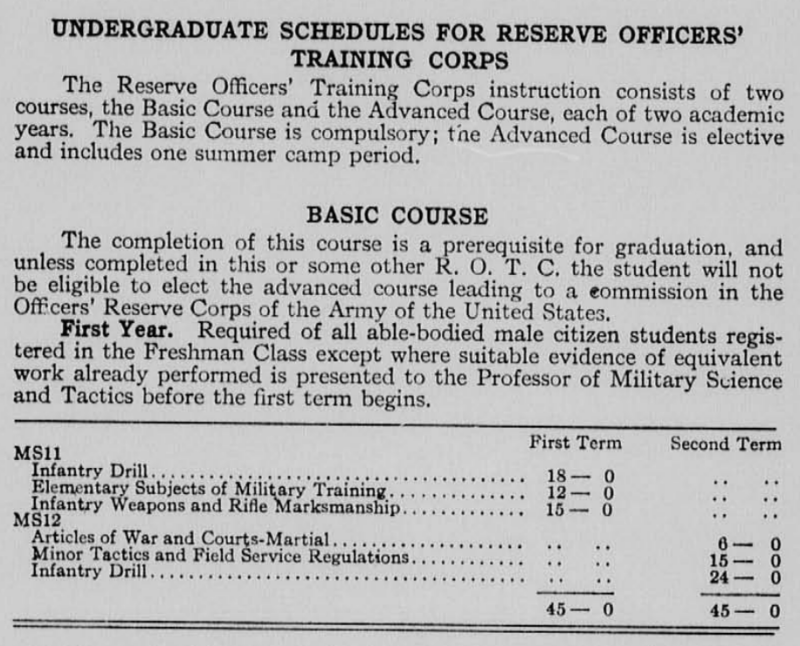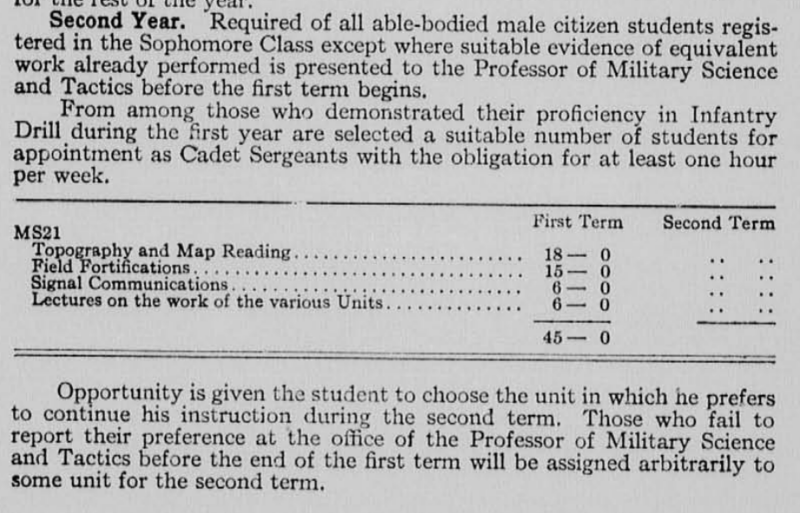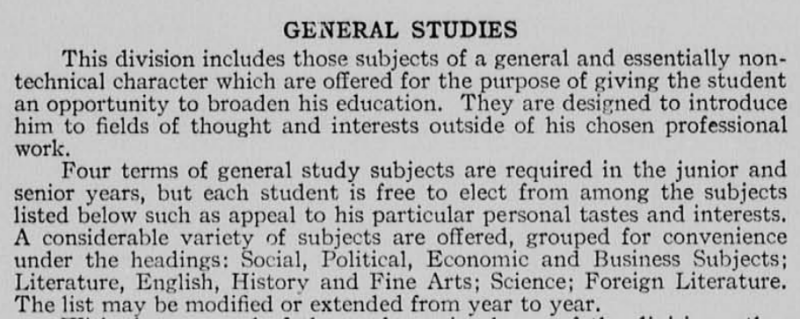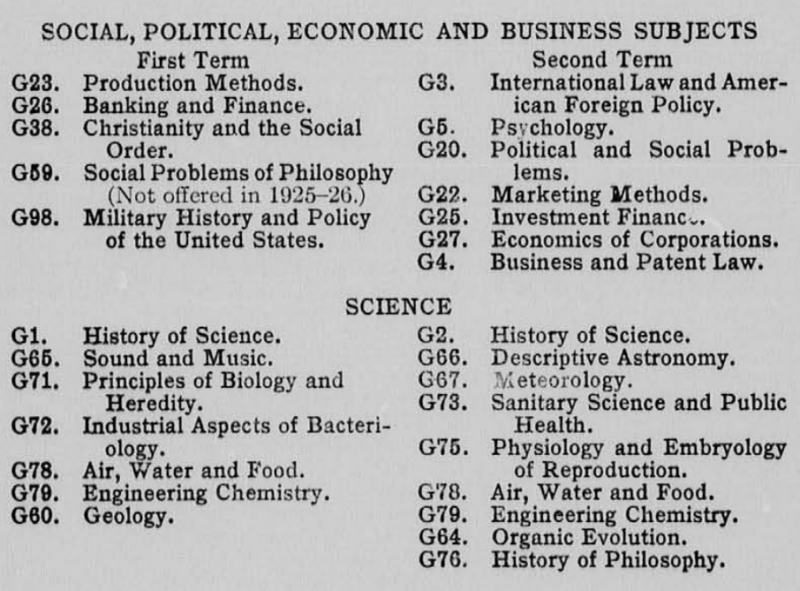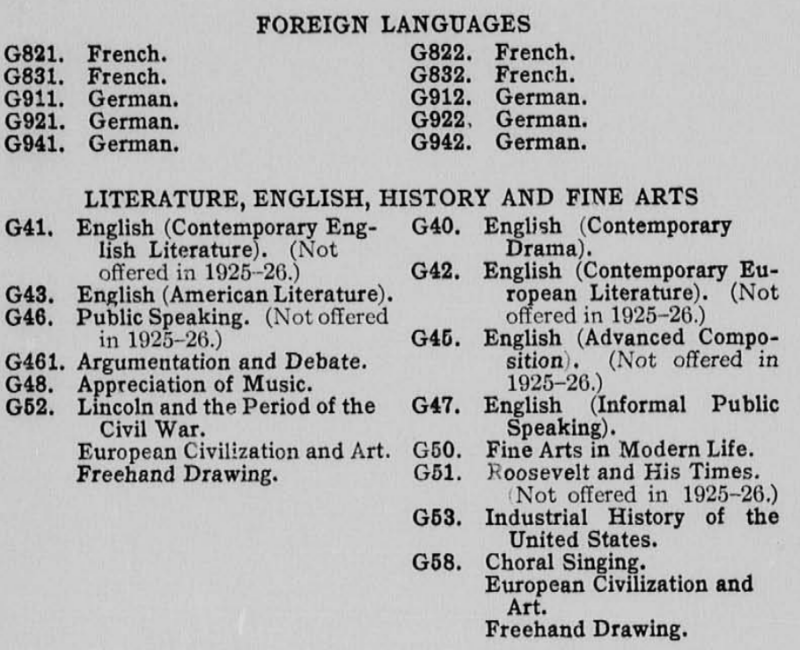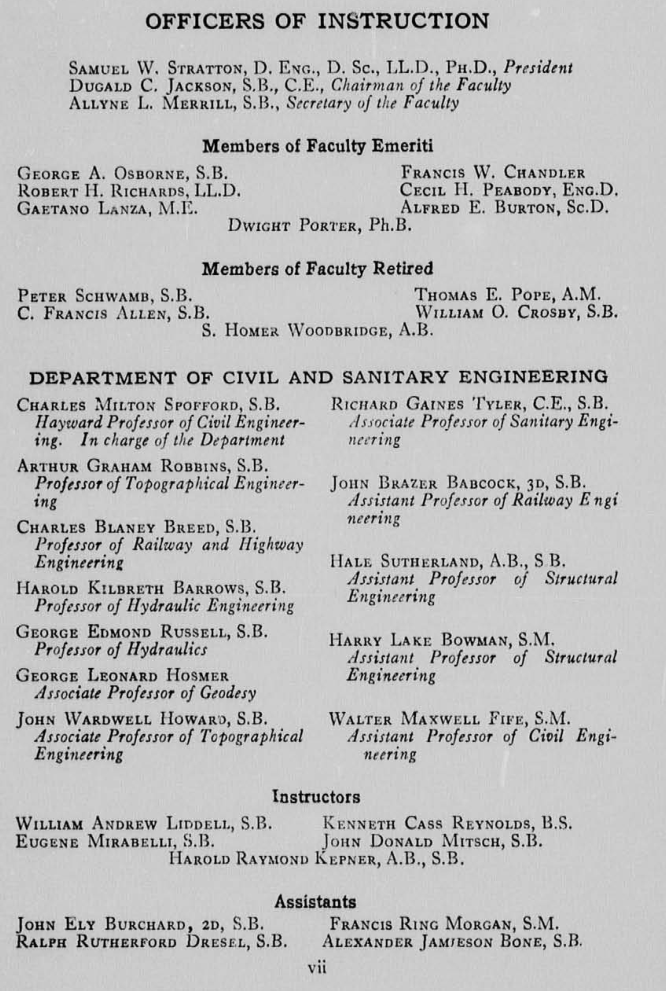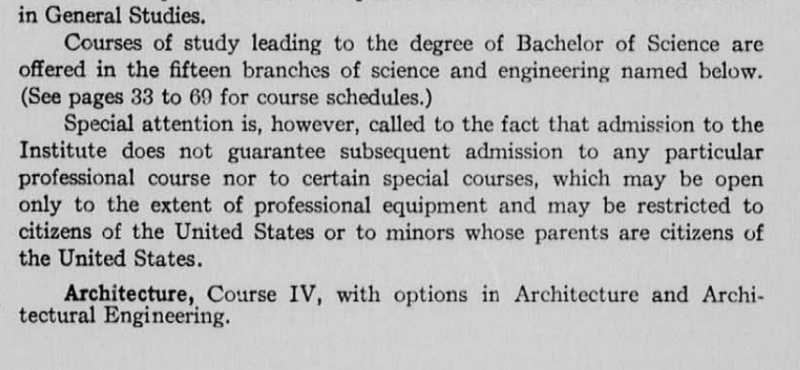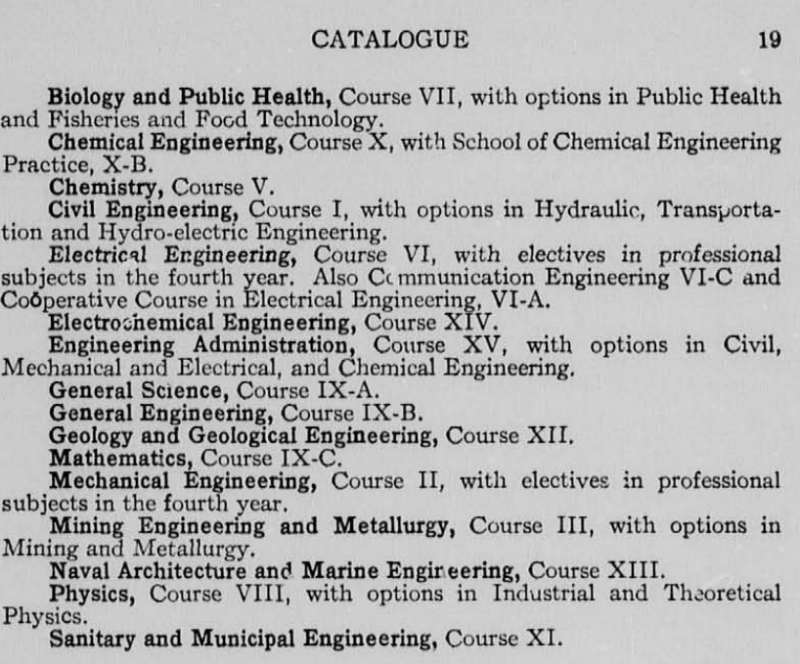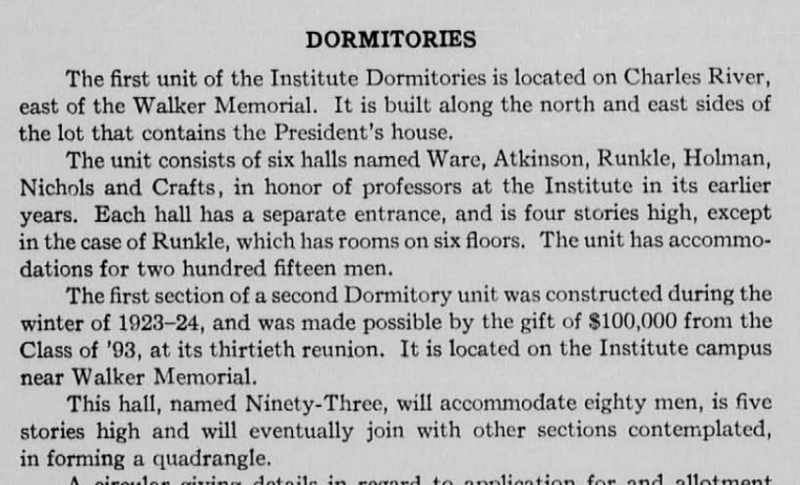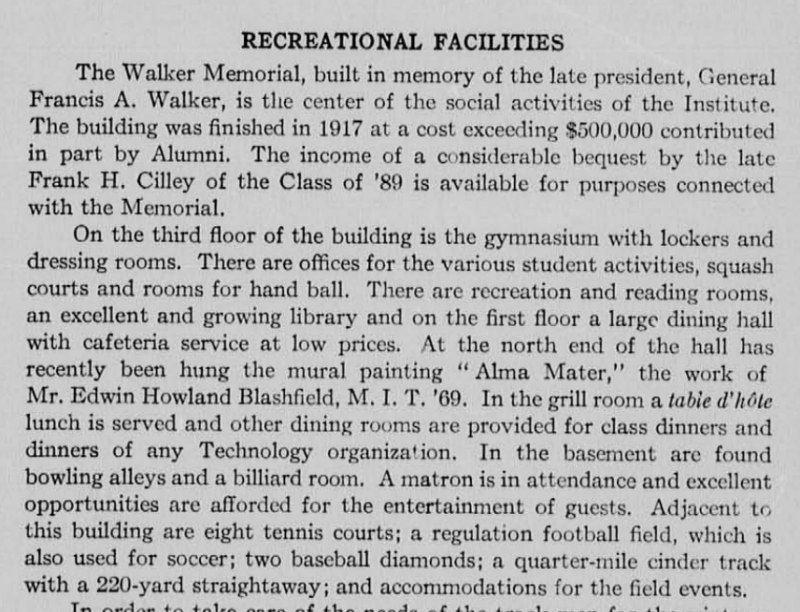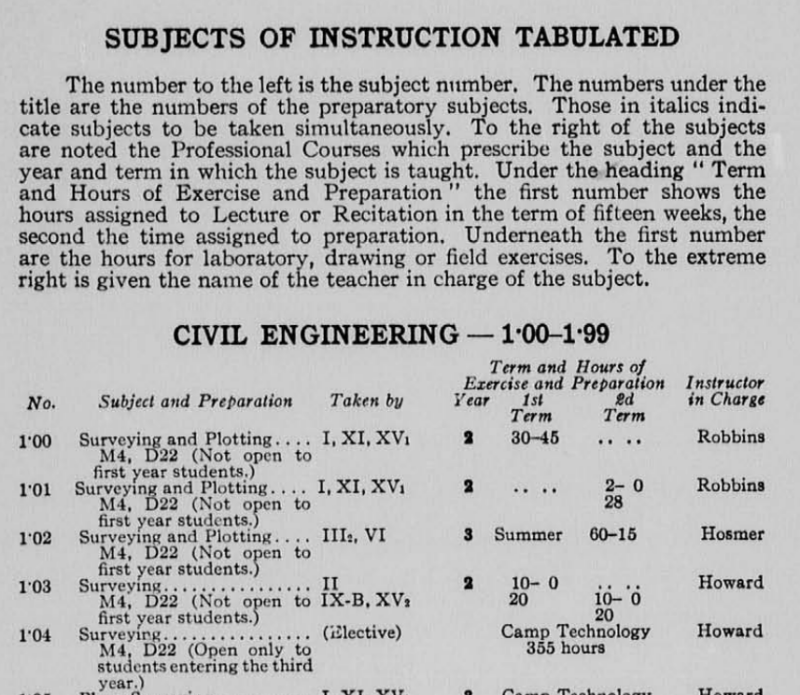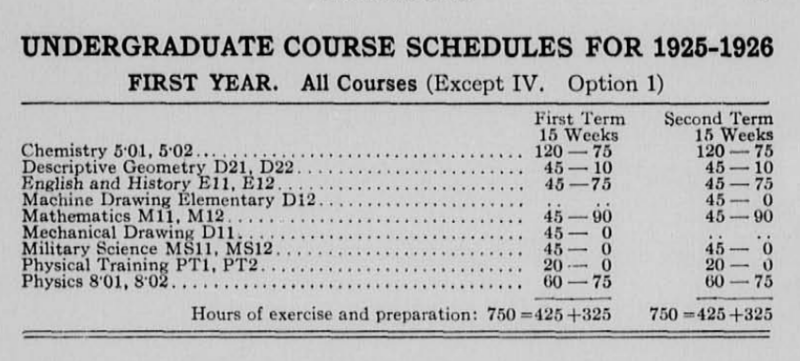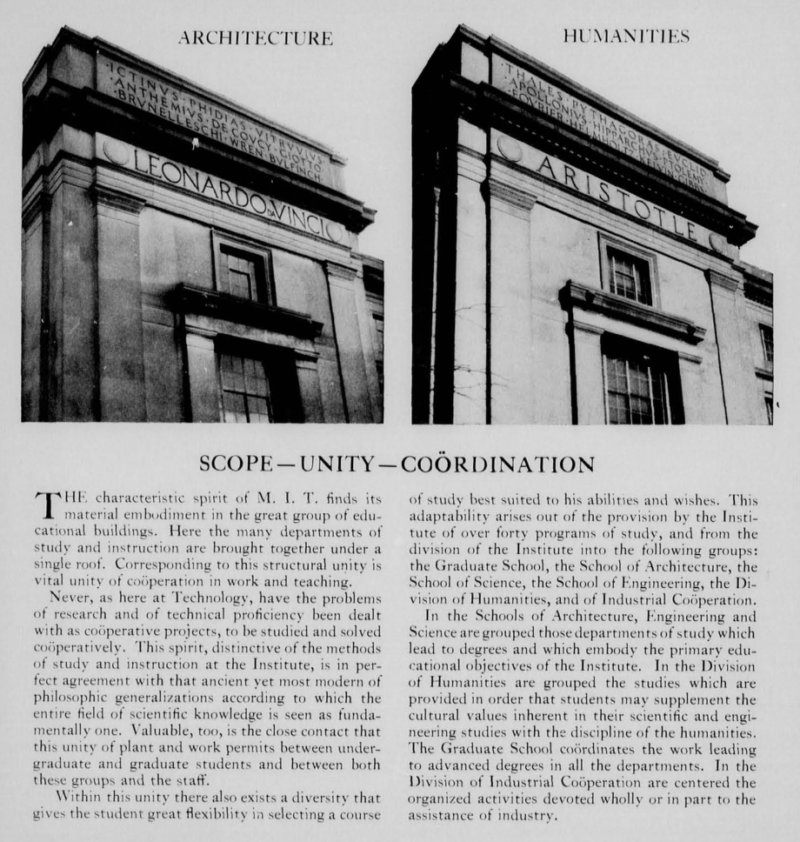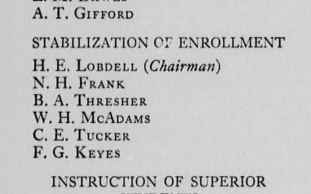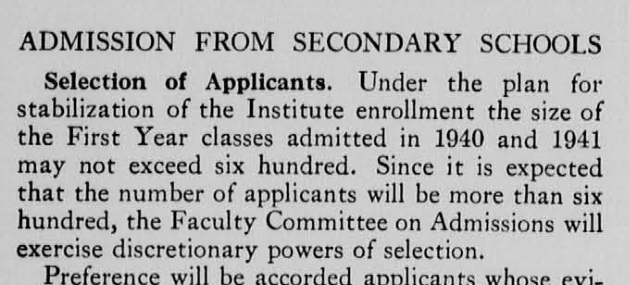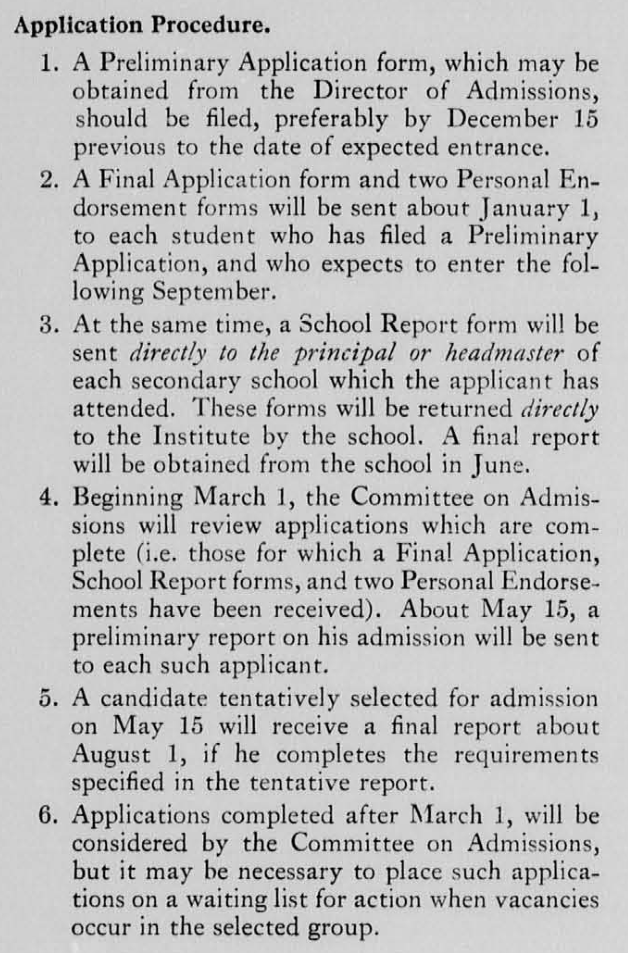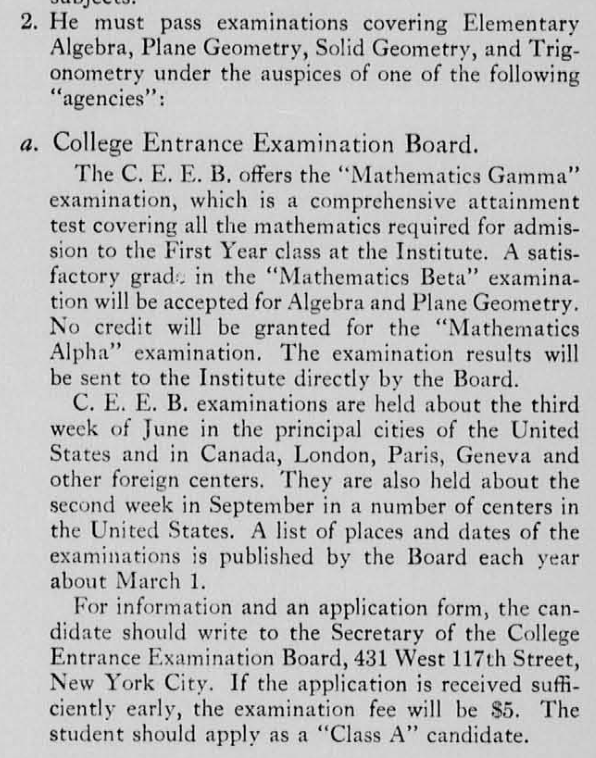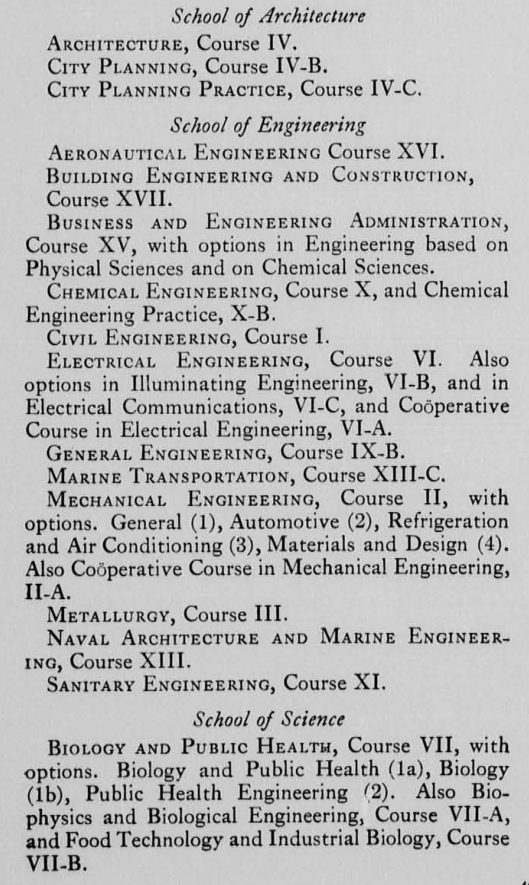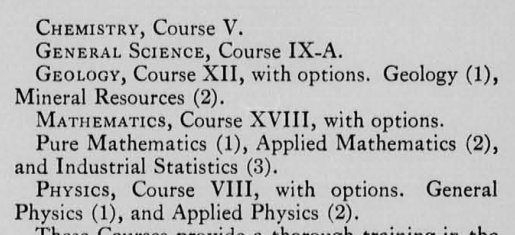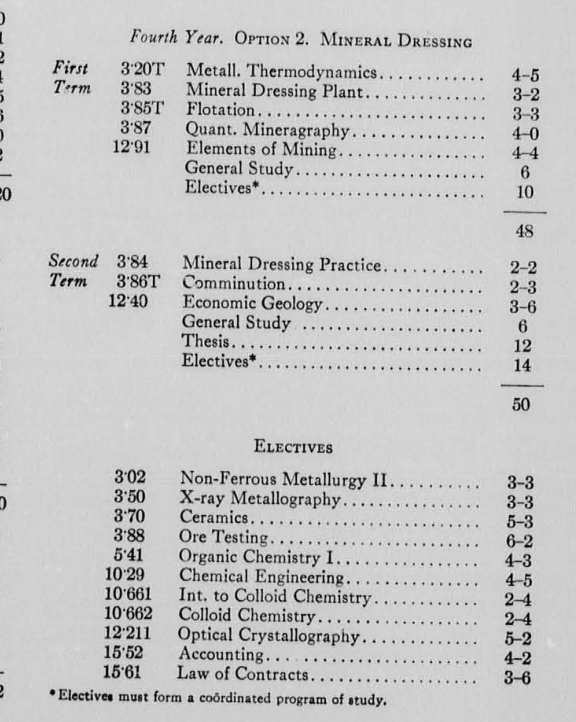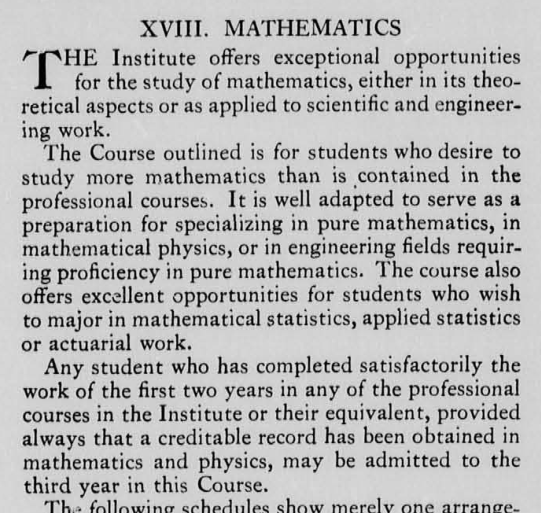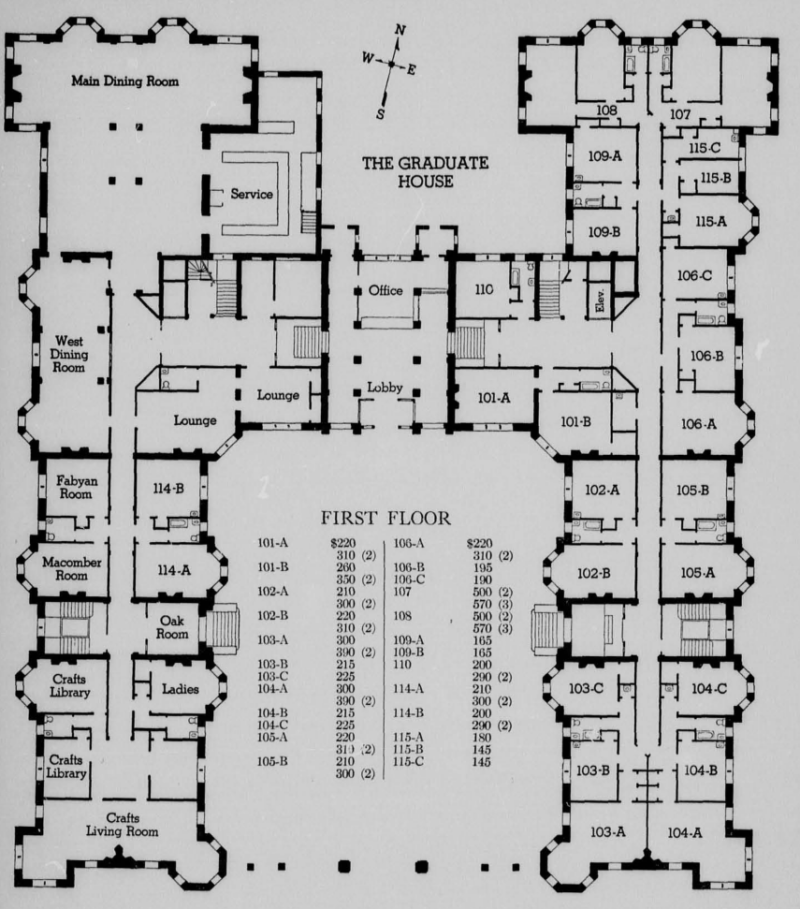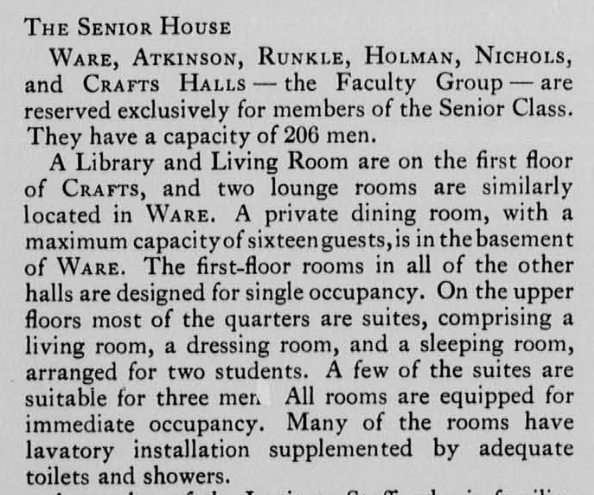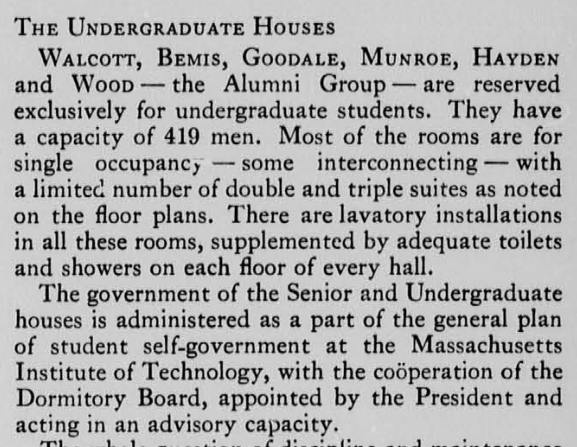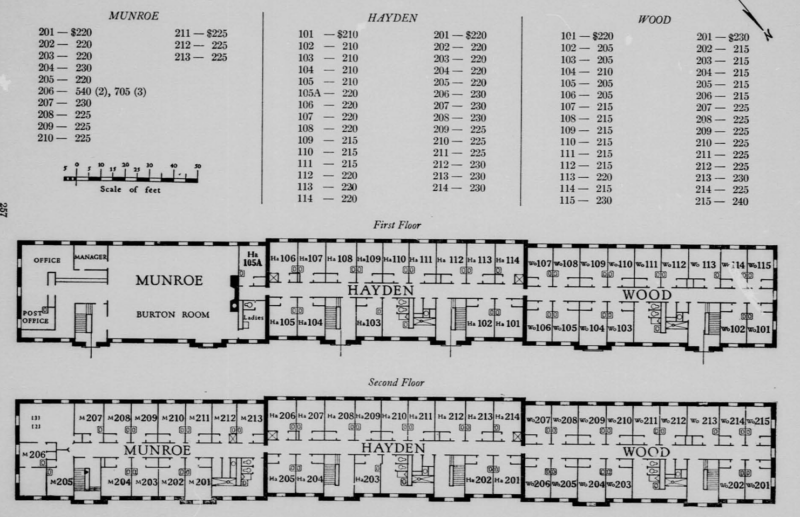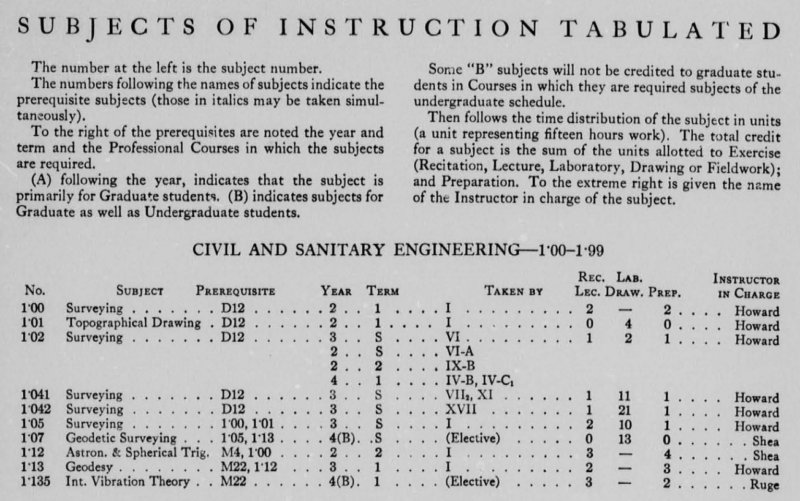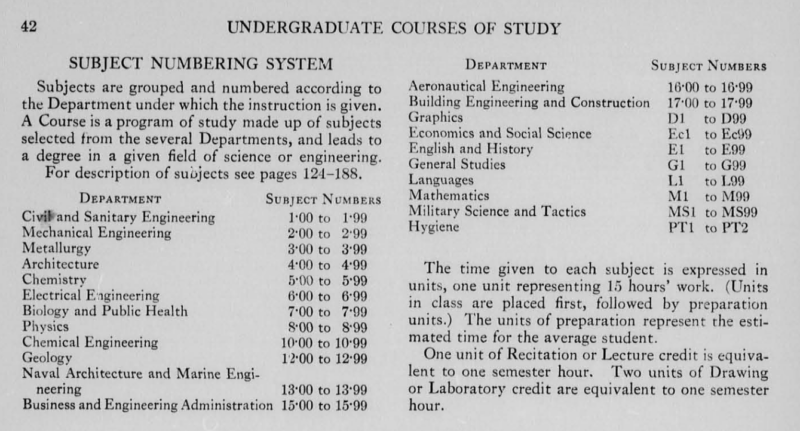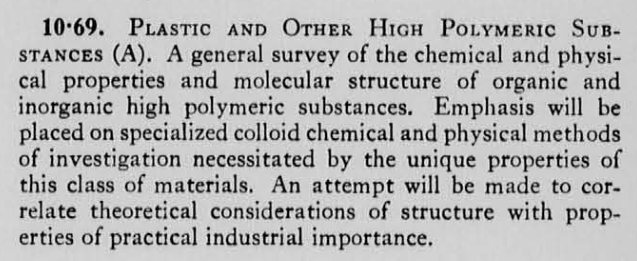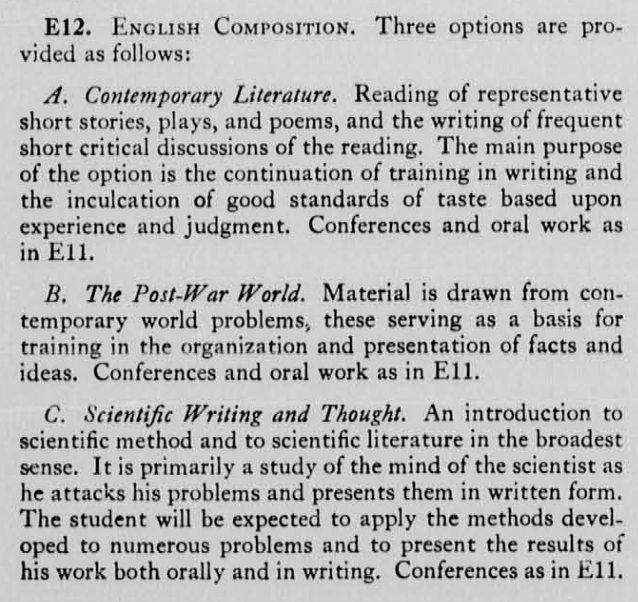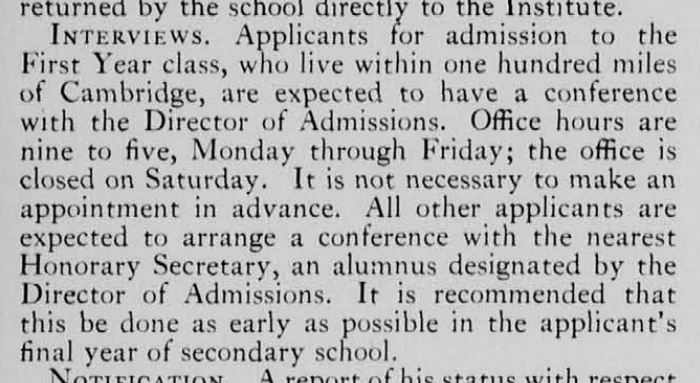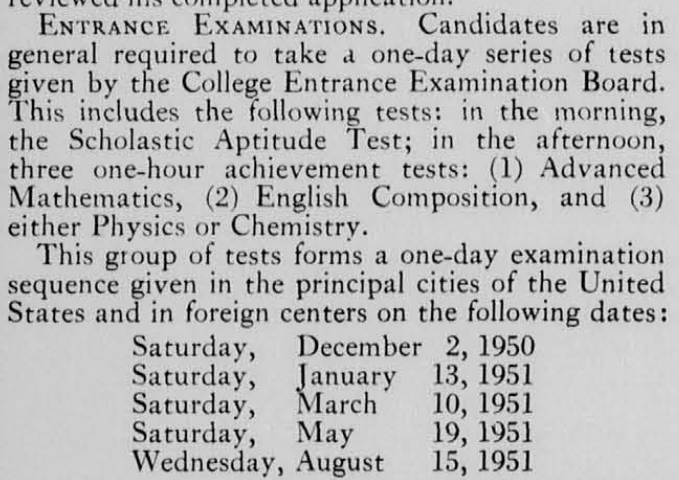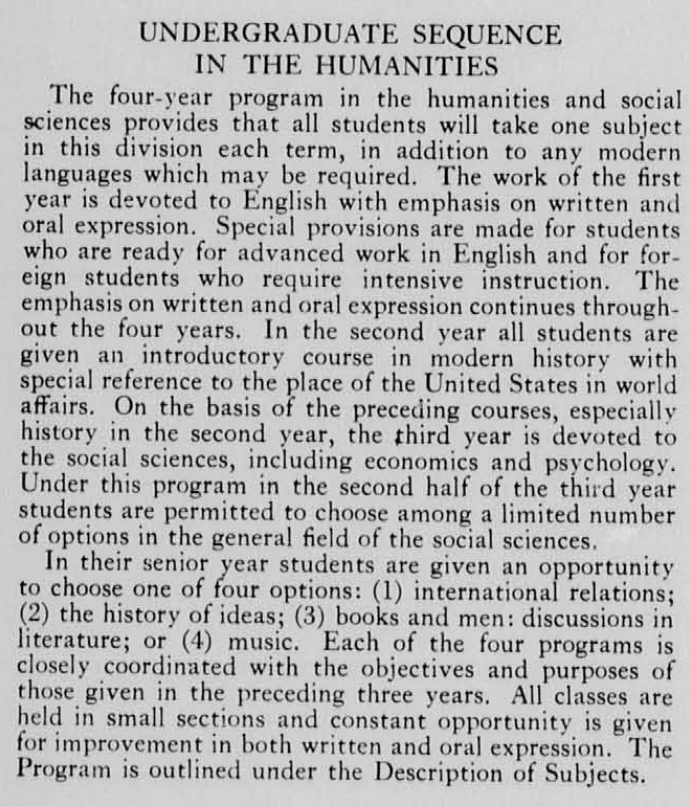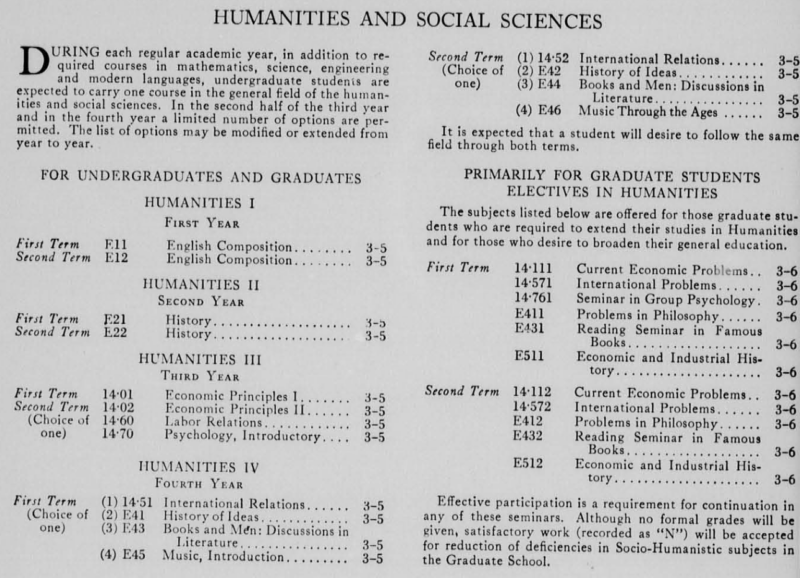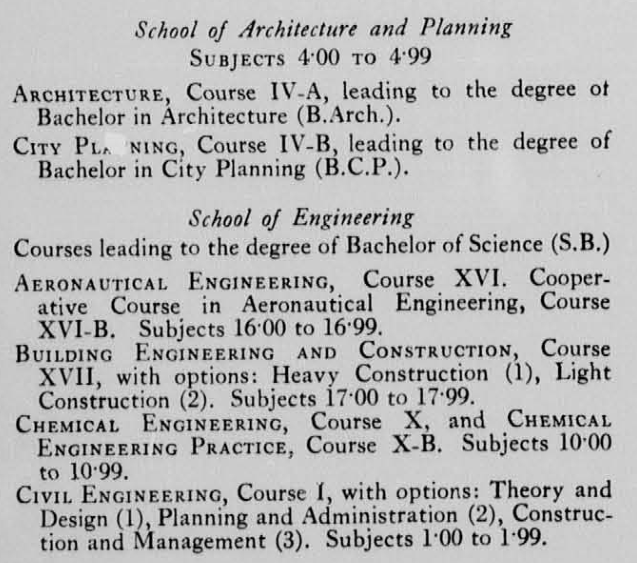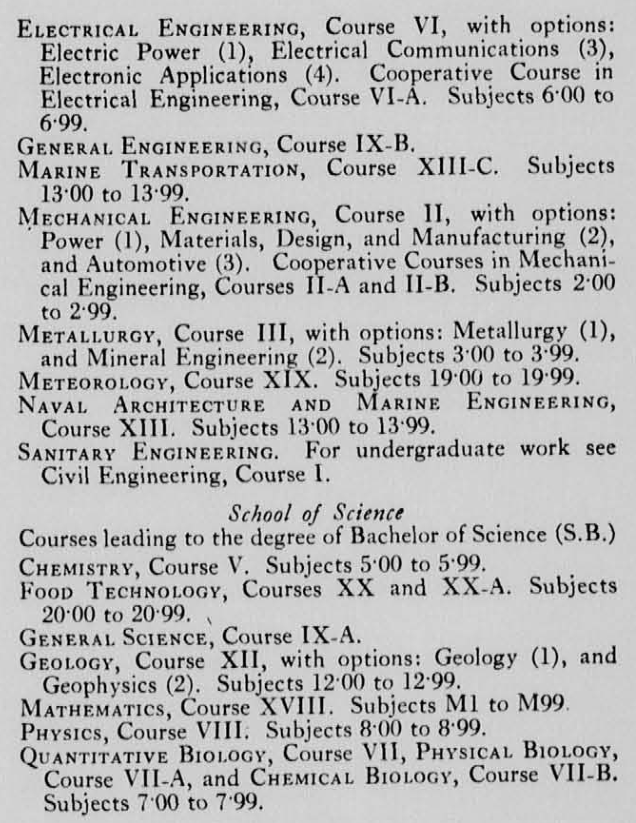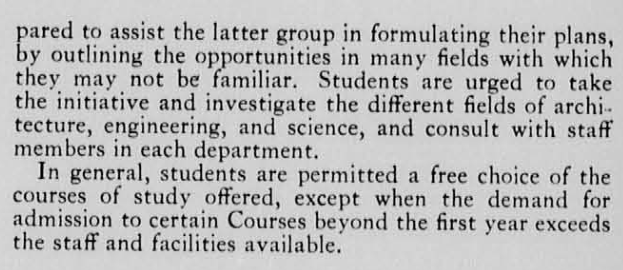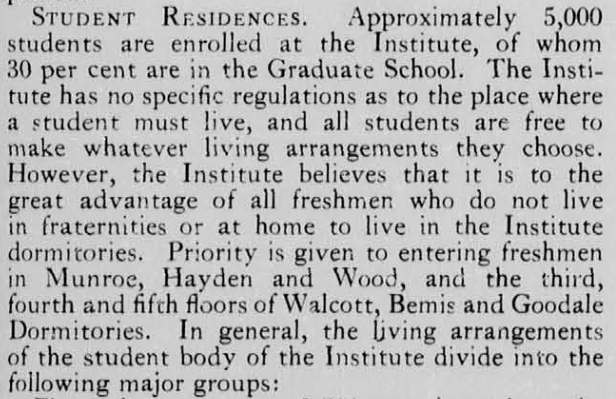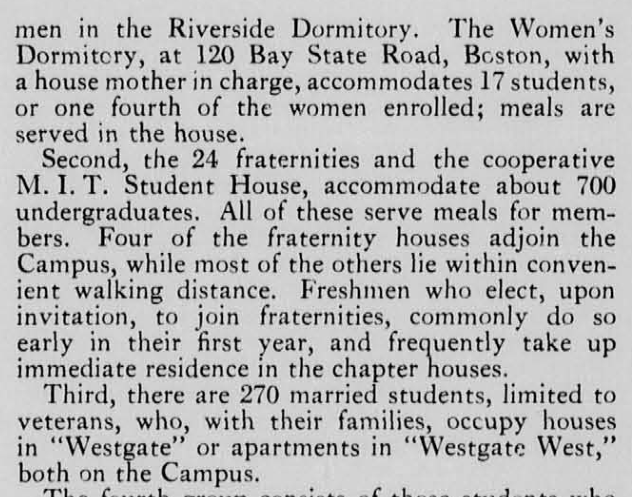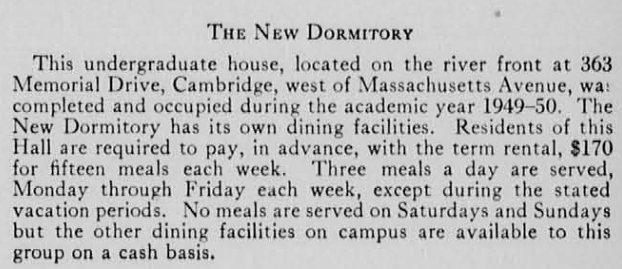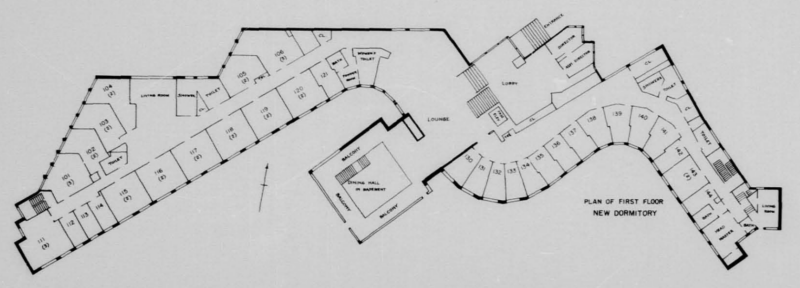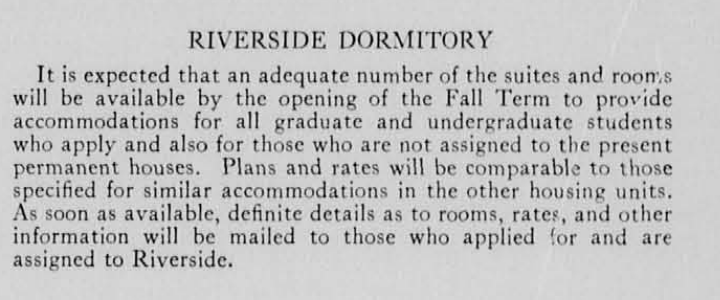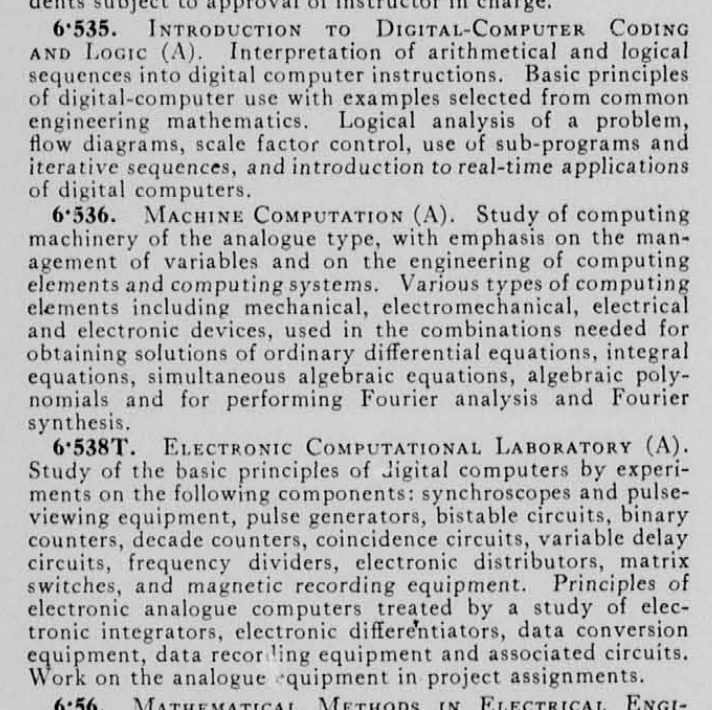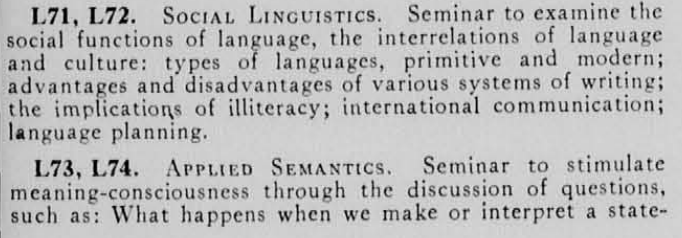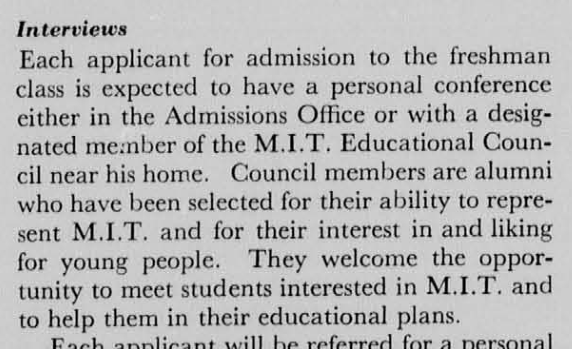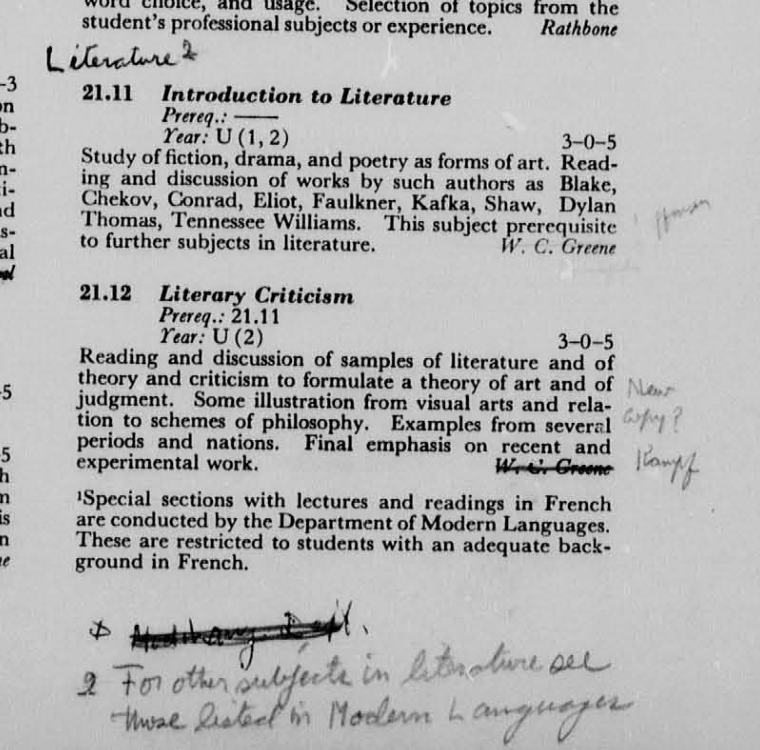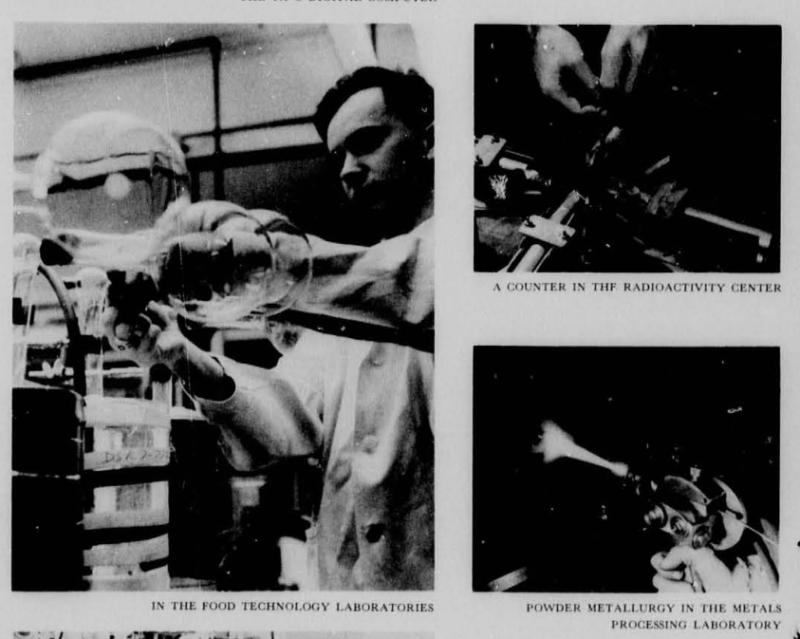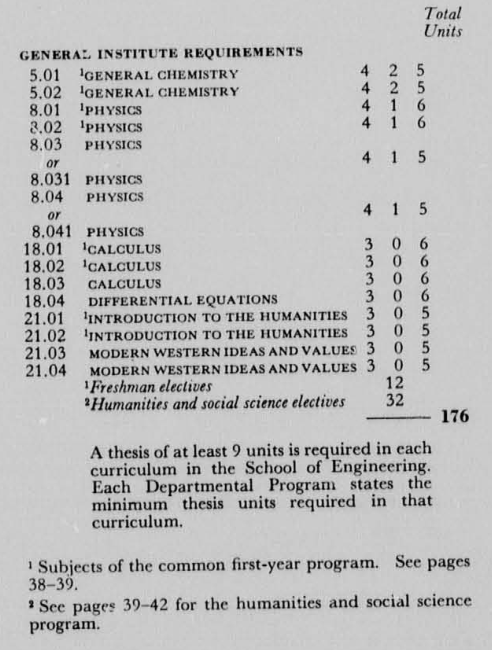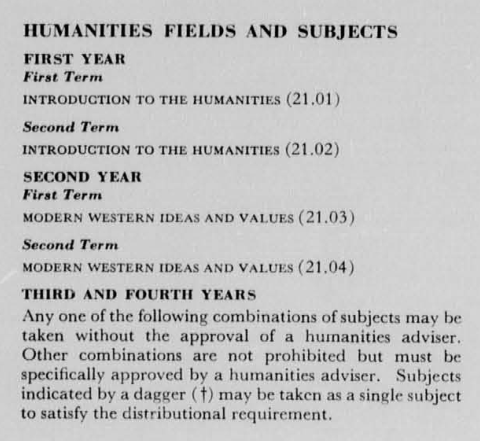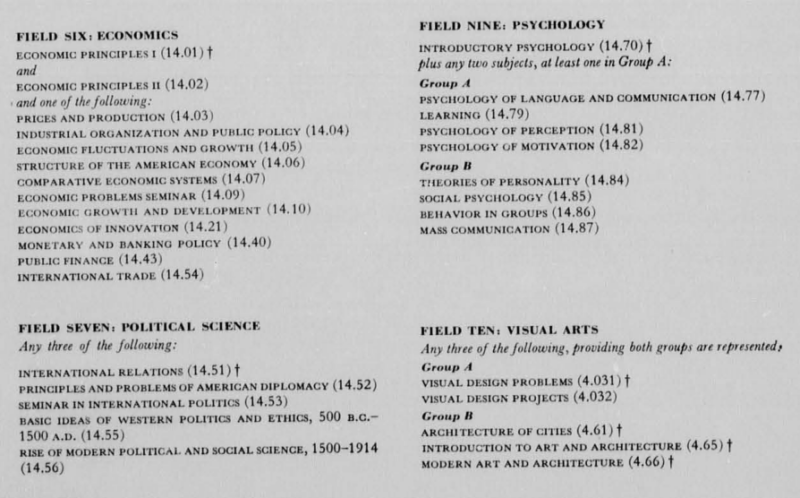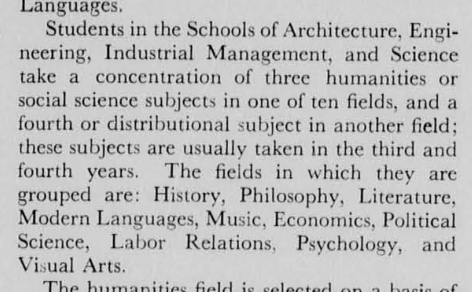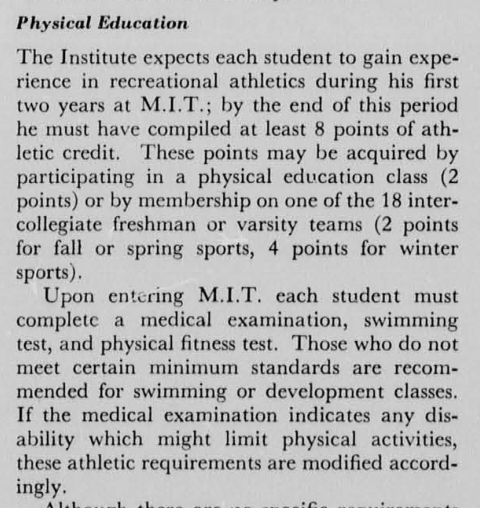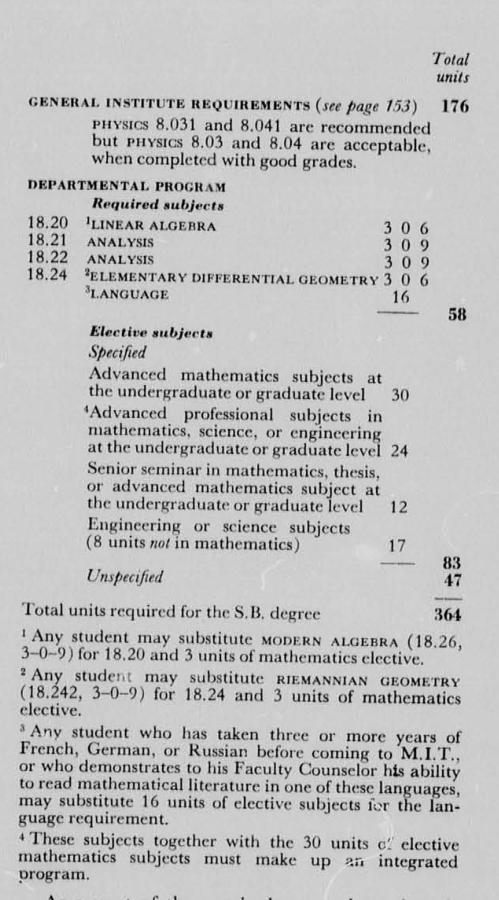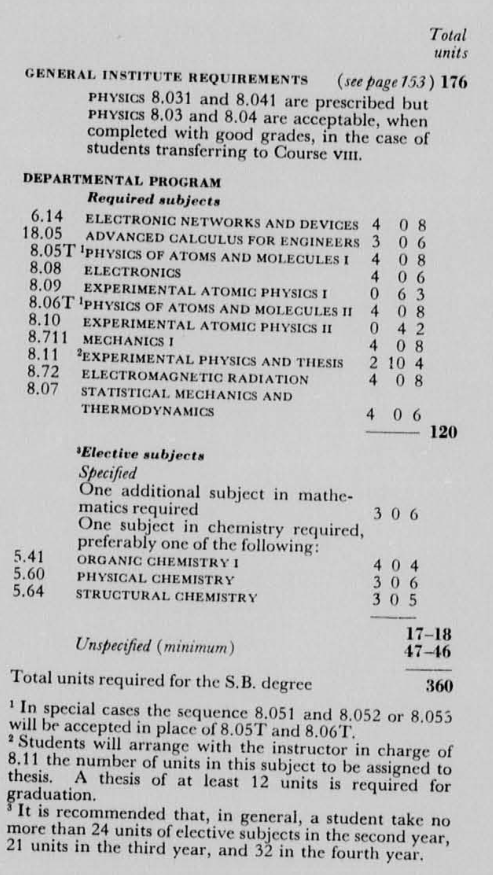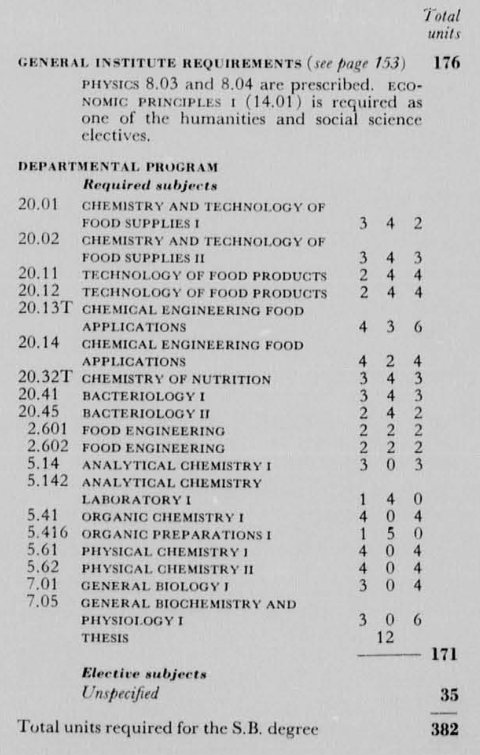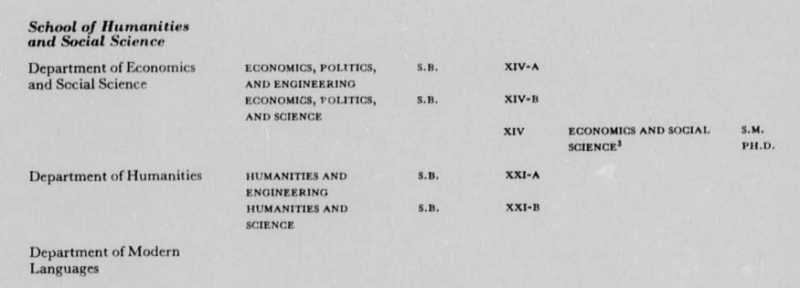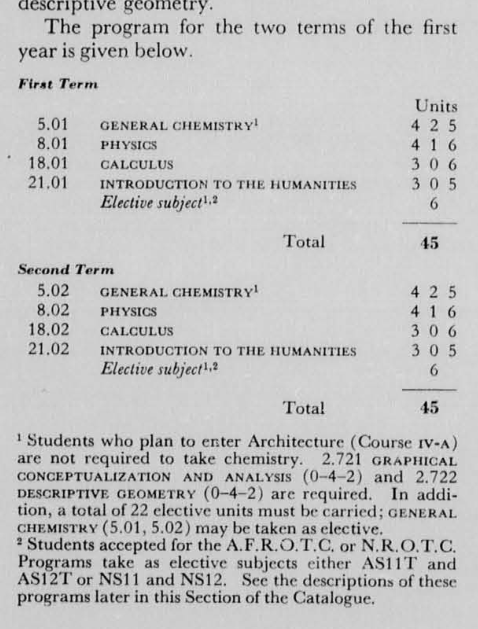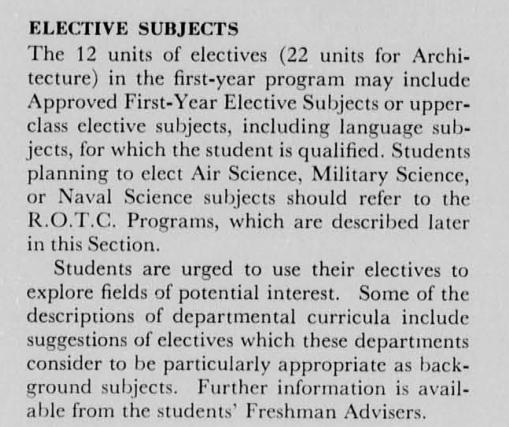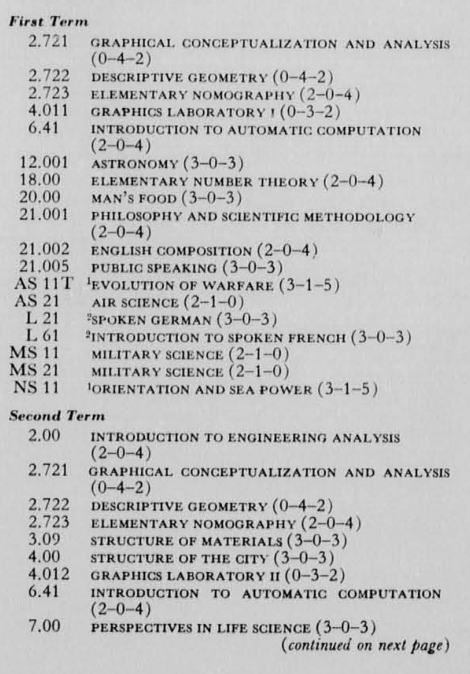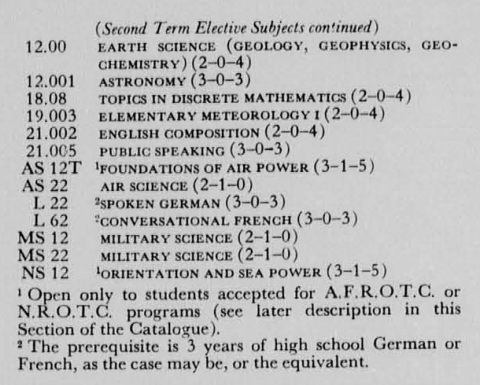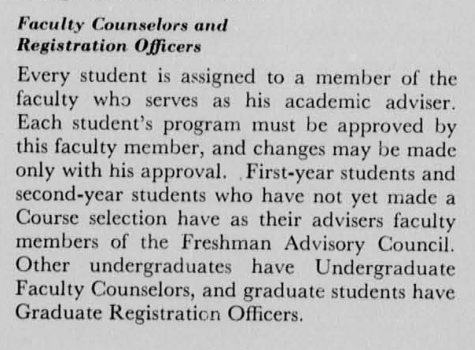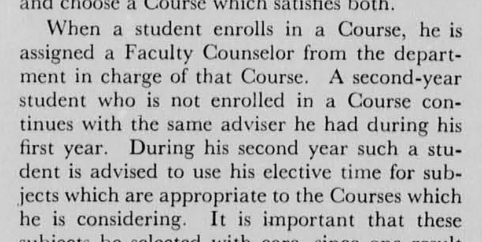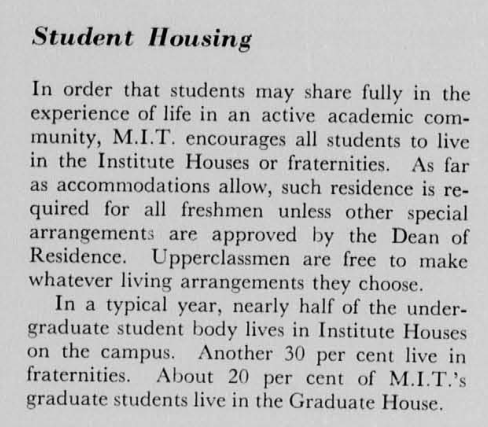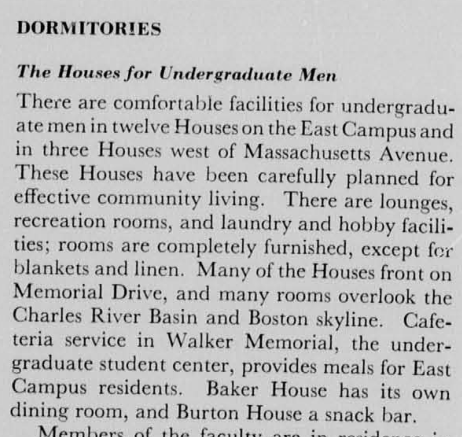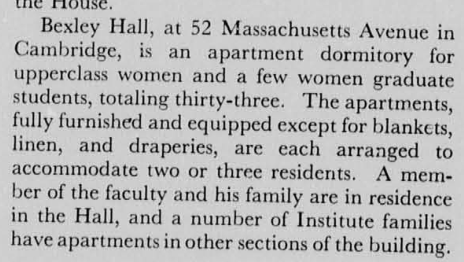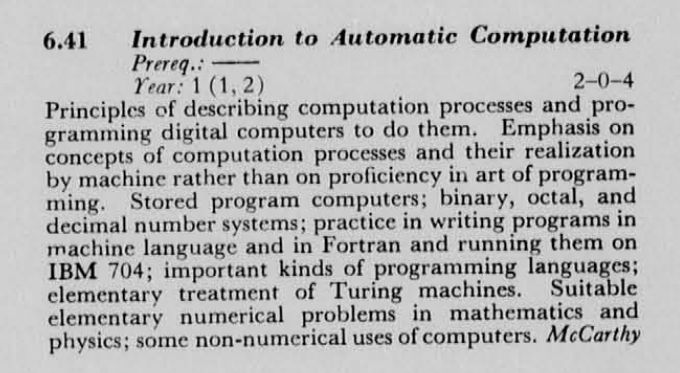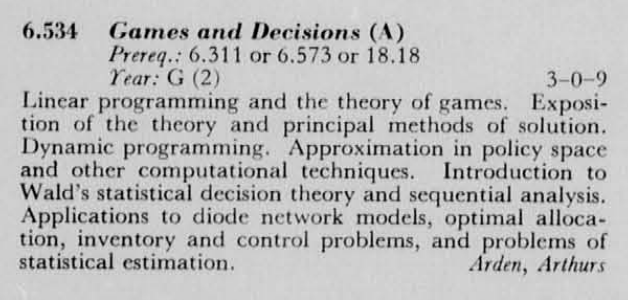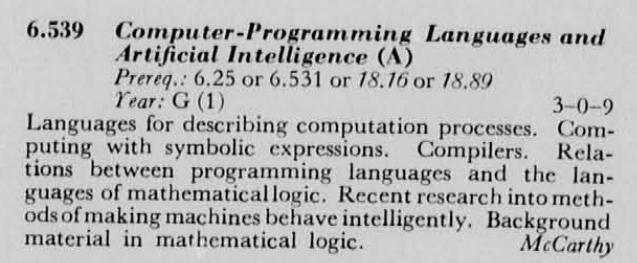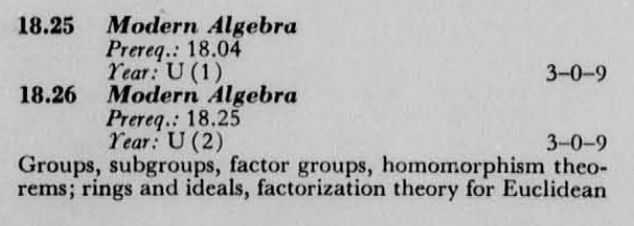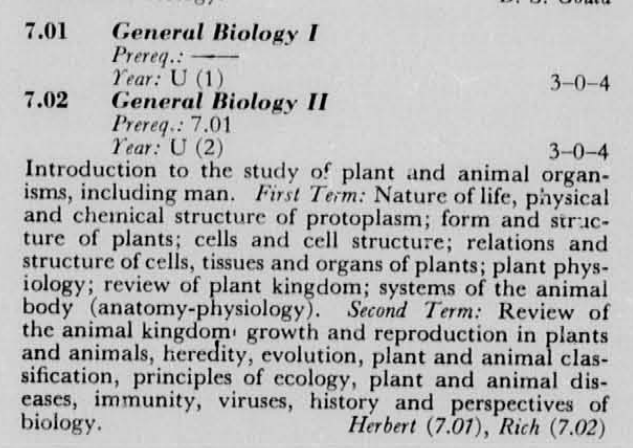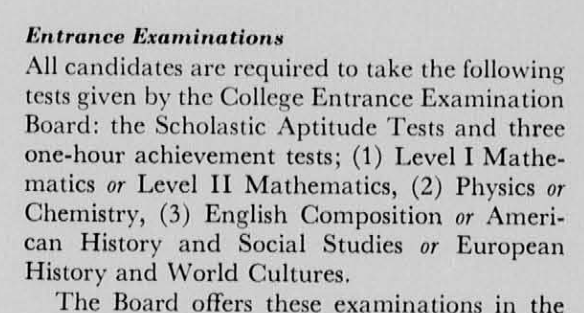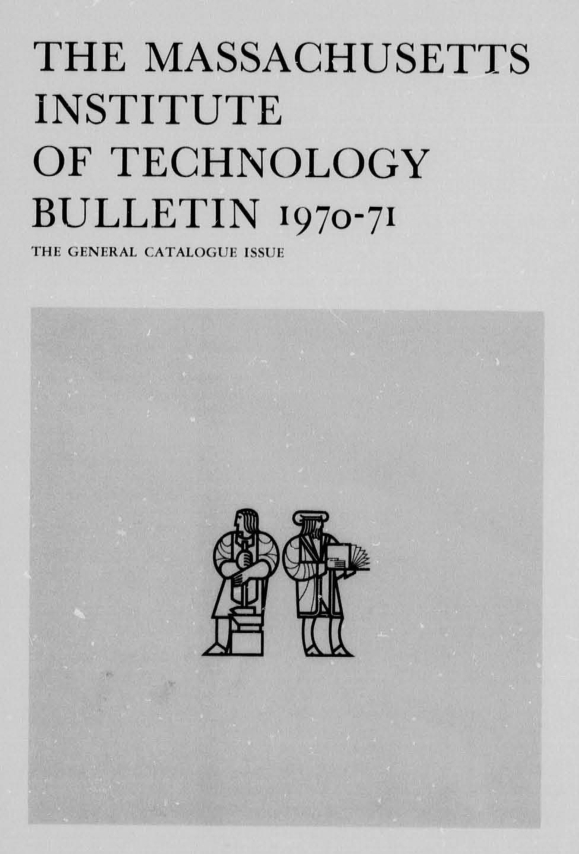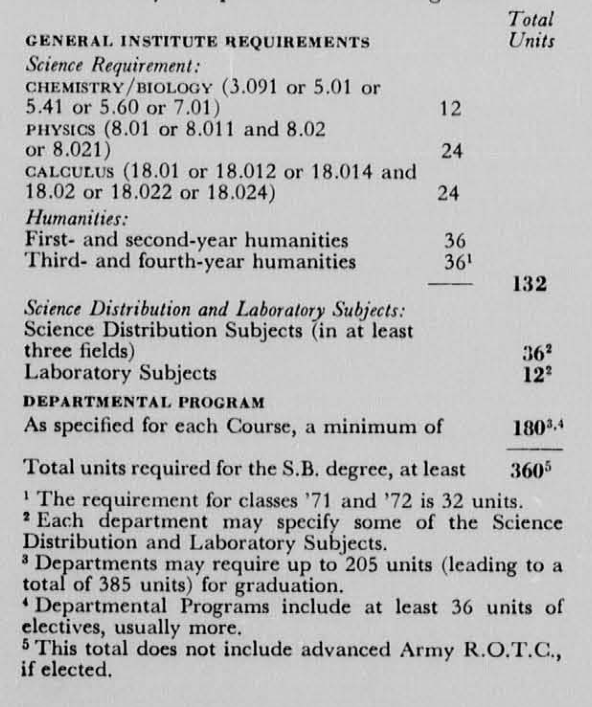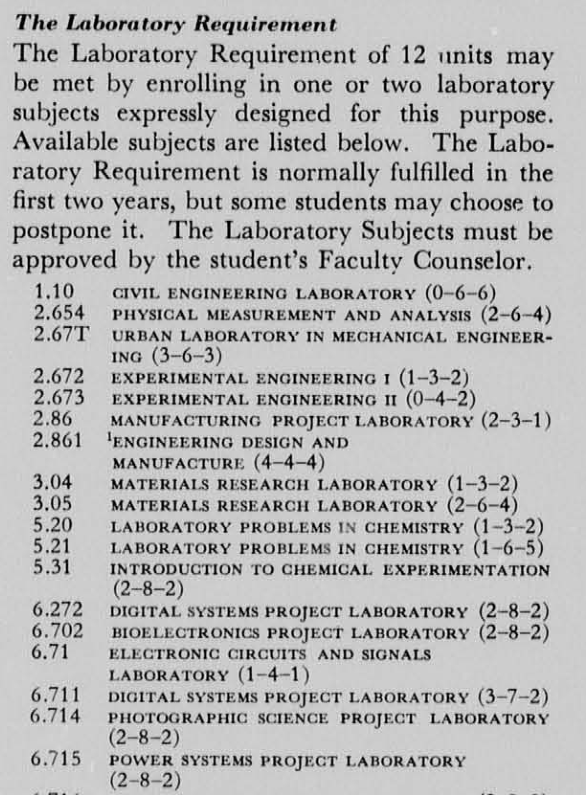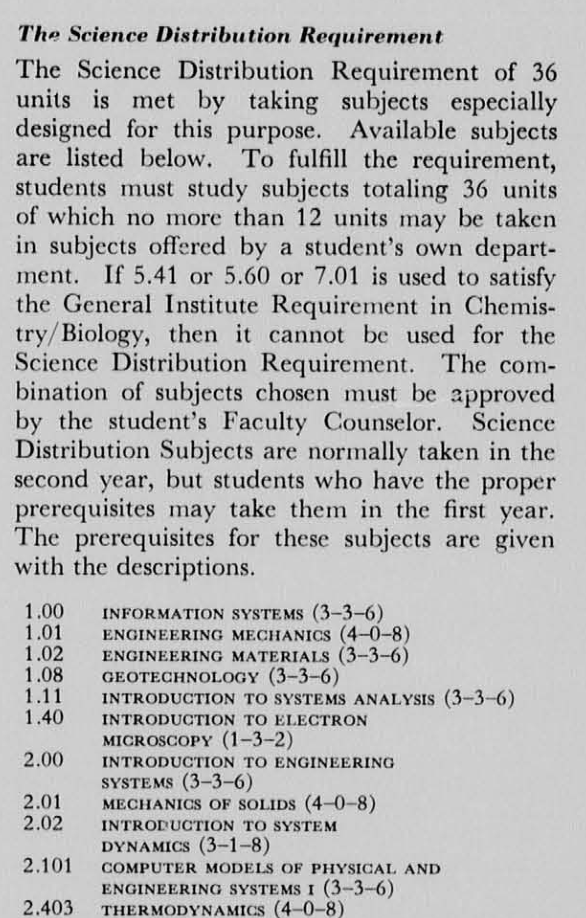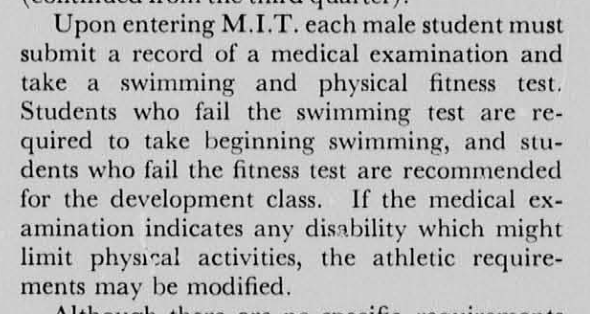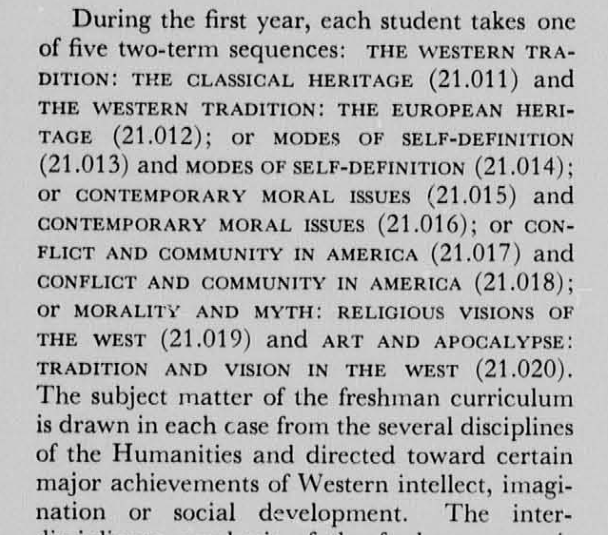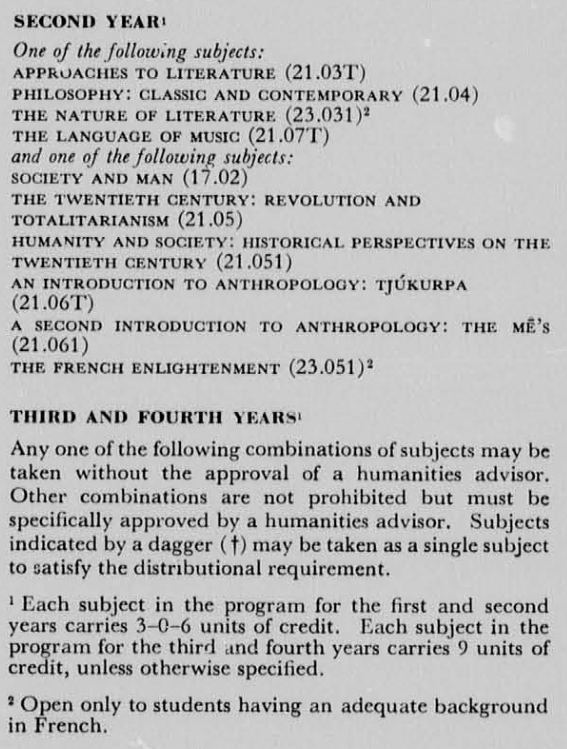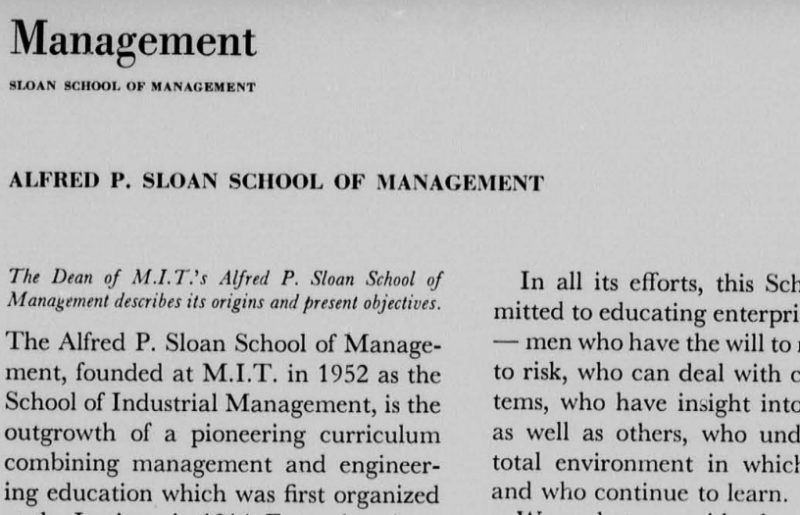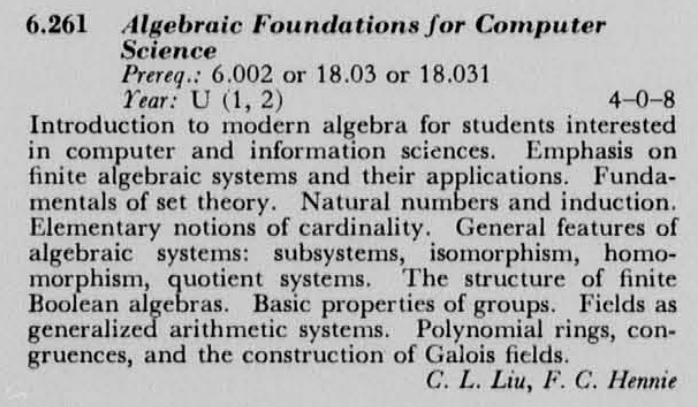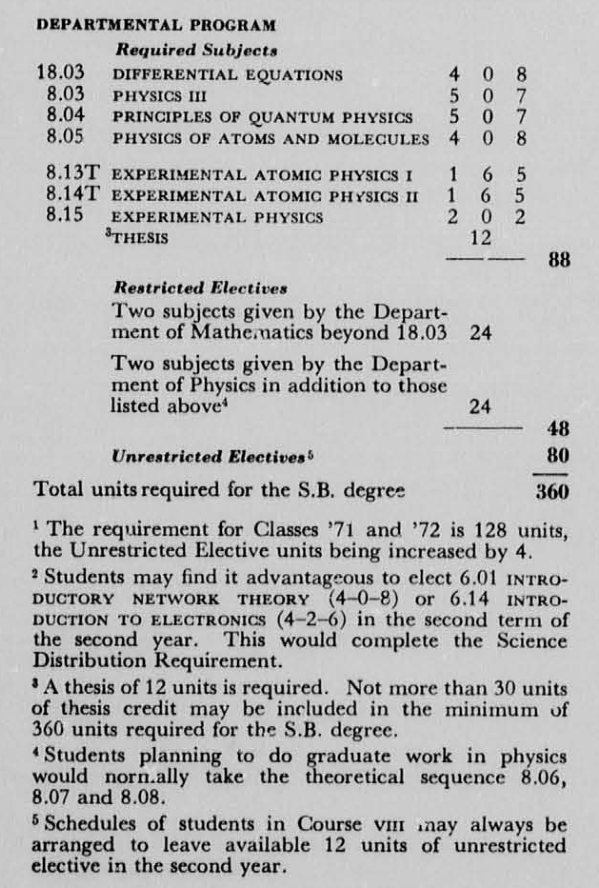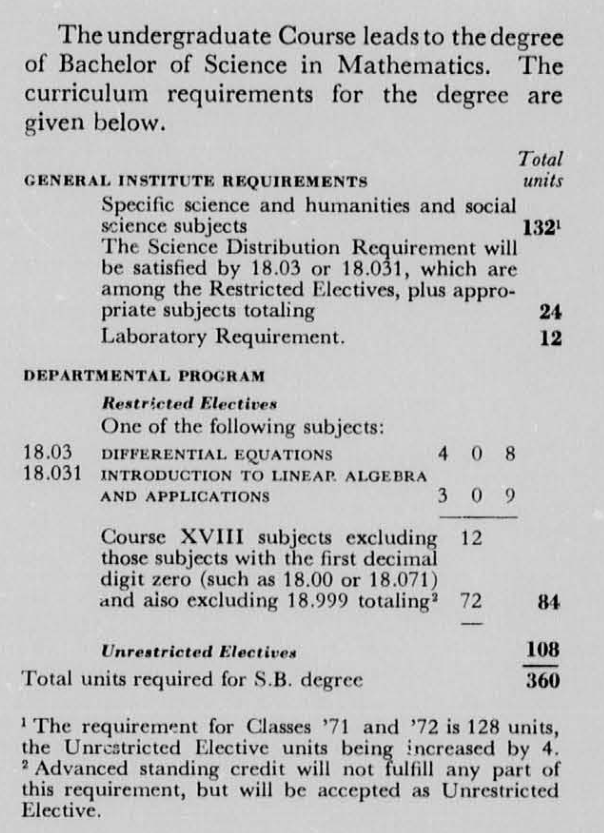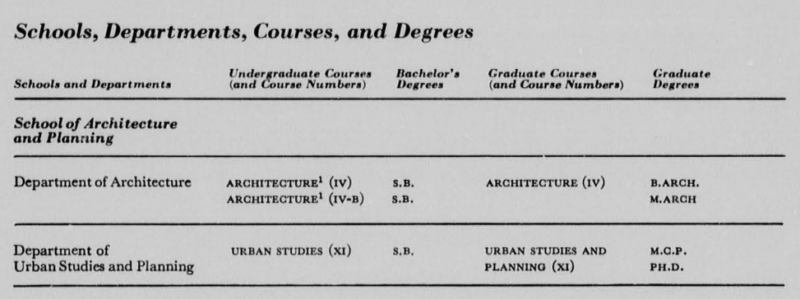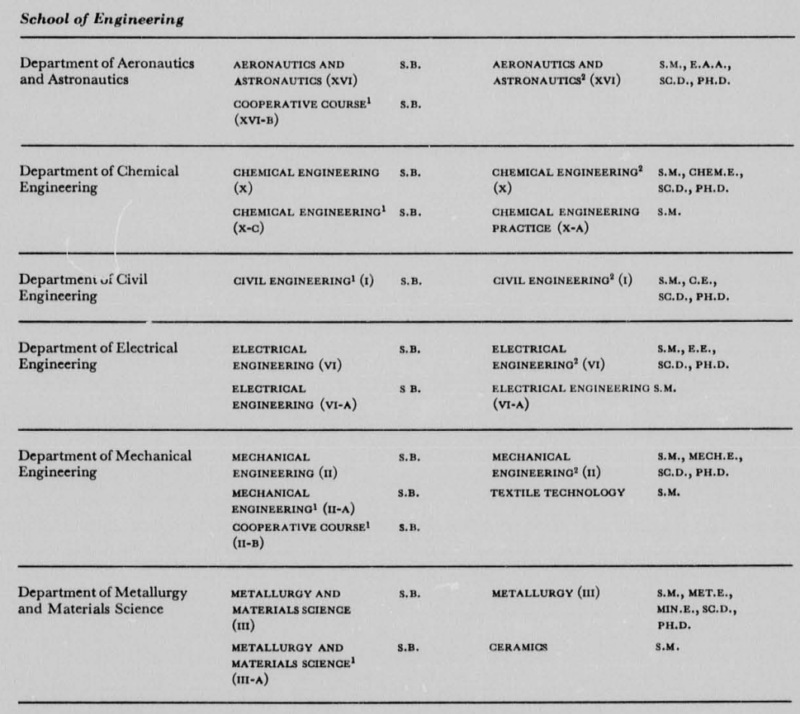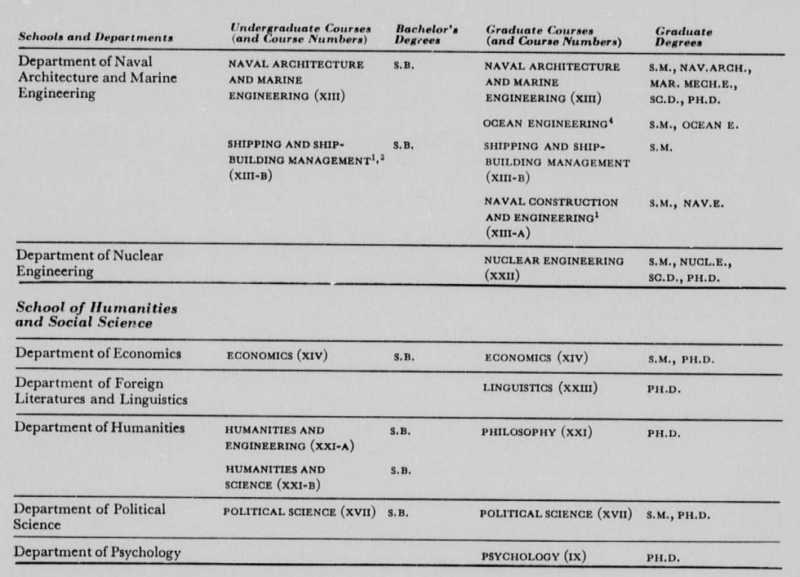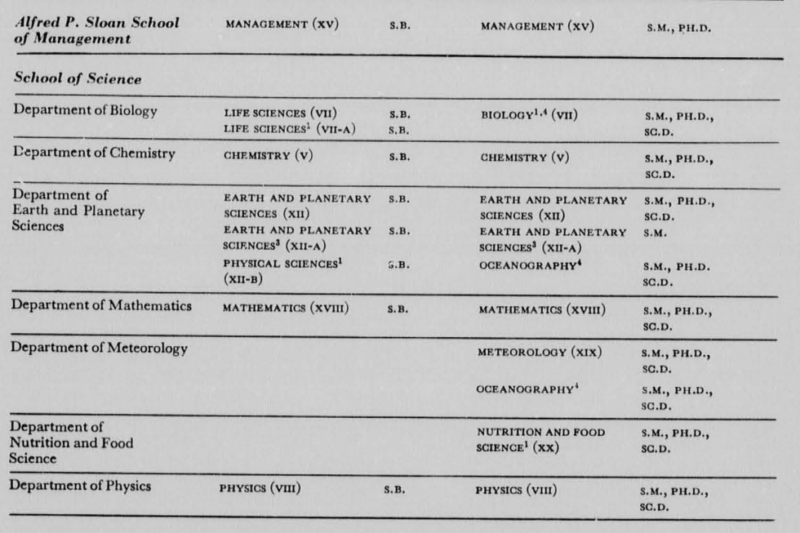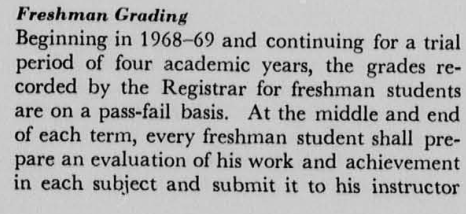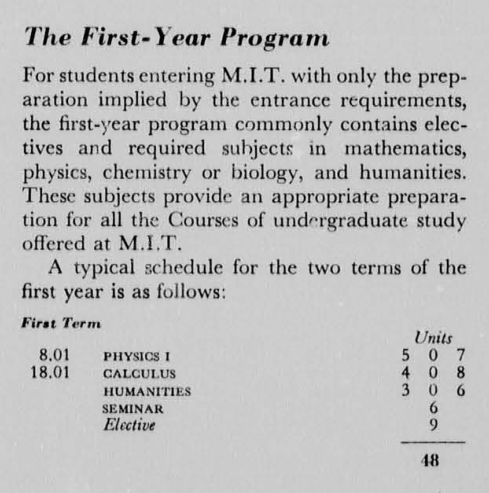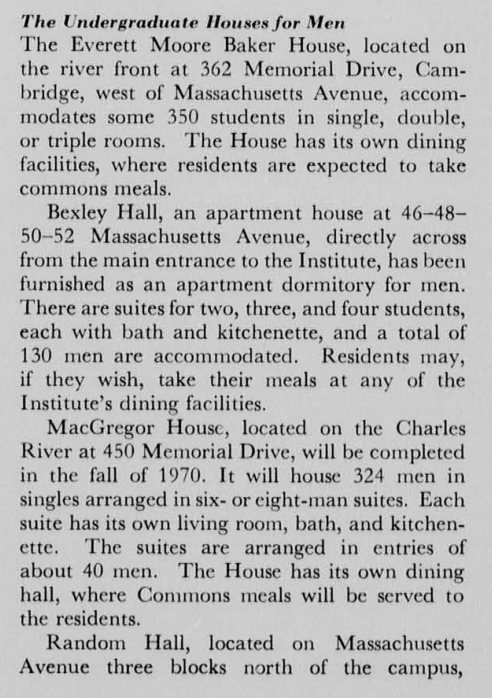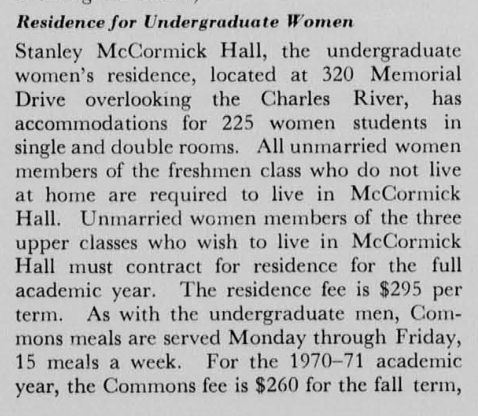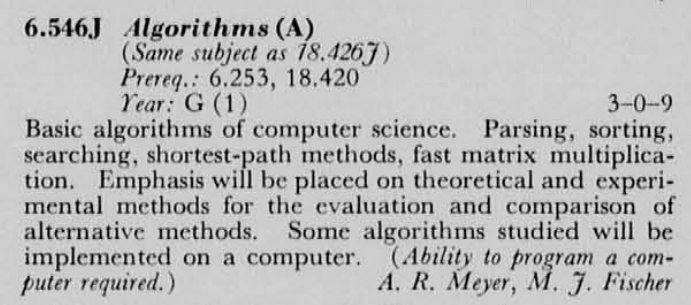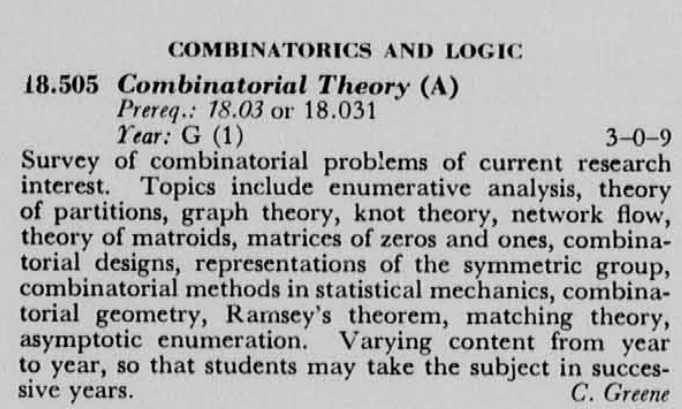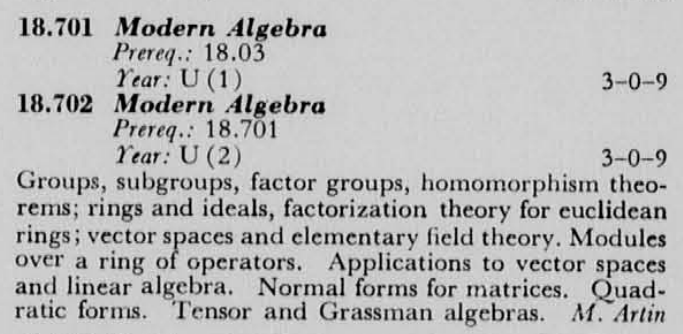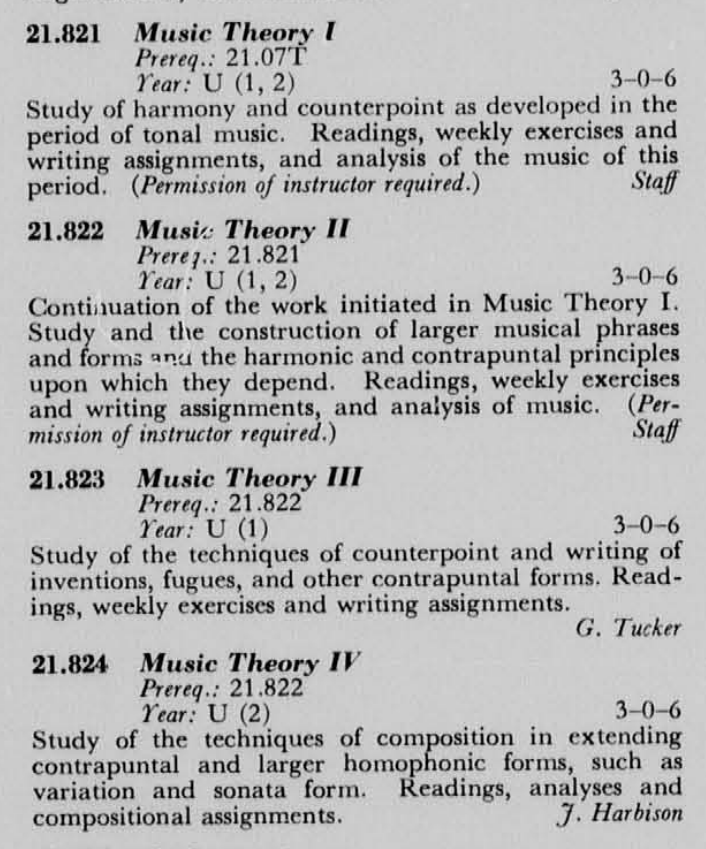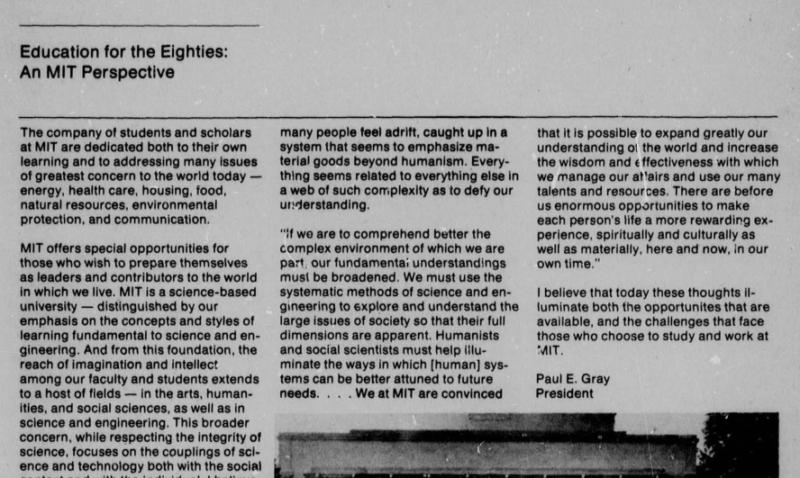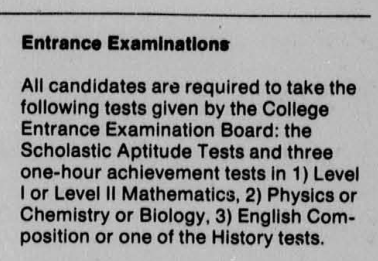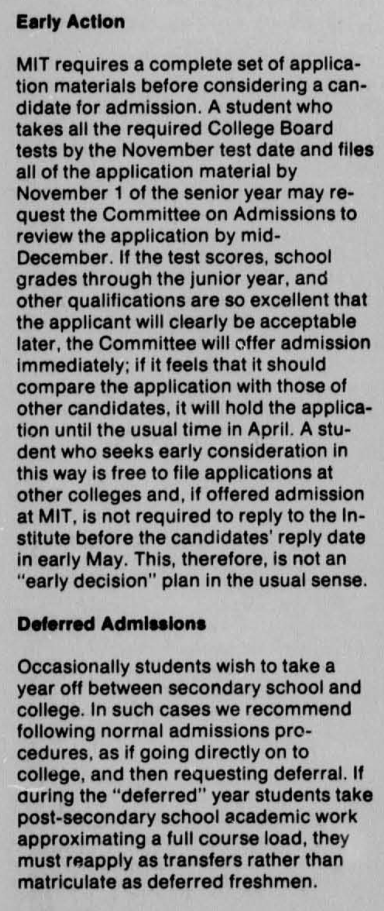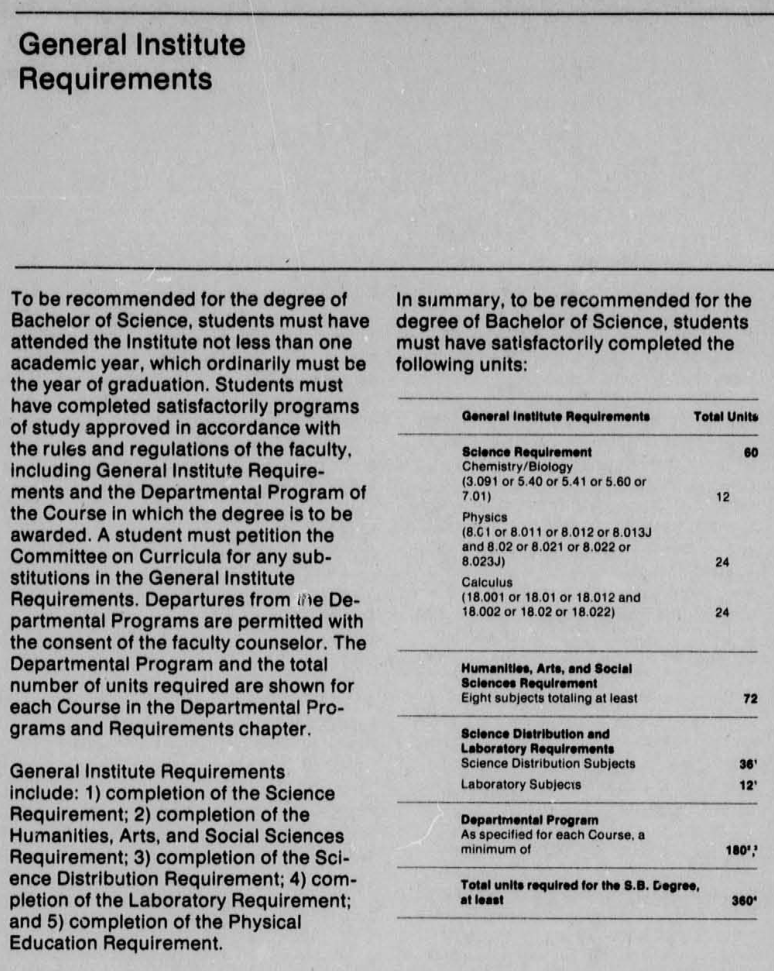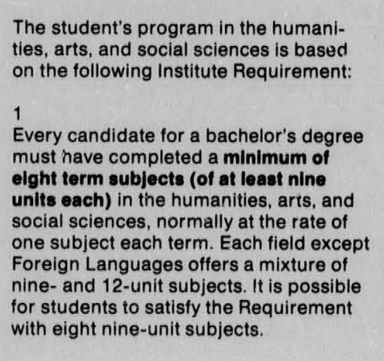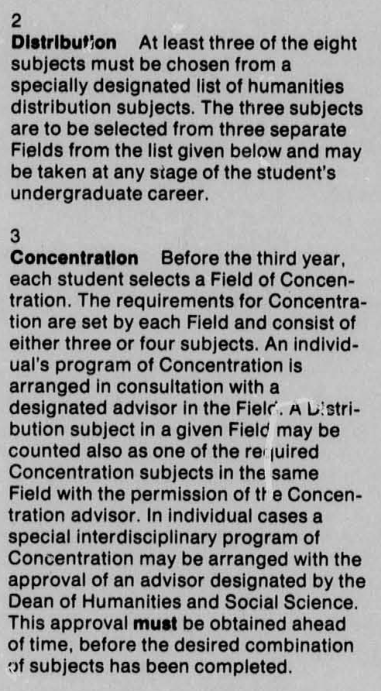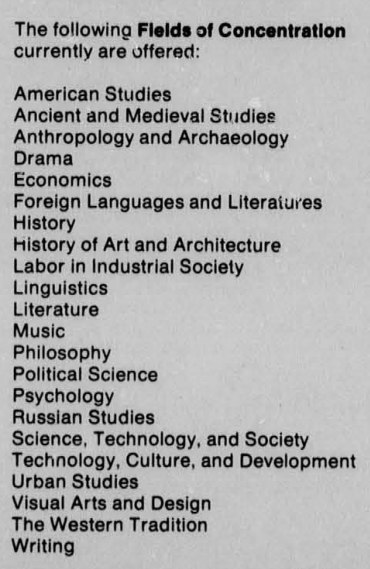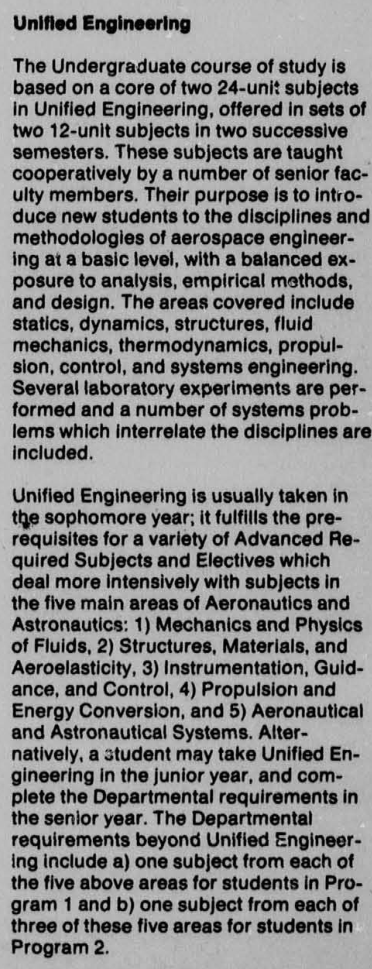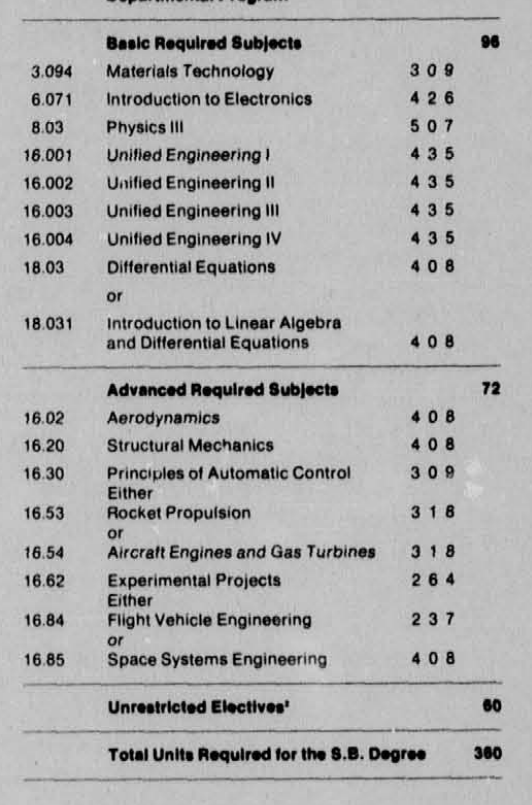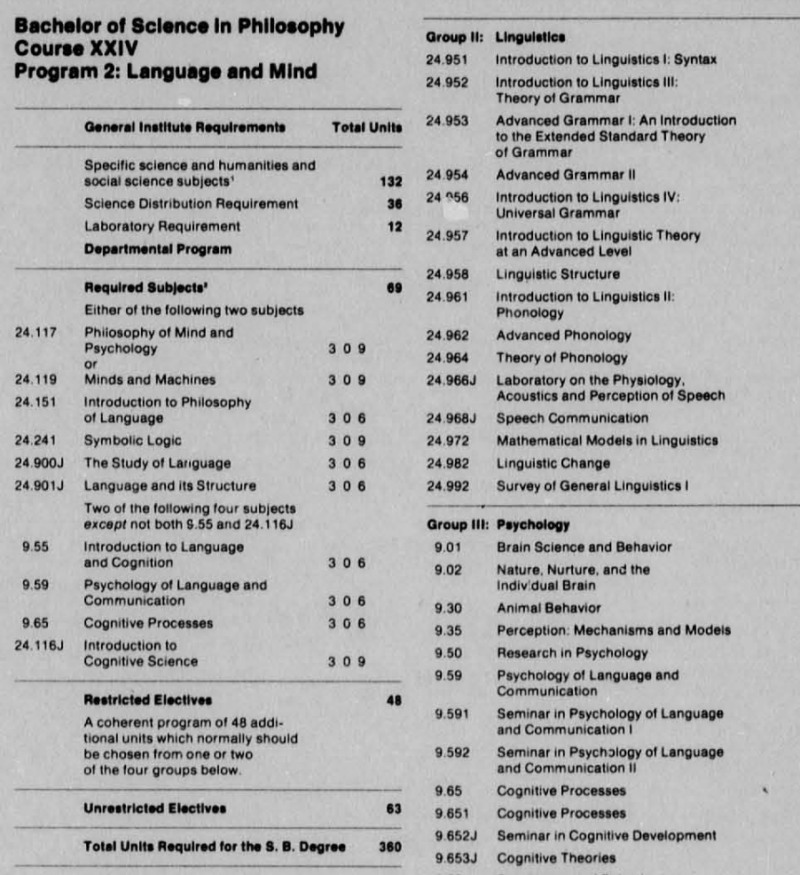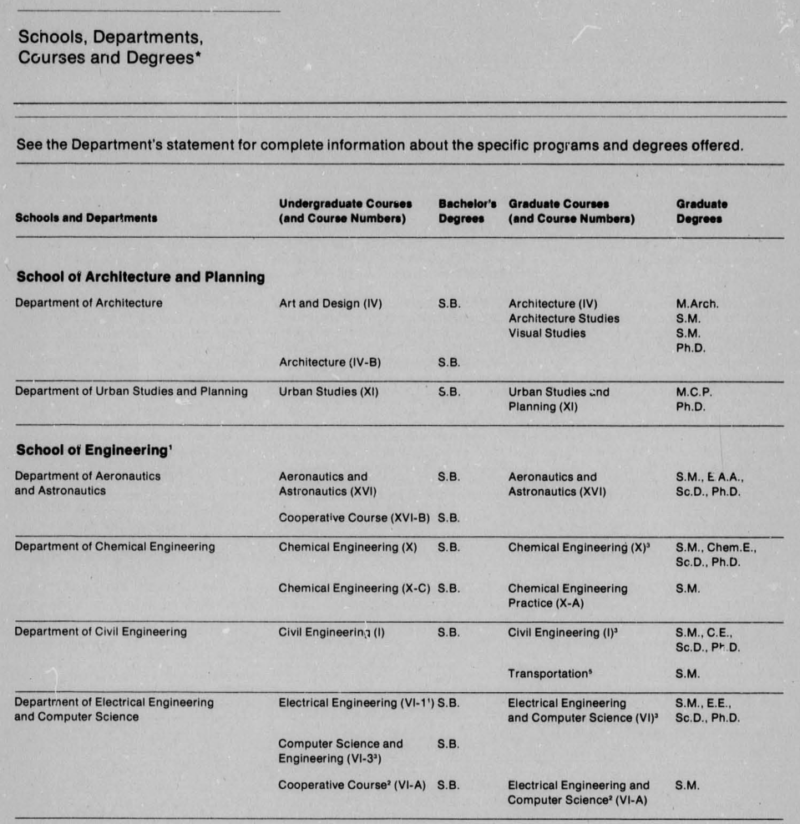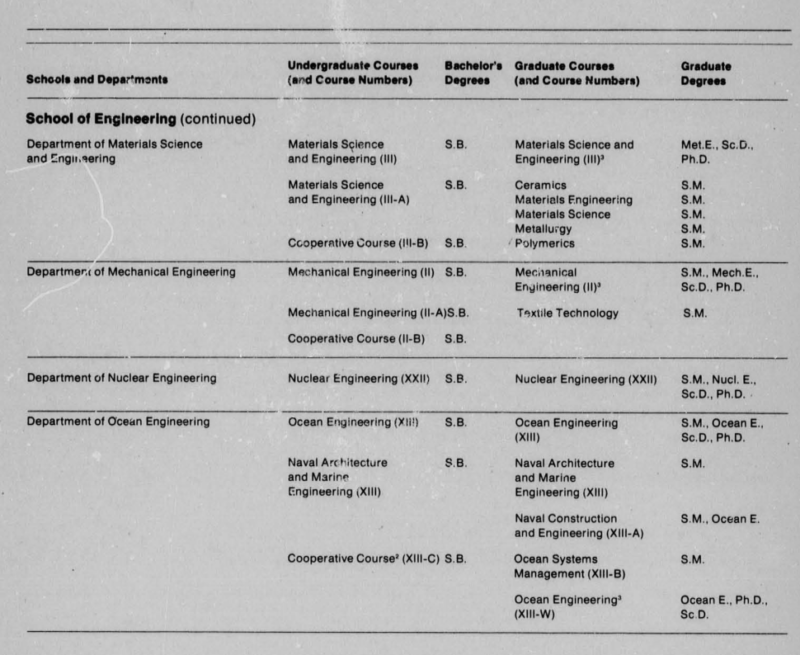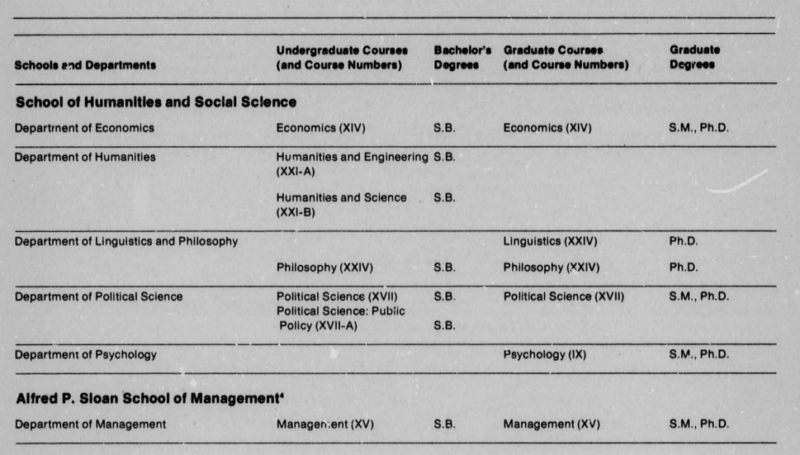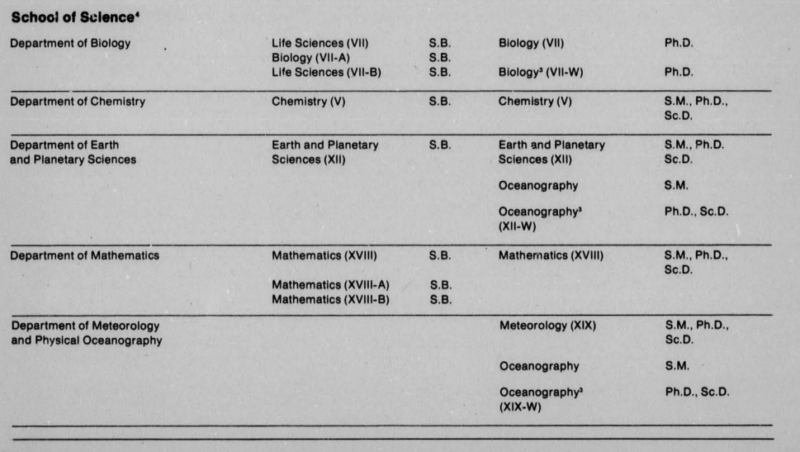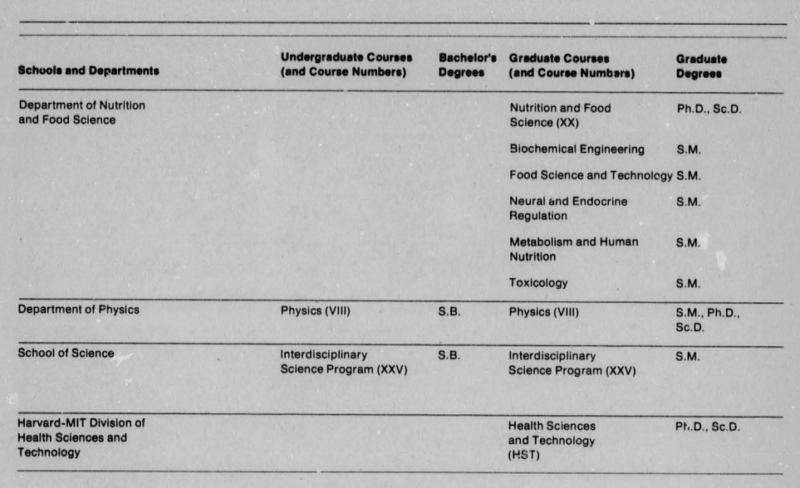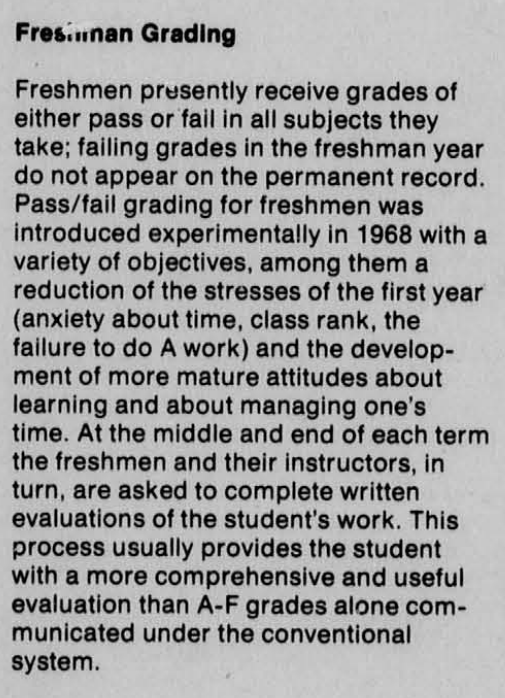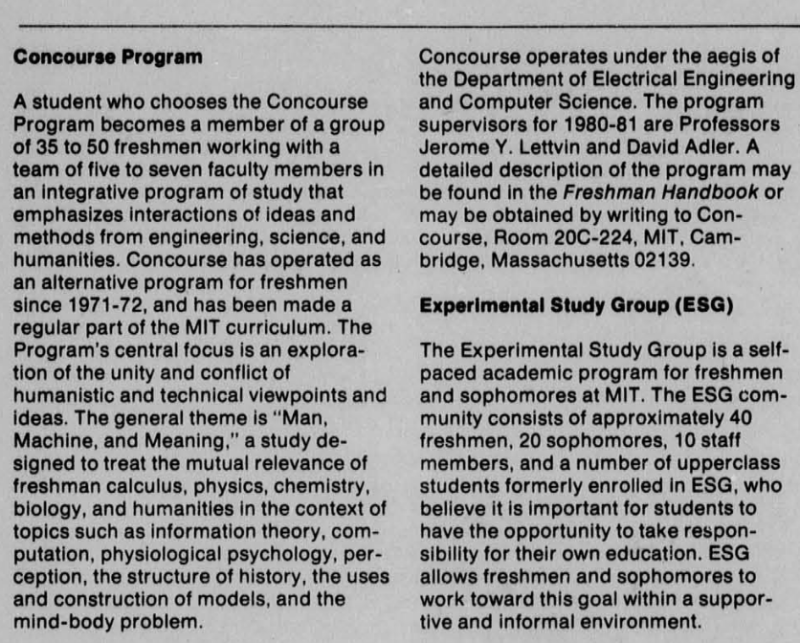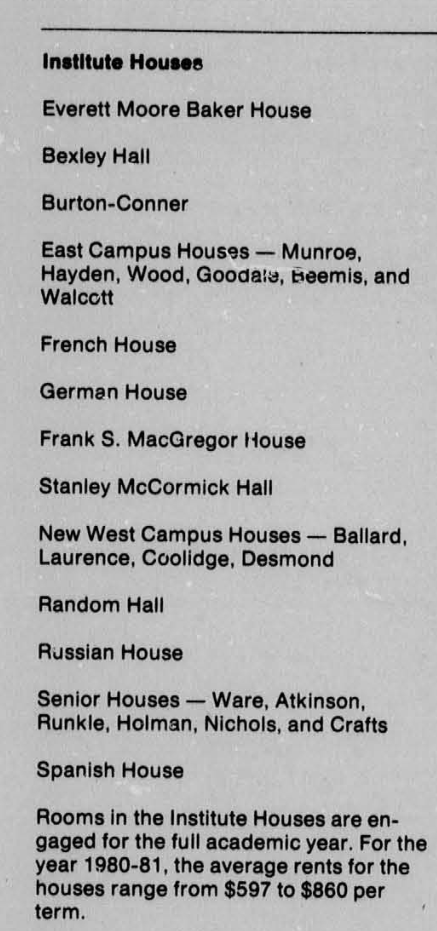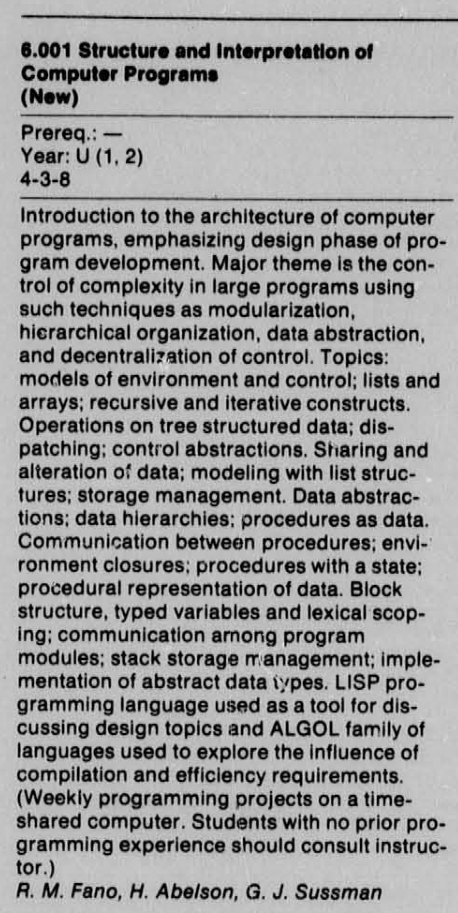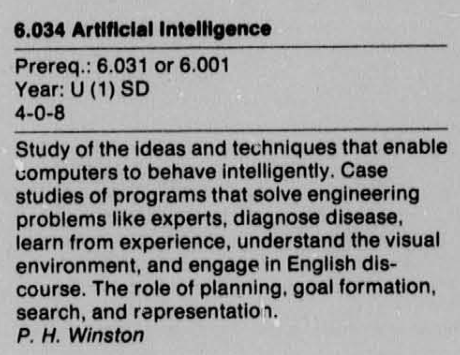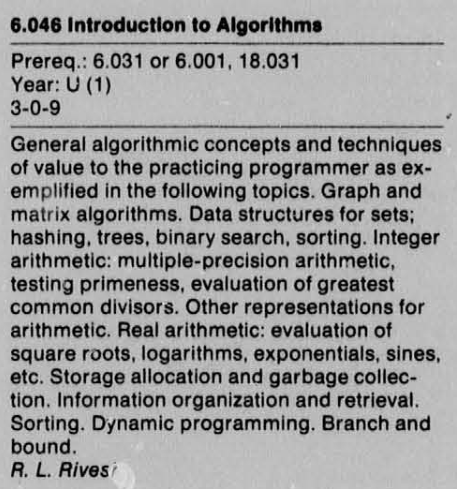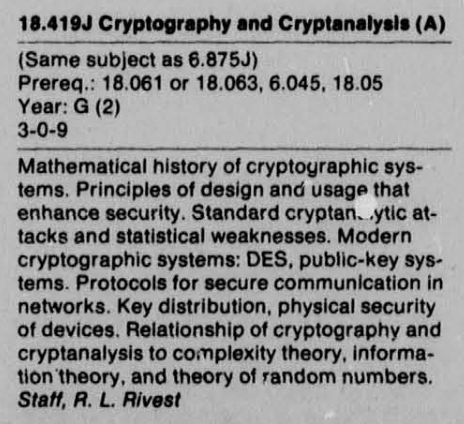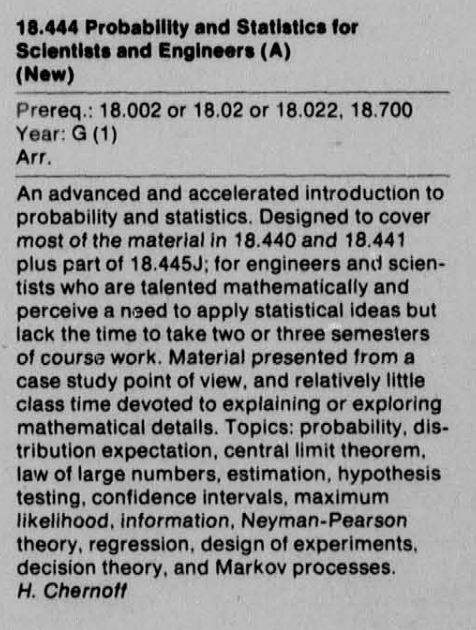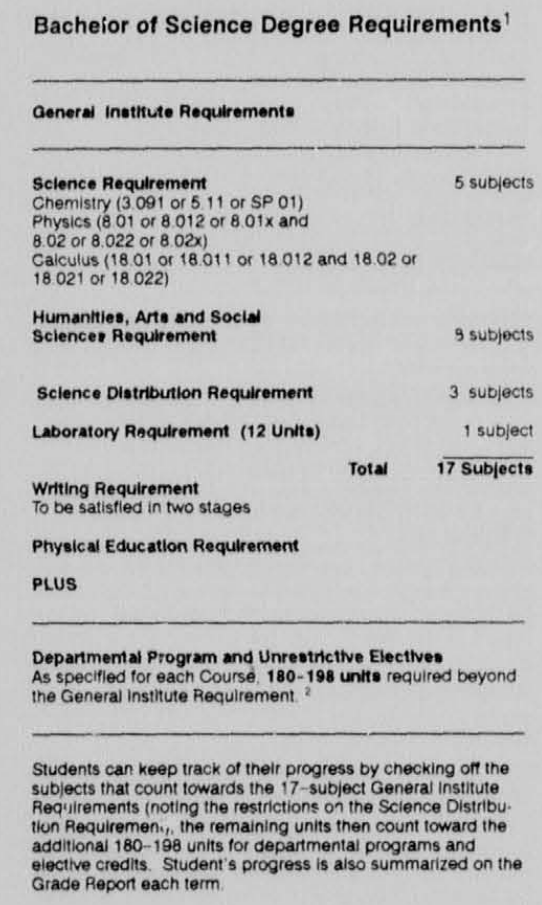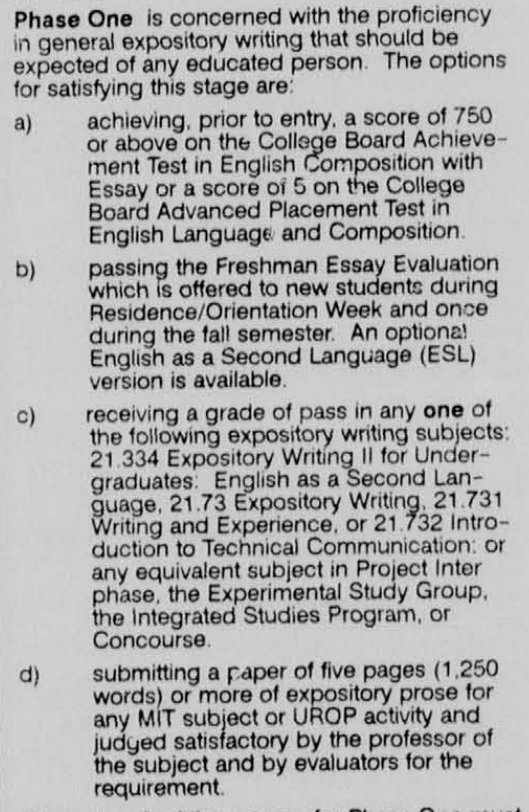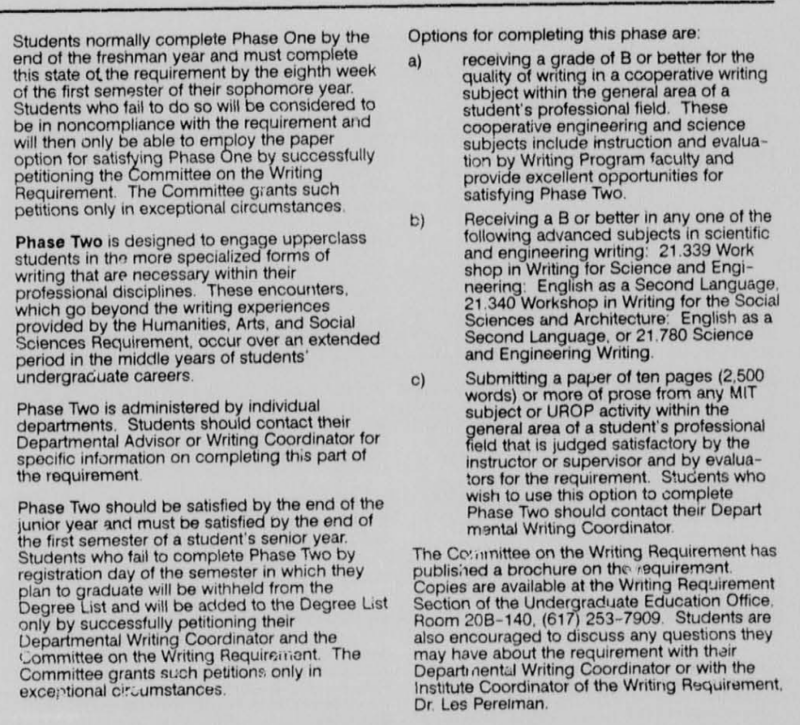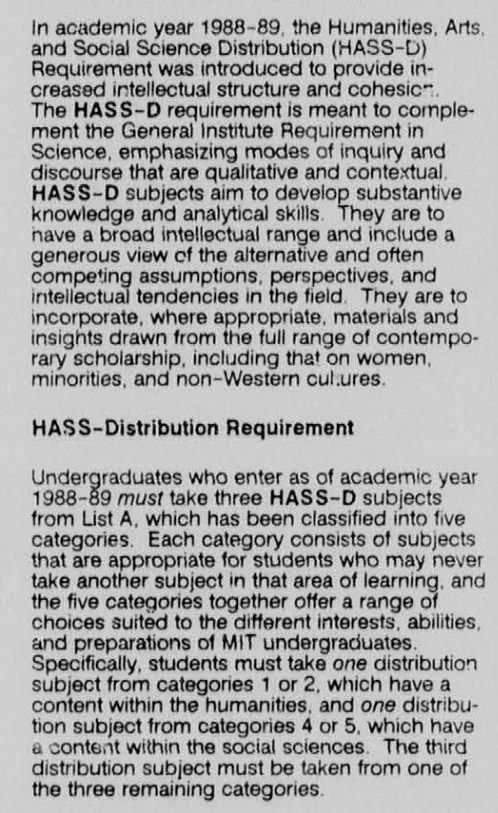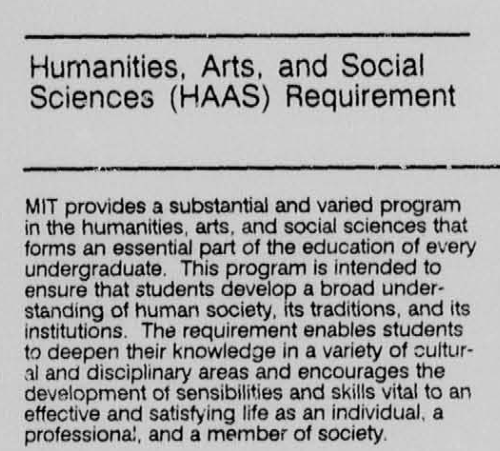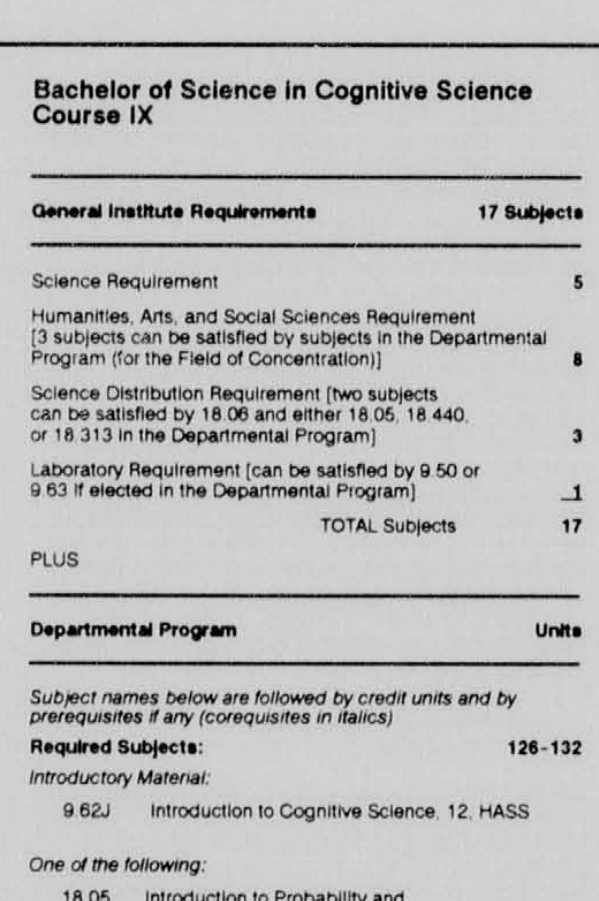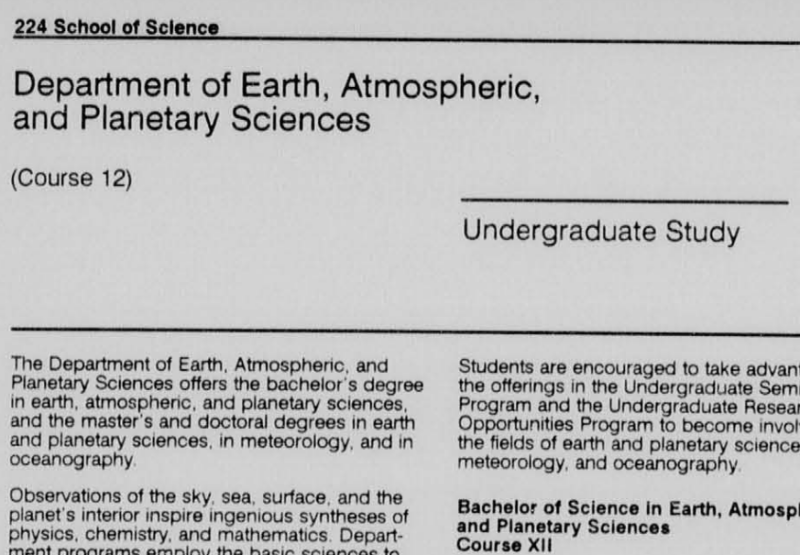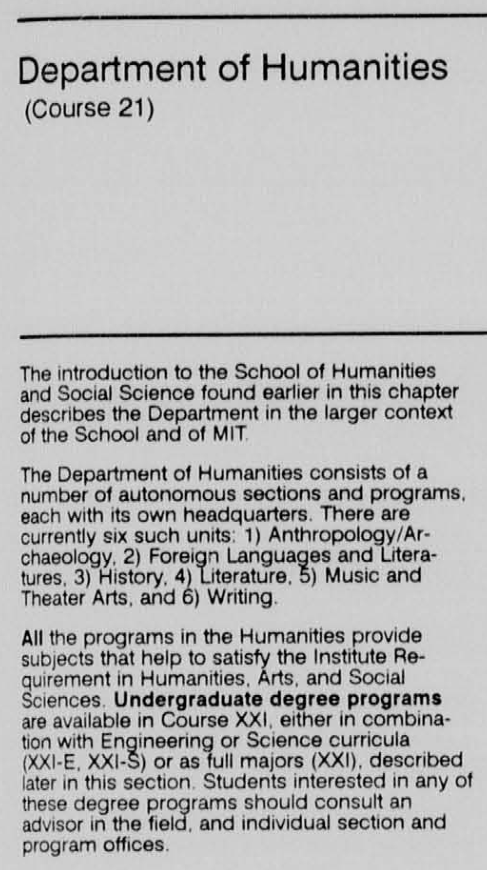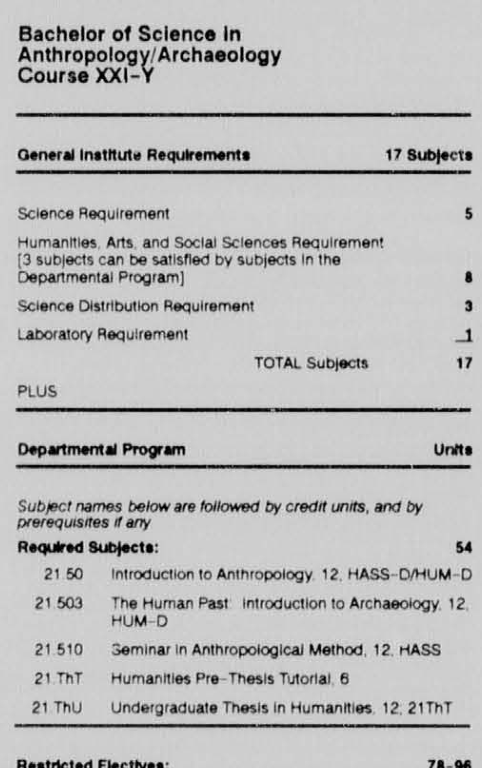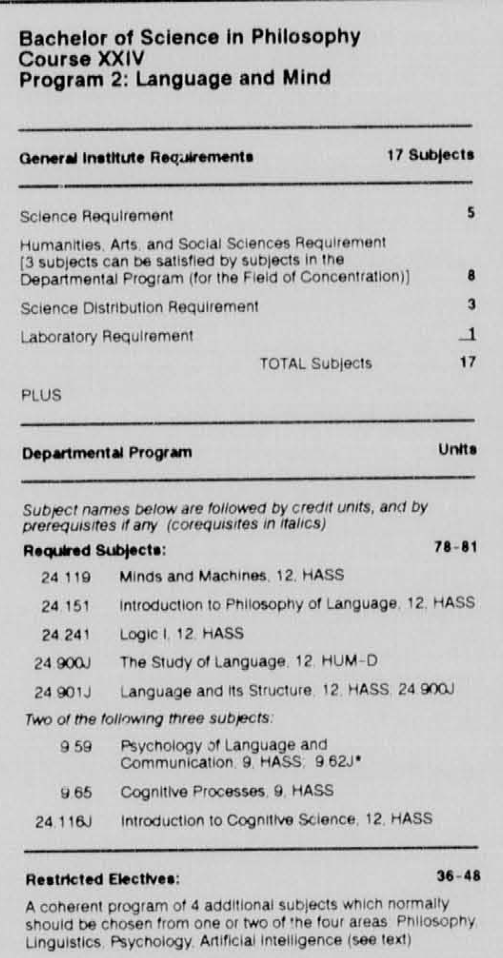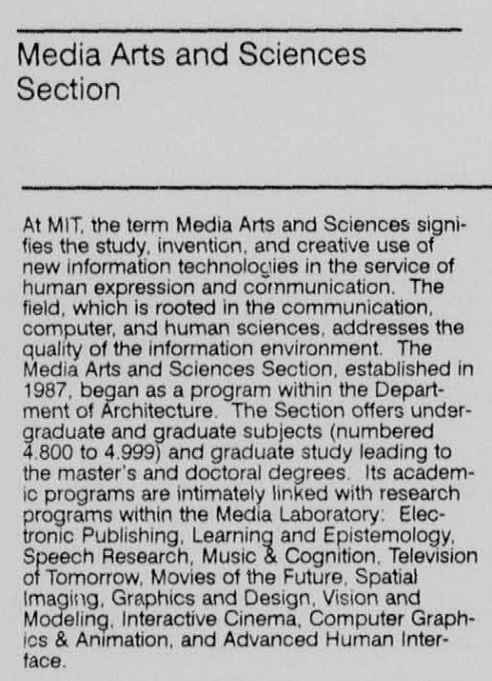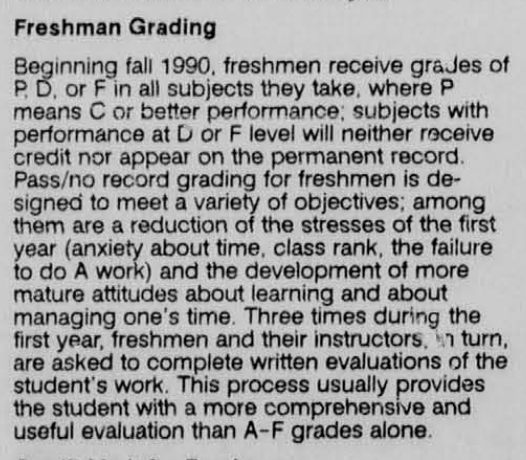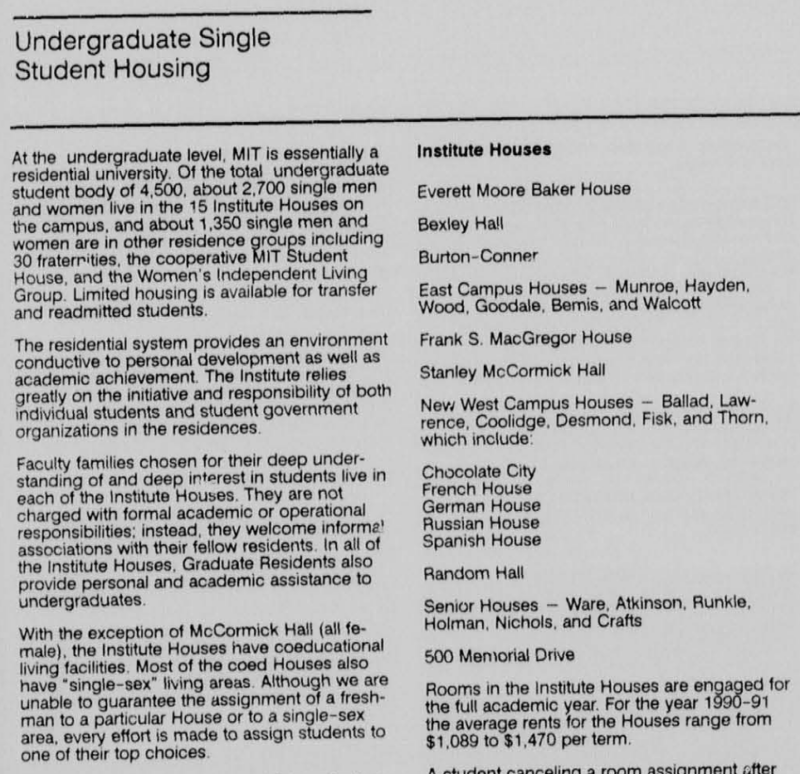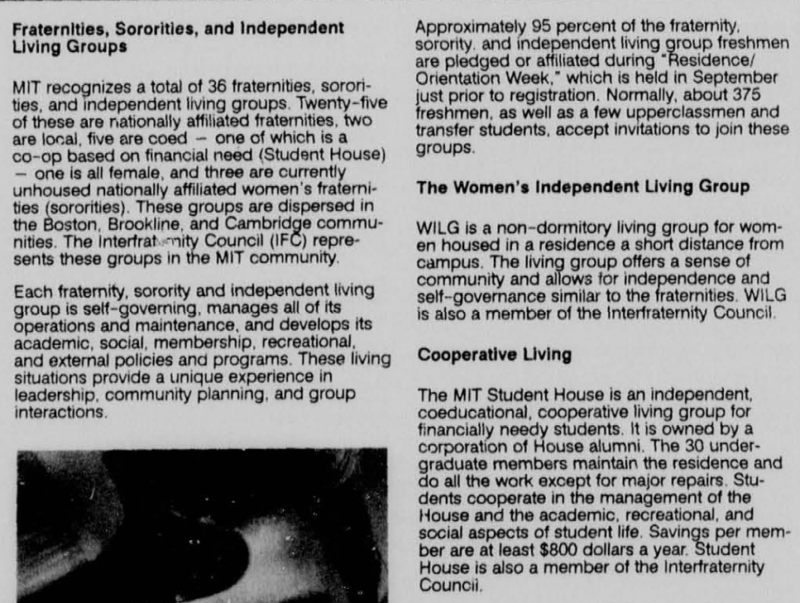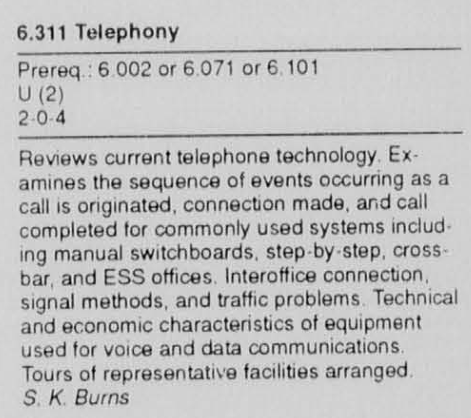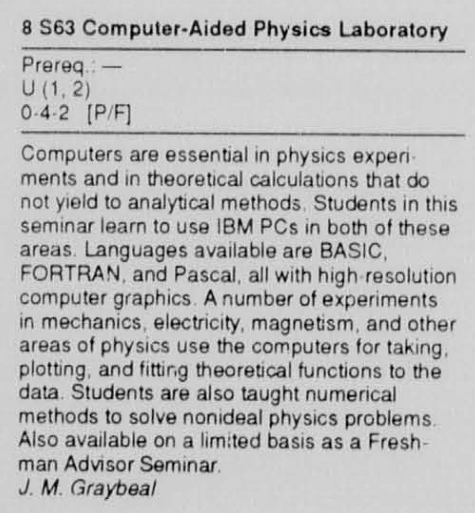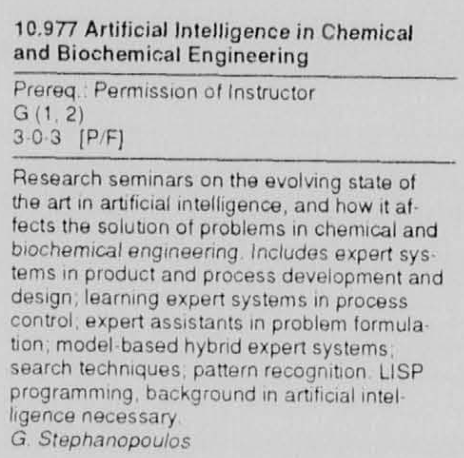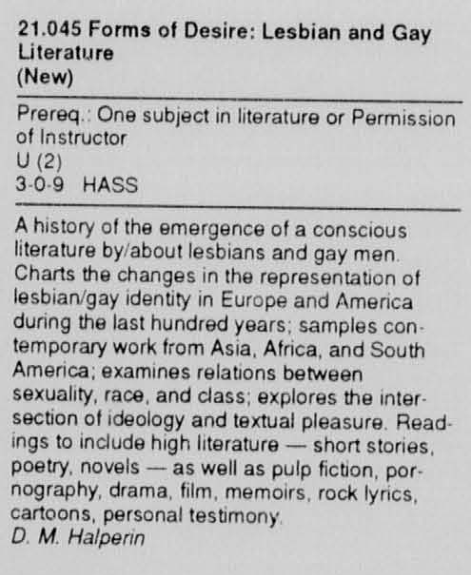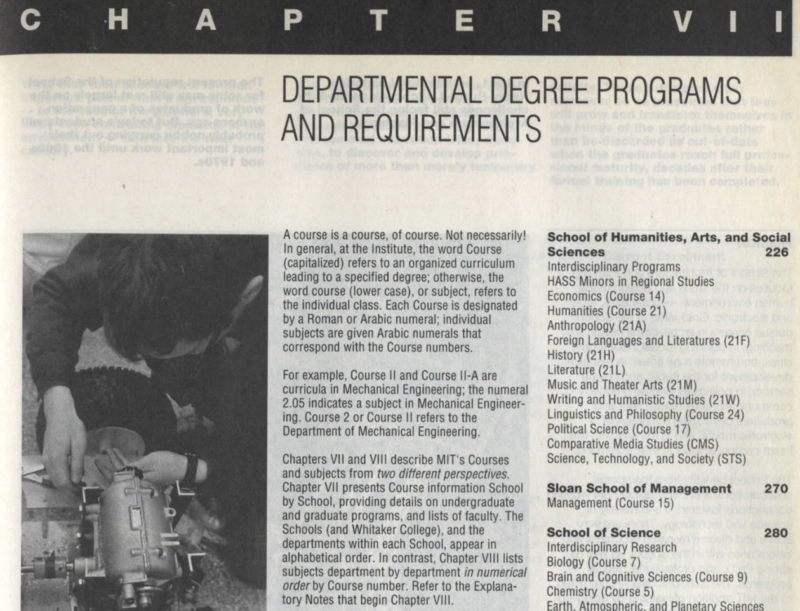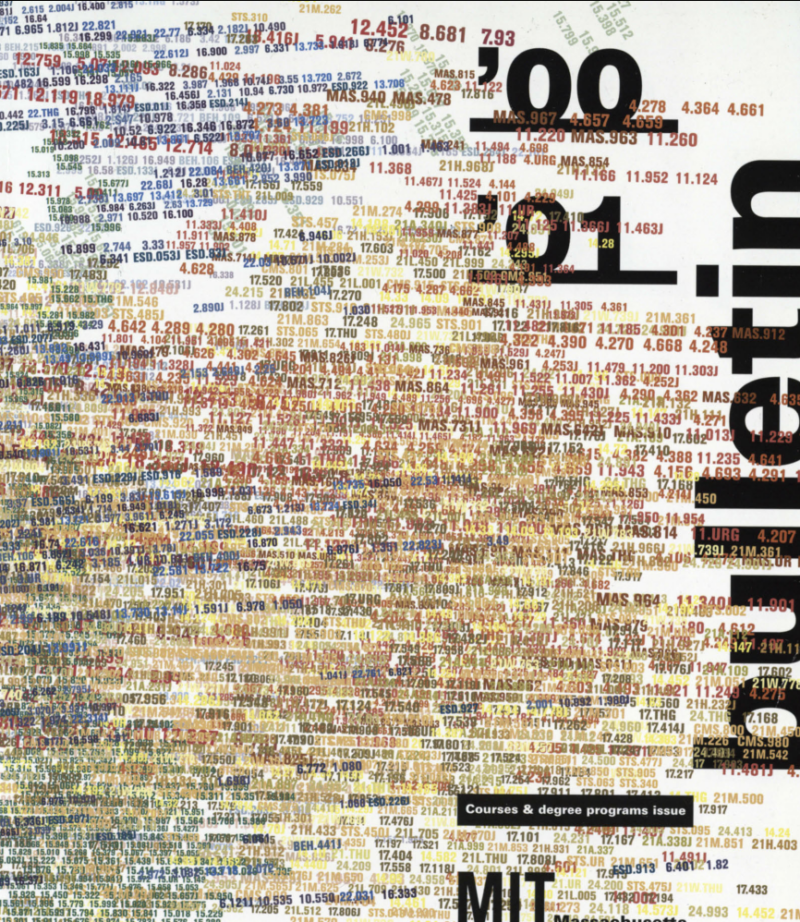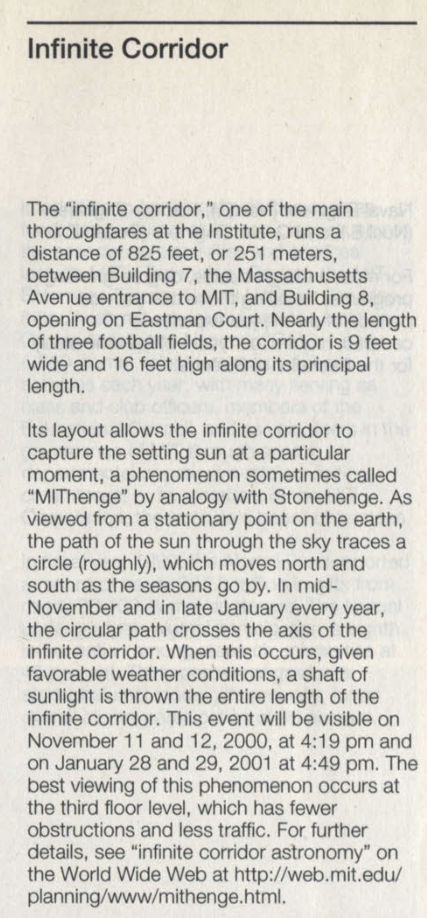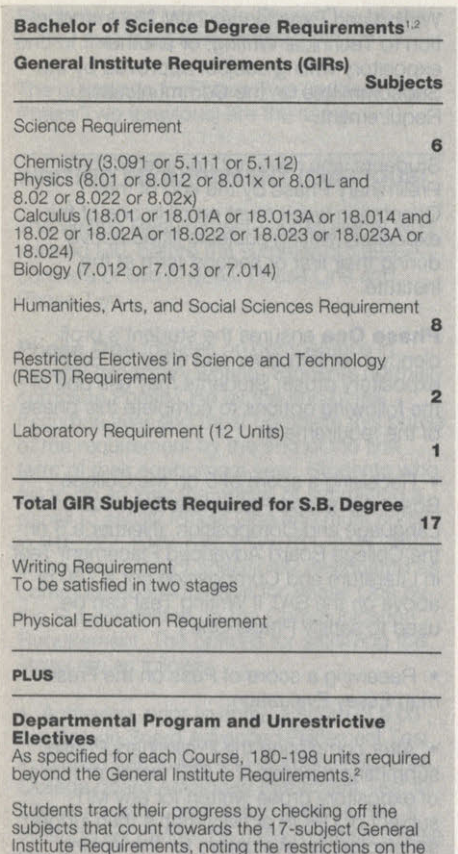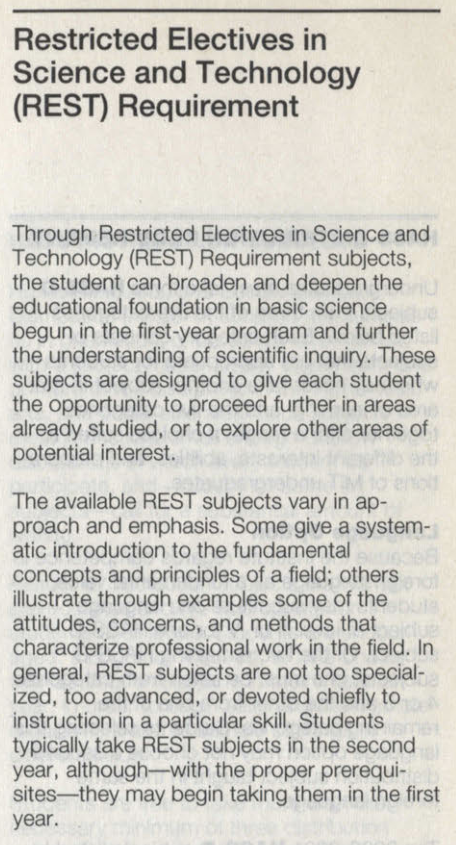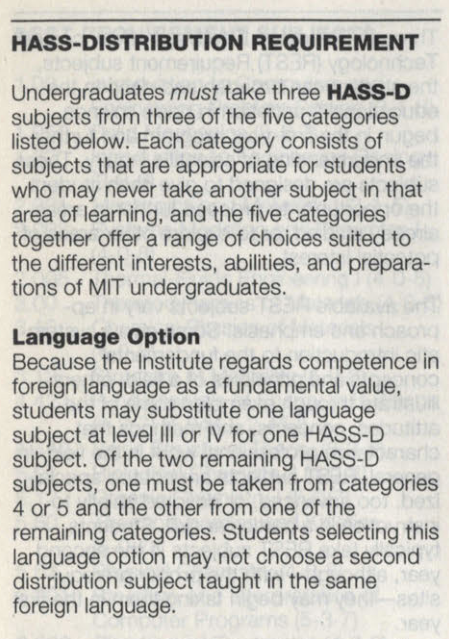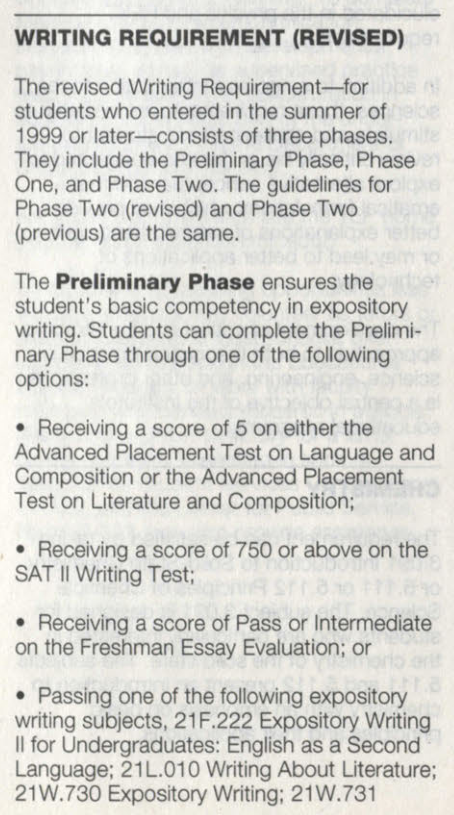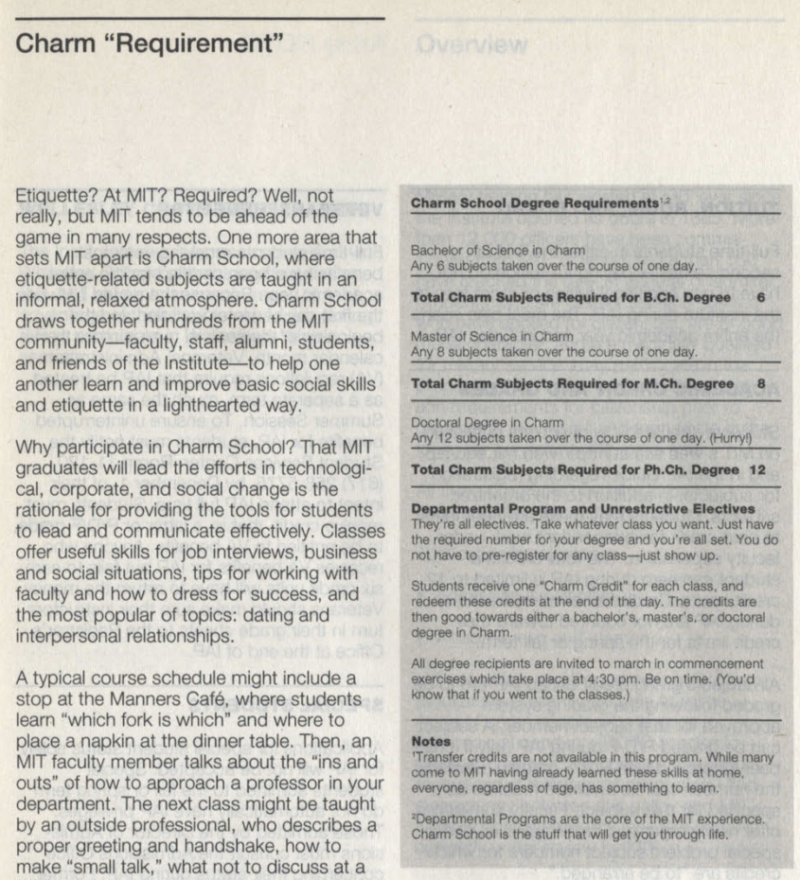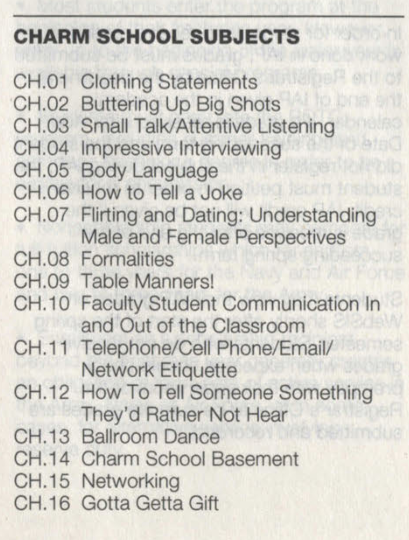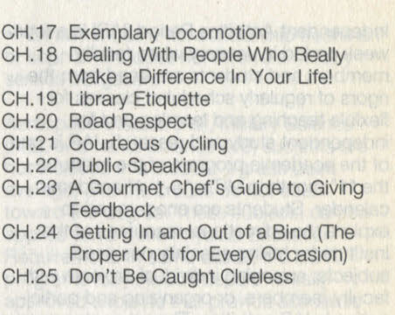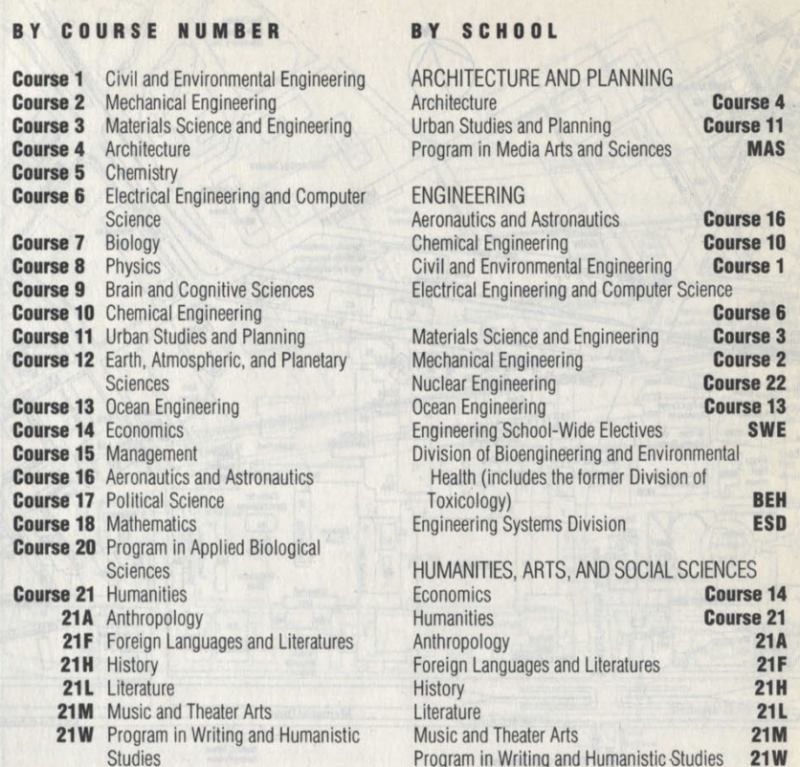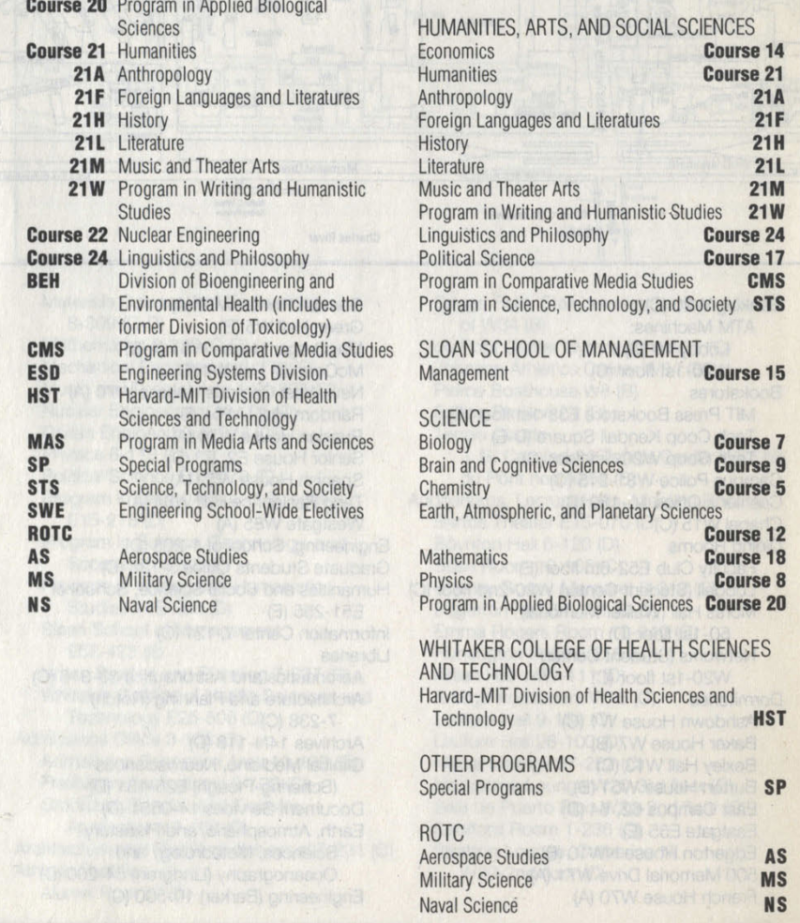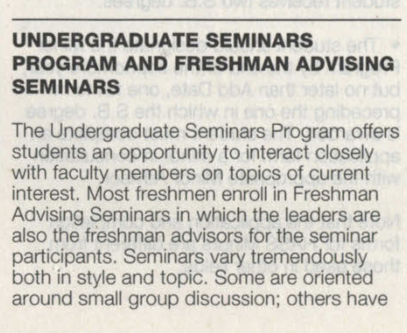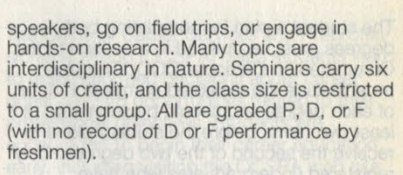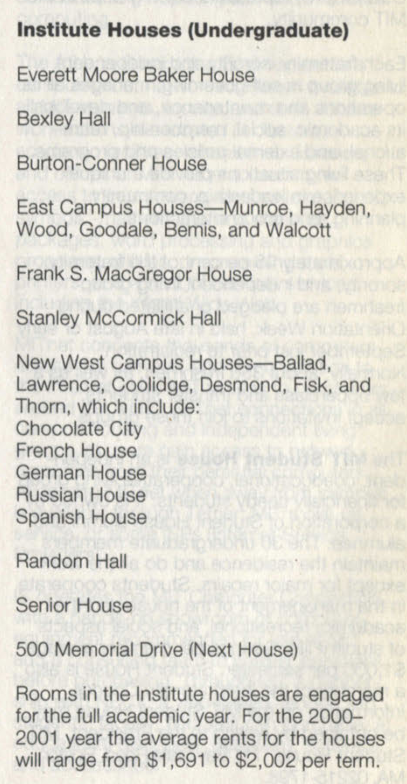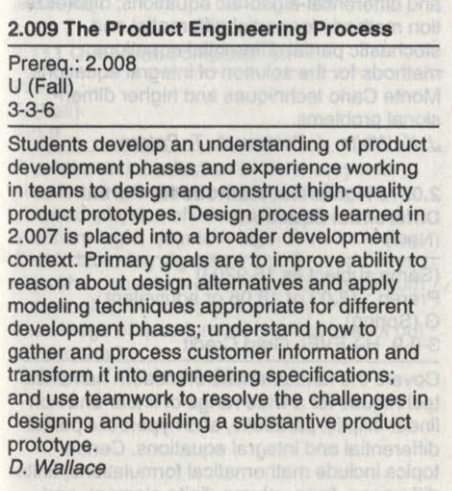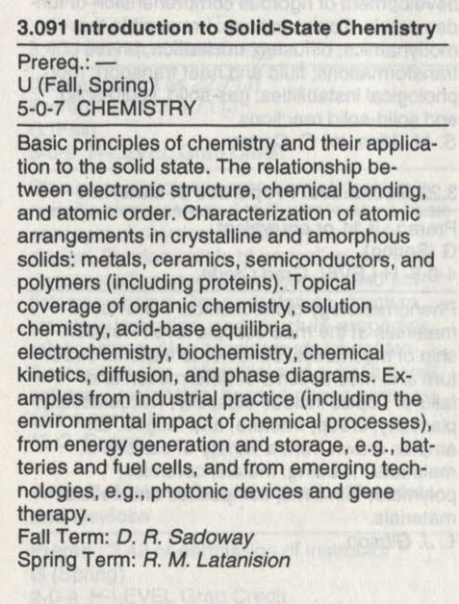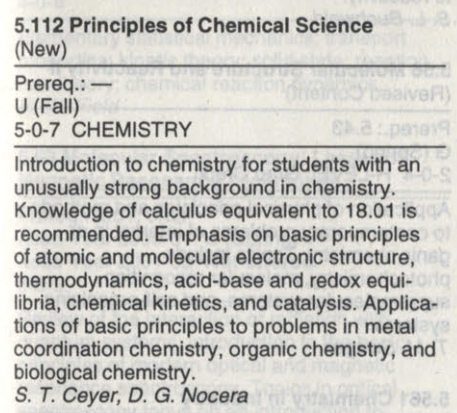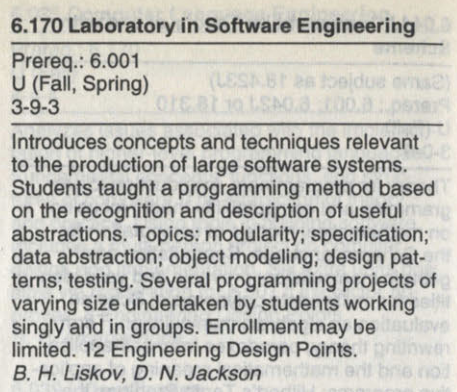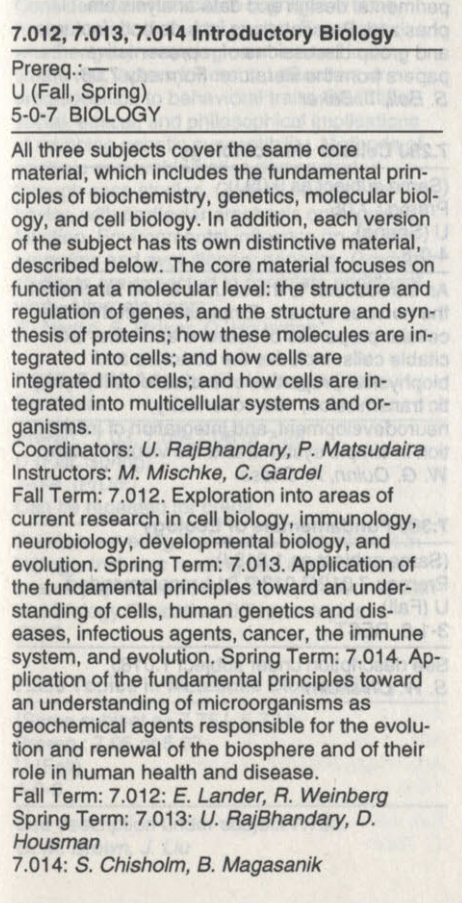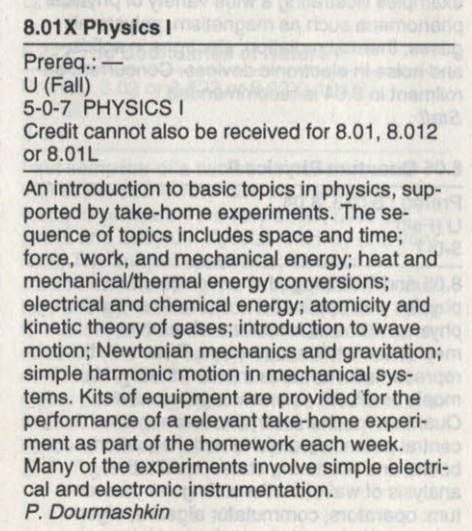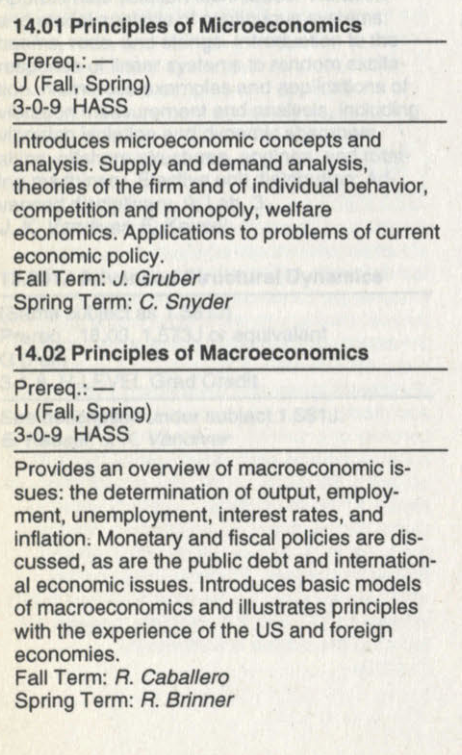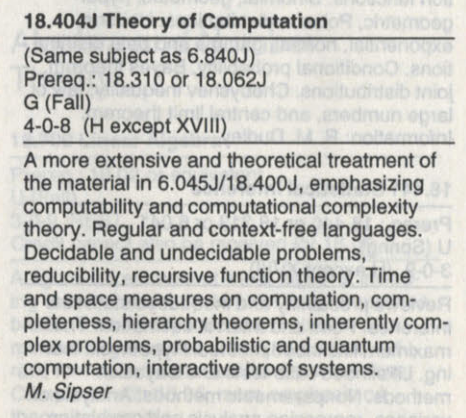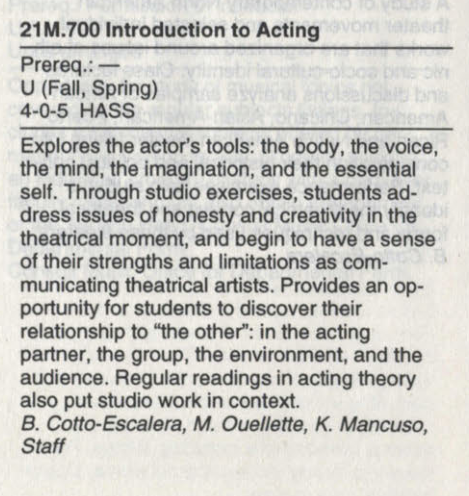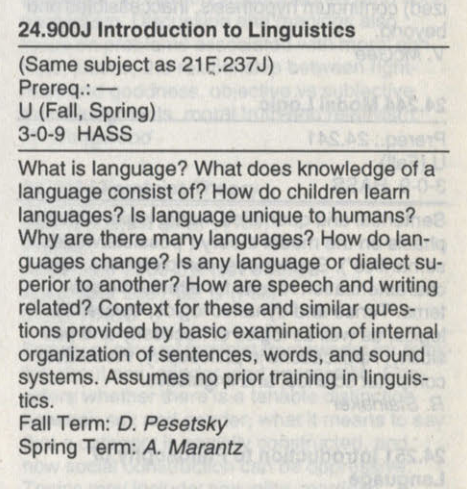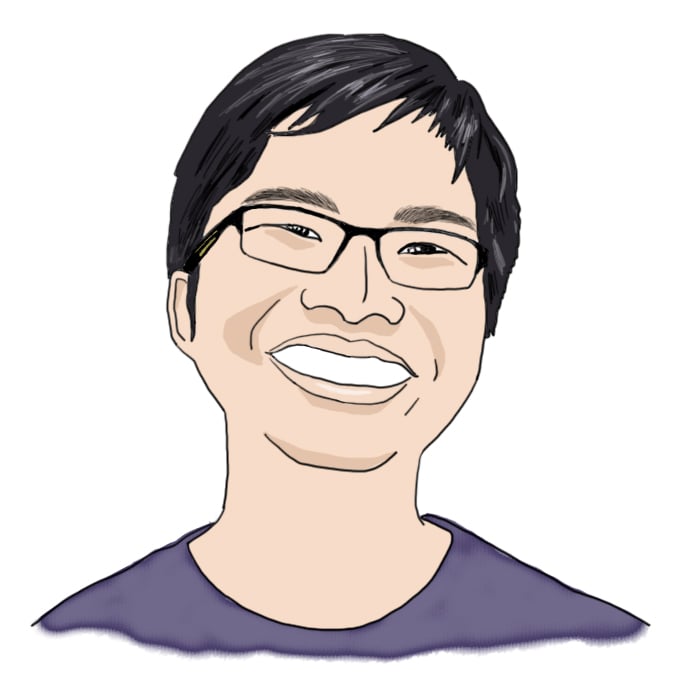
150 years of MIT course catalogs by CJ Q. '23
the mit history you want to know
MIT’s history is a topic that’s become increasingly interesting to me over the past few months. I used to think history was pretty dry, but I think this is mostly because the history people study just… doesn’t interest me. Like, consider this admissions page, or this Wikipedia article, or the readings from this OCW course. These are all histories of MIT, yes, not the kind of history that I like reading for fun.
What fascinates me is, say, what MacGregor was like fifty years ago, or the history of the GIRs, or historical admissions videos. And it turns out there’s a single historical source where you can read about these kinds of things: the MIT course catalog.
You can find the most recent course catalog online. It consists of an overview of MIT, some notes on campus life, undergraduate requirements, admission informations, schools and departments, the courses you could take and their required classes, and finally, subject descriptions. MIT has published a new catalog every year since classes started in 1865. They’re all available online, and they’re an incredible source of insights into the kind of MIT history you won’t read in history books.
I started looking into the course catalogs because I wanted to find out how long Professor Artin has been teaching algebra in MIT. It turns out he’s been teaching for over fifty years. And then I fell down the rabbit hole and learned many more interesting facts, some of which became a Twitter thread. For example, William Barton Rodgers was not only MIT’s founder, but MIT’s only physics professor for its first few years. Integral Calculus used to be a subject only juniors took. Course 20, today Biological Engineering, used to be Food Technology.
These are all things I learned from looking at course catalogs, and they’re all so interesting that I spent the last week writing this post, because I wanted to share these cool facts with you all. We’ll look at twelve catalogs, starting from the 1865–66 catalog, then catalogs every 15 years until 1940–41. From there, we’ll look at catalogs every 10 years until we reach 2000–01. We’ll end with some concluding notes, including how catalogs have changed since the 2000s.
This (very long) post is organized by catalog year. Within each year, the observations are organized into five categories. You can read this article in order from top to bottom, or you can stick to a single category and only read the observations in that category. The five categories are:
- Historical context: notes on MIT’s history in general, changes to the format of the catalog, and undergraduate admissions.
- Undergraduate requirements: general requirements that undergraduates need to get a degree.
- Schools and courses: organization of departments and schools, course numbers, and degree charts.
- Student life: what day-to-day student life looks like, residences, first-year subjects and grading.
- Subjects: subject numbering, units, specific subject descriptions.
Some disclaimers. I’m not guaranteeing accuracy for any of these things. Also, I’ll be really bad when it comes to using the terms “now” and “today”; usually “now” means “by the time this catalog was published” and “today” means “today, in 2021”. I won’t be perfectly consistent but hopefully context will make things clear.
And here’s a table of contents:
1865
1865: Historical context
First catalog. MIT’s first classes were held in 1865, and with the first classes came the first course catalog. Note the British spellings catalogue and programme in this front page, yet later in the catalog we get the spelling polarization. Language change at work.
This forty page catalog starts with a list of people: officers, faculty, then students. After this comes a general description of MIT, then a list of courses. Then there are some more general descriptions of academics and requirements, evening courses, and schedules.
School of the MIT. After listing all the people, the catalog opens with the “objects of the School of the Massachusetts Institute of Technology”. The school was explicitly for people who wanted to be mechanical, civil, or mining engineers, chemists, builders, or architects.
Male students could be admitted to become either first-years or second-years. Being admitted as a first-year meant demonstrating competence, through an exam, on “arithmetic, algebra, geometry, English grammar, geography, and the rudiments of French.”
There were also “courses of Evening Instruction”, or night classes on these topics. Unlike regular classes, these were free lecture series open to “persons of either sex”. The only application requirement was a letter of interest, and students were chosen through lottery.
| « Intro | Historical context | 1880 » |
1865: Undergraduate requirements
Academics. Instruction in the Institute was thought of in two different halves. First-year and second-year students all took the same classes, and after that students specialized in specific courses.
The catalog also has a section called “methods and apparatus of instruction”, describing lectures, exams, labs, and field trips, all familiar parts of education. But there are some differences. You were required to take lecture notes, for example, and if you failed your final exams you couldn’t continue studying.
Graduation requirements included both oral and written examinations, a dissertation, and “familiarity with French and German”. In particular, all undergraduates needed to present a thesis of some sort, and this requirement would stay for the next few decades.
| « Intro | Undergraduate requirements | 1880 » |
1865: Schools and courses
One-person departments. William Barton Rodgers wasn’t just a physics professor. He was the physics professor. The Institute’s faculty had only ten professors, one handling each course. This was in proportion to the school’s 72 students, around half of which were first-years and the rest second-years.
Course numbers. The first thing resembling course numbers appears in the very first catalog, although the numbers are quite different. We have I Mechanical Engineering (now 2), II Civil and Topograhical Engineering (now 1), III Practical Chemistry (now 5), IV Practical Geology and Mining (now… 12?), V Building and Architecture (now 4), VI Science and Literature (now literally every other course number).
| « Intro | Schools and courses | 1880 » |
1865: Student life
Day-to-day life. The catalog has schedules for both first-year and second-year students, which was all the students, since there weren’t third or fourth-year students yet.
A section of the catalog called “discipline” talks about the schedule. It was 9 AM to 5 PM most days from Monday to Friday, with a break from 1:30 to 3 PM for “dinner”. There were also Saturday classes: either Mathematics or Chemistry from 9 to 10:30 AM, and then Military Tactics until noon.
| « Intro | Student life | 1880 » |
1865: Subjects
Elements of Chemistry. The first-year chemistry class is split into two halves: “Chemistry of the Non-metallic Elements” and “Chemistry of the Metals”. They are as described by their title: literally the elements studied in groups. To be fair, Mendeleev’s version of the periodic table was published in 1869, four years after this catalog was printed.
Military Tactics. We’ll see several variations on military tactics being instructed in MIT for the next few catalogs, but it’s notable that it appears in the very first catalog. Historical context, if you’re as clueless as I am when it comes to history, is that 1865 is towards the end of the American Civil War, and before both World Wars.
| « Intro | Subjects | 1880 » |
1880
1880: Historical context
Harvard mergers. Over the next three or so decades Harvard made not one, not two, but five merger attempts. The first merger attempt was a few years before MIT’s first classes, and five more happened in 1870, 1878, 1893, 1897, and 1904.
Alumni directory. This catalog has an alumni directory, listing MIT’s graduates since 1868. This was still doable, because each class had around a dozen to two dozen graduates. Their directory lists their name, address, course number, and occupation. Some interesting listed occupations: In Business, Travelling, Cattle Breeding, Unemployed.
More students. There are now female students! This article is a good overview of the history of women in MIT. This catalog explicitly mentions the Woman’s Laboratory, which started in 1875, and closed in 1883 when MIT began formally admitting female students. There are also international students and graduate students too.
| « 1865 | Historical context | 1895 » |
1880: Undergraduate requirements
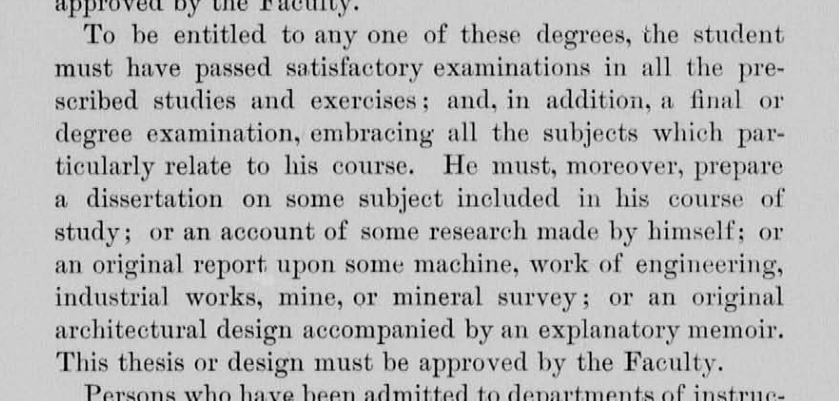
The dissertation. This catalog goes into a bit more requirements as to the required dissertation: “an original report upon some machine, work of engineering, industrial works, mine, or mineral survey; or an original architecture design accompanied by an explanatory memoir”. Which makes sense, given that the only things that MIT had degrees for then was basically architecture and engineering. (And physics, but I think “physics” here is just engineering.)
| « 1865 | Undergraduate requirements | 1895 » |
1880: Schools and courses
Named professorships. The faculty listing now has named professorships; here’s an article about them. I guess it’s kinda surprising to me that the concept of named professorships exist this early. This catalog lists a Walker Professor of Mathematics, a Hayward Professor of Civil and Topographical Engineering, a Thayer Professor of Physics, and a Lowell Instructor of Practical Design.
Course numbers. The alumni directory of this catalog refers to the courses by their number, written as a Roman numeral, so we’ve been calling courses by their numbers for a century and a half now. It’ll remain written as a Roman numeral for a long while. The numbers in this catalog are pretty much today’s course numbers:
- I Civil Engineering (is still 1)
- II Mechanical Engineering (is still 2)
- III Mining (precursor to 3 Material Science, I guess)
- IV Architecture (is still 4)
- V Chemistry (is still 5)
- VI Metallurgy (will eventually be combined with III Mining)
- VII Natural History (now 7 Biology)
- VIII Physics (is still 8)
- IX The Elective Course
- X Science and Literature
| « 1865 | Schools and courses | 1895 » |
1880: Student life
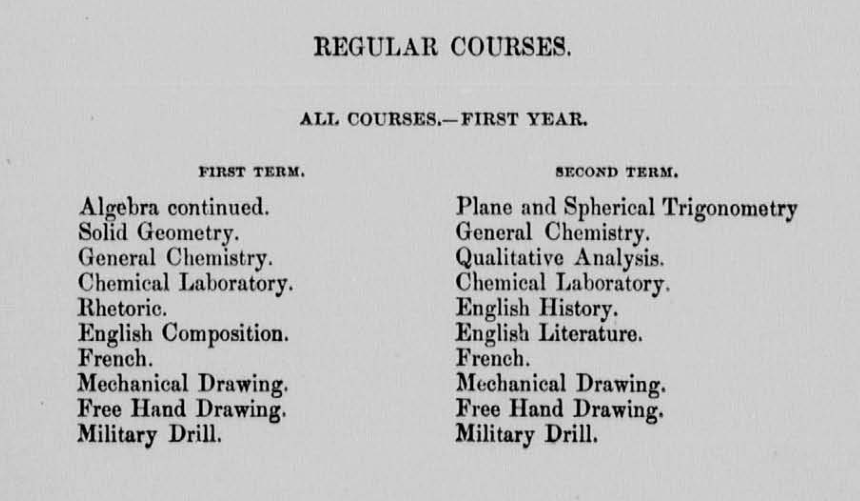
First-year subjects. In the last catalog, all first-year students and second-year students took the same classes. By this catalog, second-year classes are already somewhat course-specific, which means that only the first-year classes are shared among everyone. Even until today, MIT still has the concept of “you don’t have to take course-specific things until you’re a second year”.
Things that feel notable to me. “Algebra continued” in the first term, where here, algebra probably refers to quadratic equations and such. There’s “French”, “Free Hand Drawing”, and “Military Drill” too.
| « 1865 | Student life | 1895 » |
1880: Subjects
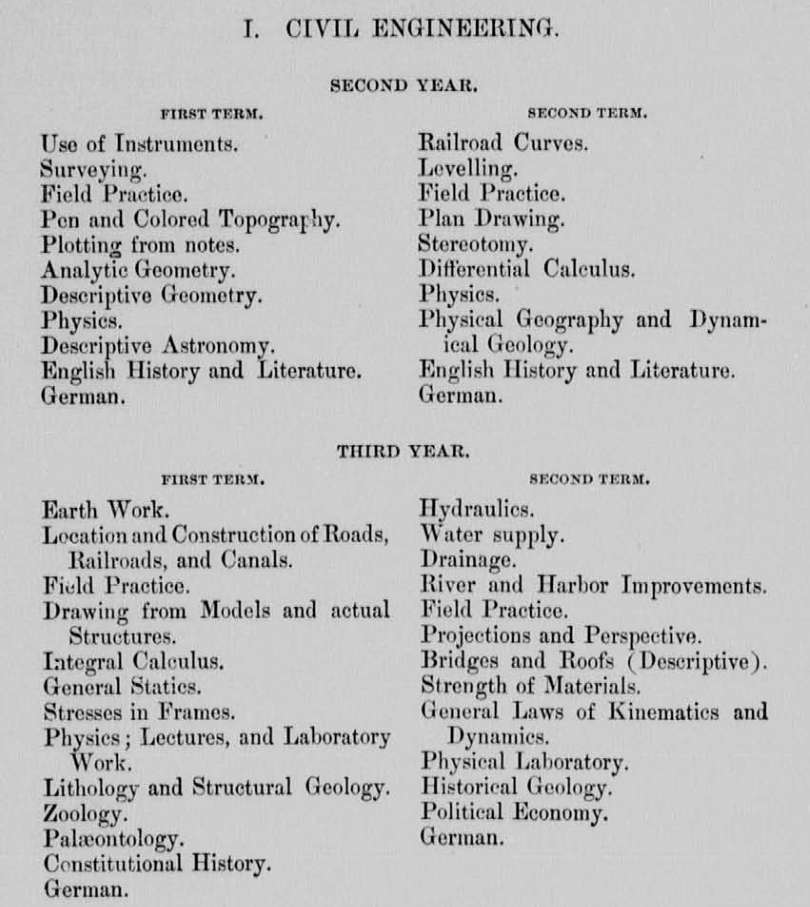
Calculus. There aren’t course descriptions in the catalog, but there are “degree charts”, a list of classes students in each course take. The most striking difference to me is the math. Differential Calculus is listed in second-year second term, and Integral Calculus is third-year first term, and that’s only for the courses that have them.
| « 1865 | Subjects | 1895 » |
1895
1895: Historical context
Admission. Like we saw last time, an entrance exam is required for admission. The exams are held in Boston, of course, but also New York, Philadelphia, Chicago, “and other principal cities”, in June. Presumably entrance exams even before this catalog were restricted to these cities, so did that mean international students went to Boston to take the exam and have no guarantee of admission?
The exams covered algebra, plane geometry, either advanced algebra or solid geometry, either French or German, English, and History. Notable, for me, at least, is the English requirement: an hour-long essay “on some subject familiar to [the candidate]”, “the correction of bad English”, and “acquaintance with good literature”. For literature, the catalog lists a whole page of books that applicants are expected to be familiar with.
| « 1880 | Historical context | 1910 » |
1895: Undergraduate requirements
Thesis. I have literally nothing else to discuss other than the fact that dissertation has now been renamed to thesis, and it also specifies that it should be submitted on “one side only of paper of good quality, 8 × 10½ inches in size, with an inch margin on the inner edge, and a half-inch margin on the outer edges.” The paper size is a bit unusual, which is literally the only interesting thing about this section.
I’m sorry. Have a picture of Ice Bear for consolation.
| « 1880 | Undergraduate requirements | 1910 » |
1895: Schools and courses
Degree charts. This is the first catalog we’ve seen that has a table resembling our modern degree charts: a table of the classes required from each student, and when these classes should be taken. Each class is also given a two- or three-digit subject number: for example, Microscopy is 603, Chemical Laboratory is 241.
There’s a vague pattern to them. For example, the 20s are all math subjects: 20 Algebra, 21 Solid Geometry, 22 Plane Trigonometry, etc. Or 522 Design, 517 Ancient Architecture, 511 Shades and Shadows. Note that this is different from modern course numbers, like 18.01 Single-Variable Calculus, in that these course numbers don’t have a number describing which department it’s in. This may be partly because the concept of each course “belonging” to a department isn’t yet full-formed; it’s only explicitly stated in later catalogs.
Course numbers. Changes compared to the last catalog we looked at:
- Mining Engineering and Metallurgy, previously III and VI, have combined to become III Mining Engineering and Metallurgy.
- VI is now Electrical Engineering (still 6 today).
- VII has been renamed Biology (still 7).
- X is now Chemical Engineering (still 10).
- XI is Sanitary Engineering, having branched off from Civil Engineering.
- XII is Geology (still 12).
- XIII is Naval Architecture.
Neither Sanitary Engineering nor Naval Architecture exist today, although they will exist for the next few decades.
| « 1880 | Schools and courses | 1910 » |
1895: Student life
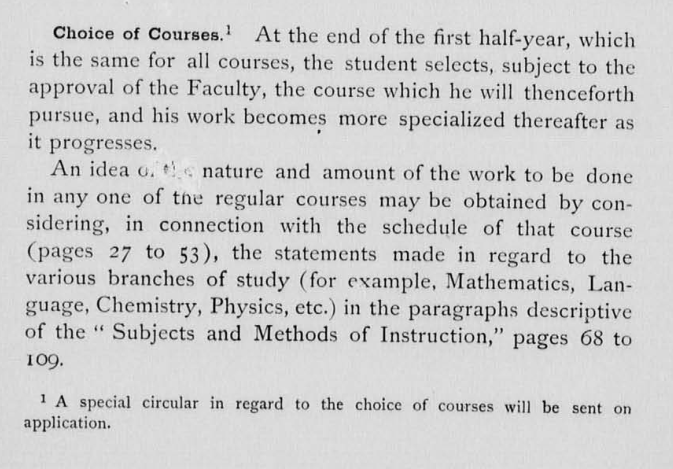
Choice of Courses. Under a section called “Choice of Courses” the catalog talks about how students choose their courses after their first term; this wasn’t explicitly stated in the previous catalogs we’ve looked at. This is earlier than when first-years today choose their courses, which is at the end of their first year. There are a number of shared courses in the second term, though.
| « 1880 | Student life | 1910 » |
1895: Subjects
Methods of Instruction. Still no class descriptions, but we’re getting a close approximation through these “Methods of Instruction” listed for each subject. There’s nothing that interesting to me except for the description of Biology, which outright calls it a “new department of science”. It still strikes me how recent biology is compared to, say, physics or chemistry. The structure of DNA won’t even begin to be studied until a decade or so later, and now people learn that DNA has a double helix shape in high school.
Calculus. Calculus has shifted even earlier now: Differential Calculus is second-year first term, and Integral Calculus is second-year second term. That’s a pretty big change for fifteen years, I think. How long before both subjects become General Institute Requirements?
| « 1880 | Subjects | 1910 » |
1910
1910: Historical context
Back Bay campus. The scan for this catalog begins with the 1905 map of MIT’s campus, back when it was in the other side of the Charles. All of these streets are still named as such today, I think, with the exceptions of Stanhope and Irvington Streets. The Boston Public Library is still there, but the other MIT buildings are now commercial.
College Entrance Examination Board. Undergraduates can now be admitted after taking either the Institute’s admission test or the CEEB test. We know CEEB today as the College Board; the organization was founded in 1899. MIT was not one of the dozen or so schools that originally founded CEEB, and so they must have accepted the CEEB test some number of years between then and this catalog.
| « 1895 | Historical context | 1925 » |
1910: Undergraduate requirements
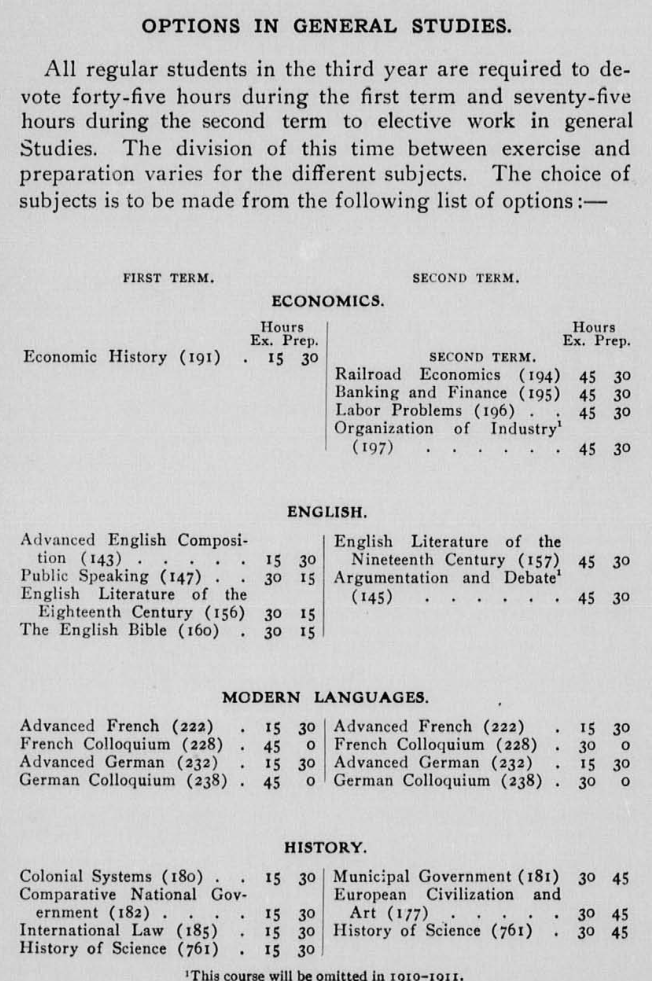
General Studies. Perhaps the first semblance of the General Institute Requirements are General Studies. Third-year undergraduates are required to take two general studies subjects: “forty-five hours during the first term and seventy-five hours during the second term”. This is the first time we see mention of the number of hours, probably a precursor to units of credit.
| « 1895 | Undergraduate requirements | 1925 » |
1910: Schools and courses
School of Industrial Science. Here we see the School of Industrial Science, which is presumably the precursor to the School of Engineering and School of Science. The departments are now separated and named. There are ones like the Department of Mechanical Engineering and Applied Mechanics, or the Department of Physical Training.
All the faculty are listed in the beginning of the catalog once, and then again later on, sorted by department. This is not only the first catalog we’ve seen with professors separated by department, but with subject listings under their respective department. With this came the concept of each class being offered by a certain department: you took an Algebra class from the Department of Mathematics, rather than just the Institute.
Course numbers. The only major change to course numbering is the addition of XIV Electrochemistry. There are some small renamings, like XII becoming Geology and Geodesy, and XIII becoming Naval Architecture and Marine Engineering, but it’s otherwise the same. No dedicated course to Electrochemistry exists today; based on the content, it seems like the closest would be 6-1 or 10.
| « 1895 | Schools and courses | 1925 » |
1910: Student life
Military Science. Previous catalogs had Military Drill, but this is the first one we’ve seen that has a description. The catalog cites the “Acts of Congress of July 2, 1862 and August 30, 1890” for why the Institute provides instruction in Military Science, required for “all male students who take a majority of their studies in their first year”, with some exceptions. The course involves drills in “Field Service Regulations, Small Arms Firing, Guard Duty and Army Regulations”.
Physical Training. We’ve had subjects like Military Drill in previous catalogs, but this is the first explicit PE class. Class 995 Physical Training is required for all first-year students, and only first-year students.
| « 1895 | Student life | 1925 » |
1910: Subjects
Unit comparison. This is the first catalog we’ve seen with a long subject index. Listed next to the title of each class is the class number, then the year students take the subject, then the “hours of instruction”, a precursor to the current unit system. Hence “Food Analysis, Adv. 649 (4) 75–15” was a subject taken in the fourth year, with 75 “hours of exercise” and 15 “hours of preparation”, over the whole semester.
With this, we can now try to compare semesters. A typical undergraduate semester today has 48 units, which is supposed to correspond to 48 hours a week, and in practice corresponds to slightly less than that. There are 15 weeks worth of class in a semester. So that’s around 700 hours per semester of classes, both in and out. A third or so would be in class, so around 230 hours of lectures.
Meanwhile, if I take, say, X Chemical Engineering’s third-year first semester, the hours of exercise add up to 485. It’s unclear whether this is supposed to include out-of-class time, but the comparison would be interesting either way.
Class numbers. With the concept of each subject “belonging” to a certain department, classes were renumbered to reflect this. Roughly. Shades and Shadows, which was 511 last we saw, is now 470. The Chemistry department has classes ranging from 550 to 649, Electrical Engineering has classes from 650 to 699, Biology has 700 to 769, Physics from 770 to 838. Still not quite the clean divisions of today’s numbering, but the order of the subjects is similar.
Class descriptions. Finally, what we’ve all been waiting for! This is the first catalog we’ve seen with explicit class descriptions, so I guess this is the first one that could be truly called a class catalog. Some things that caught my eye:
- 5505 Glass-Blowing. “Students are given an opportunity of familiarizing themselves with some of the more common manipulations before the blast-lamp under the personal supervision of the instructor.” I find this notable because glassblowing is one of the most oversubscribed classes in MIT, with hundreds entering the lottery to get into the class every fall, IAP, and spring. And it’s existed since very early in the Institute’s history, apparently.
- 745 Biology of Infectious Diseases. Virology is a relatively recent field, so the description for this class mentions “trichinosis, typhoid fever, tubercolosis, Asiatic cholera”, all diseases that are bacterial. Asiatic cholera is apparently just cholera?
- 770 Physics (Mechanics, Electricity, Optics), 771 Physics (Heat). This sounds like a reasonable progression of topics to take over two semesters of physics. You can read one of the physics textbooks mentioned for free online, if you want to have an idea of the state of physics knowledge back then.
- 836 Calculating Machines. The idea of a calculating machine back then was a slide rule. A slide rule! How many people reading this post even know what a slide rule is? Note that electronic calculators only became popular around the 1940s.
| « 1895 | Subjects | 1925 » |
1925
1925: Historical context
Moving Day. World War I lasted from 1914 to 1918, so the next catalog we’re looking at is one that’s seven years after the war. I don’t actually think the war was particularly notable in MIT history as compared to, say, World War II. Rather, the defining part of MIT’s history here is Moving Day, notable enough that it had a centennial celebration in 2016.
MIT moved to its current campus from the Back Bay campus in 1916, and the corresponding catalog has a map of the campus at the time. Some notable differences were that buildings were called “groups”, Killian Court was not a field of grass, but was paved, and Building 7 didn’t exist yet, so the main entrance was in Building 5. Hence the huge door by the side of Building 5 facing Mass Ave: that was the former main entrance to campus.
The 1925 catalog also has a map, with some differences from the 1916 map. Most notable to me is the explanation of room numbers: the labeled room numbers along the sides of the buildings are still accurate to today, with the exception of Building 10, I think.
With the larger campus came an increase in registration and faculty size, enough that by the next catalog we look at we’ll see an explicit effort to be more selective in admission.
| « 1910 | Historical context | 1940 » |
1925: Undergraduate requirements
Military Science. The class is now required not only for first-year students, but second-year students too. The course, MS21, is more theoretical compared to first-year Military Science: this lists “Topography and Map Reading” and “Signal Communications”, for example. Third-year students who are interested could also sign up for an Advanced Course.
General Studies. In what could be considered the precursor to the HASS requirement, “four terms of general study subjects are required in the junior and senior years”. General Studies isn’t its own department, but the classes form their own category in the course catalog. Topics are drawn from social and political science, economics, business, literature, history, arts, and the like.
| « 1910 | Undergraduate requirements | 1940 » |
1925: Schools and courses
A growing faculty. The list of faculty has more than doubled in size compared to the last time we’ve looked at it. No longer are faculty listed in this huge list with all the names, but they’re all listed in their own departments, each department occupying around a page of space. This is in proportion to the growth of the student body, so it makes sense.
Course numbers. A major change is the addition of XV Engineering Administration. Today Course 15 is Management, so that’s still roughly the same. IX, which used to be General Studies, got split up into three: IX-A General Science, IX-B General Engineering, and IX-C Mathematics. So yes, it took this long for us to see the first math majors, when today Course 18 is the third most common major, behind Course 6 and Course 2. There are some name changes too, like VII being renamed from Biology to Biology and Public Health.
| « 1910 | Schools and courses | 1940 » |
1925: Student life
Dormitories. MIT’s first dormitory is known to us as Senior House, although it’d be a while before it’d be called Senior House in the course catalog. It was in construction when the Institute initially moved and completed its construction the next year.
The catalog mentions a hall in the second dormitory called Ninety-Three. Today this is the Bemis section of East Campus’s East Parallel, and its construction was finished the year before this catalog was published. There’s still a sign in East Campus commemorating the fact that donations from the Class of ’93 made constructing Bemis possible—and remember, that’s the class of 1893, not 1993.
Walker. Walker Memorial is listed in the catalog underneath “Recreational Facilities”, although today it might be better known to students as “where some exams take place”. Construction was finished in 1917, so two years after moving to the Cambridge campus.
The third floor of Walker was originally a gym, but is now mostly used as an exam area. Walker back then had a dining hall and recreational things like bowling alleys, and today Walker has some sort of dining hall and recreational things like a DDR machine.
| « 1910 | Student life | 1940 » |
1925: Subjects
Units. Today the catalog displays the units for each subject as three numbers, like 3-2-7. This means 3 units for lectures, 2 units for lab, and 7 units for “outside preparation”, or homework, the idea being one unit corresponds to an hour of work per week. The 1925 catalog has an early precursor of this three number listing, although what is listed as 3-2-7 today might be listed here as 45-105 30.
Class numbers. The 1925 catalog has a numbering system even closer to the numbering system we use today. Now Shades and Shadows is numbered 4·11: the 4 indicating Architecture, the category of the class, and 11 being the specific subject. Note that the separator isn’t a decimal point, but a middot. In fact, the dot is typeset slightly higher than a middot would be, making it look more like an apostrophe.
Not all subjects follow this numbering system, though. Recall that topics like Economics, English, or Mathematics belonged to IX General Studies. These topics weren’t numbered like 9·xy though. Instead, these subjects got letters in front.
So two semesters of calculus, previously named 20 Mathematics and 21 Mathematics, are now M11 Calculus and M12 Calculus. Other subjects include E40 English, G48 Appreciation of Music, L51 French (Elementary). By the way, calculus has now shifted such that M11 and M12 are now first-year subjects.
Relativity. Relativity now exists as a subject. I don’t know enough about relativity to tell how modern the ideas in the course description are, but 8·38 Theory of Relativity seems basically the same as a modern treatment. Except these topics would be covered today in the undergraduate class 8.033 Relativity, rather than 8·38, which is a graduate class that isn’t even offered every year.
Least Squares. Class M26 Least Squares and Probability is a fourth-year class about “the method of least squares”. Quote from the textbook: “It is not at all unusual to find that the adjustment of a single set of observations takes several weeks, even with all the aid that can be obtained from tables of logarithms, of squares, of products, and of reciprocals, and also from the use of calculating machines.”
| « 1910 | Subjects | 1940 » |
1940
1940: Historical context
World War II. World War II started in 1939, the year before this catalog was published, and would continue until 1945. This war marked the beginning of MIT’s involvement in defense research, and in all would be more important to MIT history-wise than World War I.
Consider, for example, Building 20. It would originally be a temporary building for war research, but it wasn’t demolished until fifty years later. Its legacy is somewhat the stuff of legend, and some parts of its design influenced the Stata Center, the building that replaced it. Or consider Rad Lab, the precursor to RLE, one of MIT’s largest research groups today.
Of all of MIT’s departments, I’d bet that the Physics Department is the one that was probably impacted the most by the war, and the events of the war likely cemented MIT’s reputation for research. In fact, the Institute would see its budget increase over threefold by the end of the war, half of which went to research.
Catalog format. The catalog is now in a pretty different format than it has been, probably due to advances in printing or whatever. The pages are larger, the font is smaller, and there are now pictures! There’s also some organizational changes, but nothing too substantial.
Admission. The admission section talks about a “plan for stabilization of the Institute enrollment”, which caps the size of the first-year class at 600. Fun fact: there’s a Stabilization of Enrollment Committee, and the chairman is Harold Lobdell, known today as the namesake for Lobdell Dining Hall. Lobdell is better known as “that dining hall on the second floor of the Stud“, which is where lots of students would eat food during the semester.
This is also the first mention we’ve seen of the Faculty Committee on Admissions, I believe, and they are mentioned to “exercise discretionary powers of selection”. Today, eighty years later, the first-year class size is around a thousand.
The application requirements have also increased quite a bit. Although previously a recommendation from the school principal was a side note, it is now one of the requirements explicitly part of a complete application, along with two Personal Endorsements. The primary admission method is still through examination, although MIT no longer offers its own specific examination: instead, they accept results from either CEEB, the New York State Board of Regents, foreign exams, or exams from MIT’s summer session.
| « 1925 | Historical context | 1950 » |
1940: Undergraduate requirements
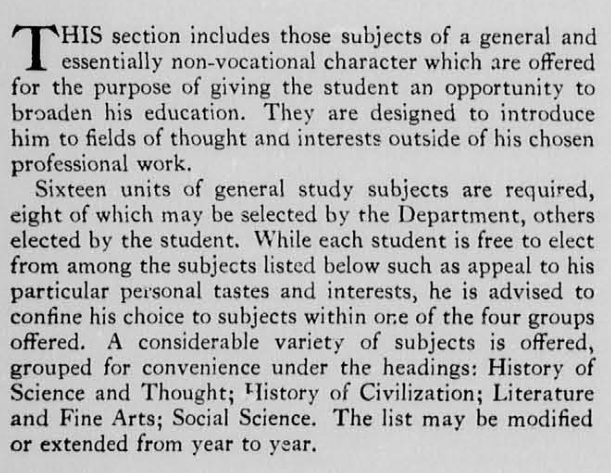
General Studies. The previous requirement for General Studies was “four terms in the junior and senior years”, although now it’s changed to just “sixteen units”. This is much less than today’s requirement, which is 8 subjects of at least 9 units each, so 72 total.
| « 1925 | Undergraduate requirements | 1950 » |
1940: Schools and courses
Schools. In 1932, President Compton reorganized the departments into schools; before that the Institute was a collection of departments. So now the course listing has now been separated into schools, sorted alphabetically: the School of Architecture (IV), the School of Engineering (I, II, III, VI, X, XI, XIII, XV, XVI, XVII), and the School of Science (V, VII, VIII, IX, XII, XVIII).
Course numbers. Courses are not only separated into letters, but subscripts too. So for example, there’s VI-A, VI-B, and VI-C, but there’s also XVIII1, XVIII2, and XVIII3. For ease, I’ll just write these with dashes, like XVIII-1, XVIII-2, XVIII-3. Lots of changes since we last saw it, the major ones being:
- There’s now IV-B and IV-C, City Planning and City Planning Practice, which today is comparable to Course 11 Urban Planning.
- XIV, previously Electrochemistry, is now gone completely.
- XV, previously Engineering Administration, is now Business and Engineering Administration.
- XVI is now Aeronautical Engineering, which is still true today.
- XVII is Building Engineering and Construction, which no longer exists today I think.
- Mathematics has changed from IX-V to XVIII, its course number today.
Degree charts. It’s still the case that students in a certain course follow a pretty set progression of subjects, with the only room of choice being between two or three options, choosing some units of General Studies, or elective subjects. (I just realized that they’re called “elective” because the student chooses them.) Some departments also allow “minor rearrangements and substitutes” with consultation of the department.
I don’t know the degree charts of other courses that well, so I don’t have much commentary to provide on the degree charts of the courses here other than math. Course 18 today has extremely flexible requirements, and even then it was pretty flexible. For example, for other courses, you had to start taking classes as soon as second year, but you could transfer to XVIII in your third year. It also lists that the precise subject order is “not important”, and each of the subjects has a relatively large number of elective units.
| « 1925 | Schools and courses | 1950 » |
1940: Student life
Student Housing. An appendix called Student Housing has some enlightening pictures of dormitories back then. There’s a picture of Graduate House, which became Ashdown House, which is now Maseeh Hall.
The name Senior House is now used, and the catalog writes that it used to be known as the Faculty Group. The name comes, of course, from the fact that Senior House used to house only seniors.
By this point the six sections of East Campus have been built and named after Walcott, Bemis, Goodale, Munroe, Hayden, and Wood. The catalog calls them the Alumni Group, and notes that it is entirely student-governed and maintained, “as a part of the general plan of student self-government at the Massachusetts Institute of Technology”.
There’s some floor plans as well. The East Campus floor plans still look very similar to what I remember EC to look like, except floors didn’t have lounges back then.
| « 1925 | Student life | 1950 » |
1940: Subjects
Units. The unit system has now changed to something that’s pretty much today’s system, with one unit representing 15 hours of work over the course of the semester, and units listed in the order lecture, lab, preparation. The number of units each class is worth still varies widely, with everything from 6 to 12 being common.
Subject Numbering System. The catalog now has a section explaining the subject numbering system! It’s still unclear which departments get numbers and which get letters, though my guess is that it’s simply a holdover of the old system.
Grad classes. Some grad classes and some fourth-year classes are marked with (A)s and (B)s, the meaning being that (A) subjects are primarily for grad students and (B) subjects are for both. I’m not quite sure what this corresponds to today, although if I had to guess, it’d probably be related to the discontinued H-level designations or whatnot.
Probability. M76 Theory of Probability is a grad class that discusses “Permutations and combinations. Elementary principles of the theory of probabilities. Bernoulli’s Theorem. Bayes’ Theorem. Distributive functions and continuous variables. Averages. Curve fitting.” Comparing this to today’s grad class 18.675 Theory of Probability, this feels like a list of half the prerequisites for that class.
Class descriptions. Some interesting ones:
- 10·69 Plastic and Other High Polymeric Substances. Plastics have only begun being mass produced at this point, I believe. “An attempt will be made to correlate theoretical considerations of structure with properties of practical industrial importance.” Okay, what is an attempt will be made supposed to mean?
- E12 English Composition, one option of which is The Post-War World. Note that this is the 1940 catalog, published a year after World War II started. Truly a post-war world.
- MS323 Military Science. Signal Corps, Advanced. “Theoretical and applicatory instruction on all telephone and telegraph equipment in use by the Signal Corps; applicatory instruction on Signal Corps field radio sets; instruction in International Morse code; pistol and pistol equipment.”
| « 1925 | Subjects | 1950 » |
1950
1950: Historical context
Admission. The new requirement by this catalog is interviews. Applicants near enough to Cambridge are expected to have an interview with the Director of Admissions themselves, and other applicants are to arrange an interview with the nearest “Honorary Secretary”.
The examination requirements have changed around, presumably, changes instigated by CEEB. The SAT now exists, called the Scholastic Aptitude Test, and applicants were required to take the SAT in the morning, followed by three one-hour “achievement tests” in the afternoon. These were probably the precursor to the Subject Tests, a reasonable guess given they were called Advanced Mathematics, English Composition, Physics, and Chemistry.
| « 1940 | Historical context | 1960 » |
1950: Undergraduate requirements
Undergraduate Sequence in the Humanities. As part of the recommendations of the Lewis Committee, undergraduates are now required to take one subject in the humanities and social sciences each term. Like much of the degree charts at the time, there’s not a lot of room for choice in this matter: first-years took English Composition both terms, sophomores took History both terms, and third-years took economics in the first term.
It was then that undergraduates got a choice of what to take. In the second term of the third-year, students could choose between Economic Principles II, Labor Relations, or Introductory Psychology, and students had four choices per term through their fourth year. Certainly a much narrower range of options than today; I probably wouldn’t be very happy being forced to study History for a year. (Then again, I did study History for several years through high school.) Also, note that the subjects have been removed from the General Studies category and numbered in their respective courses.
| « 1940 | Undergraduate requirements | 1960 » |
1950: Schools and courses
Division of Humanities. As part of the recommendations of the Lewis Committee, there’s now a Division of Humanities. The committee report called for it to be a School of Humanities, but it would take some time before the Division would grow to that. Course XV Business and Engineering Administration, and Course XIV Economics and Engineering, are both under the new Division.
Course numbers. Here’s the changelog. Is it becoming obvious that I like programming? In retrospect, maybe I should have presented these as actual diffs, that’d be easier to understand. Maybe in another post.
- VII has been renamed from Biology and Public Health to Quantitative Biology. Course VII has probably gone through the most name changes at this point.
- XI Sanitary Engineering is no longer available to undergraduates, being rolled into I Civil Engineering instead.
- XIII has been renamed from Marine Engineering to Marine Transportation.
- XIV is now Economics and Engineering. Last catalog it didn’t exist, and before that it used to be Electrochemistry. Now Course 14 is still Economics.
- XIX is now Meteorology. Today XIX doesn’t exist, and Meteorology is under Course 12.
- XX is now Food Technology. Today XX is Biological Engineering, so I guess that’s related.
| « 1940 | Schools and courses | 1960 » |
1950: Student life
Selection of Course of Study. This is the first explicit mention we’ve seen in the catalog, I think, stating that students can choose their course of study during their first year. The catalog writes that the Institute worked in “outlining the opportunities in many fields with which [the students] may not be familiar”, and that “students are permitted a free choice of the courses of study offered, except when the demand for admission to certain Courses beyond the first year exceeds the staff and facilities available.” It is still true today that first-years can choose any course they want without worrying about course quotas or whatnot.
Student Residences. Some things that strike me. “It is to the great advantage of all freshmen who do not live in fraternities or at home to live in the Institute dormitories”, with specific mention that priority is given to entering freshmen in some parts of the Alumni Houses. This is already leading up to the current Institute policy of requiring first-years to live on-campus.
There’s mention of the Women’s Dormitory, which “accommodates 17 students, or one fourth of the women enrolled”. There’s also the 24 fraternities and the MIT Student House. Westgate is also mentioned, and at the time I think it was intended for veterans. So those already exist.
The New Dormitory. The thing that most surprised me was this dormitory referred to as the New Dormitory, which was just completed by the time this catalog was written. Not to be confused with New House, New Dormitory is known to us today as Baker House. So yes, we’ve been having trouble naming dormitories for literally decades. Also, the dorm that was under construction at the time was called Riverside Dormitory. Seriously?
| « 1940 | Student life | 1960 » |
1950: Subjects
Computer classes. Here is an interesting trio of subjects, all grad classes:
- 6·535 Introduction to Digital-Computer Coding and Logic mentions “Logical analysis of a problem, flow diagrams, scale factor control, use of sub-programs and iterative sequences, and introduction to real-time applications of digital computers.” This feels like it’s approaching the beginning of programming, although I have no idea what scale factor control is.
- 6·536 Machine Computation mentions “management of variables”, probably from a time when memory was tight and you actually had to pay attention to the number of variables you use. I think this is even from the time that memory just didn’t exist and everything was register computation.
- 6·538T Electronic Computational Laboratory mentions “digital computers”, but they’re not what we think of as computers these days: it mentions pulse generators, binary counters, magnetic recording equipment. Perhaps the closest thing are “electronic differentiators”, although what an electronic differentiator looks like I have no clue.
Food technology. The precursor to Course 20 Biological Engineering is 20 Food Technology. One interesting subject is 20·32 Chemistry of Nutrition. “The needs of man and animals for calories, carbohydrates, fats, proteins, amino acids, minerals, and vitamins.” So… nutrition class?
Linguistics. What seems to be linguistics classes are under the Modern Languages category, along with German, French, Spanish, Russian. There are L71, L72 Social Linguistics, and L73, L74 Applied Semantics. The L73, L74 description includes “What happens when we make or interpret a statement? When do words get confused with things? What causes semantic blockages? How can they be removed? What are the verbal means of mobilizing emotions?”
| « 1940 | Subjects | 1960 » |
1960
1960: Historical context
Registration. There are a bundle of related changes with this catalog that have to do with the fact that undergraduates now have the freedom to register for courses they want to take, rather than follow a prescribed set of courses each term and select from a small set of electives. I talk about this change more in the individual sections, but broadly, we’ll see these changes in General Institute Requirements, degree charts, and advising.
I don’t know exactly when this change happened, and it’s such an interesting change that it has to have some historical record, but perhaps that is best left to another blog post.
Admission. While the previous catalog allowed the Regents exams, this catalog only allows the SAT. Also, interviews are now with the “M.I.T. Educational Council”, rather then Honorary Secretaries. Notably, that’s what they’re still called.
Margin notes. This is a scan with some interesting margin notes in a handful of pages. For example, this subject has “Literature” and an arrow written pointing to it. There’s also “For other subjects in literature see those listed in Modern Languages” pencilled in the margin. Was this a draft copy that went through copy-editing?
Catalog format. The catalog format changes again from the last time we’ve seen it. This one uses a modern font for its headers, probably Bodoni. And there are also a lot more “action shots” of lectures and labs and whatnot. Welcome to the future, year 1960.
| « 1950 | Historical context | 1970 » |
1960: Undergraduate requirements
General Institute Requirements. The first mention we’ve seen of the General Institute Requirements comes with this catalog. Here, the usage of the term GIRs refers to the collection of subjects all undergraduates needed to take:
- 5.01 and 5.02, General Chemistry,
- 8.01, 8.02, 8.03 or 8.031, and 8.04 or 8.041, all Physics,
- 18.01, 18.02, and 18.03, all Calculus,
- 18.04 Differential Equations,
- 21.01 and 21.02, Introduction to the Humanities,
- 21.03 and 21.04, Modern Western Ideas and Values,
- 12 units of first-year electives,
- 32 units of humanities and social science electives,
- and at least 9 units of thesis.
Note that students are no longer required to take Military Science, although the subject still exists. The GIRs are also set such that many of these requirements are fulfilled by the prescribed first-year schedule, which we’ll talk about in another section.
Today, the GIRs exclude 5.02, 8.03, 8.04, 18.03, and 18.04, and include some variant of 7.01 instead. The subjects 21.01 through 21.04 are also no longer set, and there are instead eight humanities subjects required.
Program in Humanities and Social Sciences. As part of the GIRs students take eight total humanities subjects: 21.01 through 21.04, and four electives. Students can also replace two course electives with two additional humanities subjects, if they want to.
There’s also a concentration requirement for students not studying under the School of Humanities and Social Science: “three humanities or social science subjects in one of ten fields, and a fourth or distributional subject in another field”. The HASS concentration requirement persists today, and the distribution requirement has widened.
PE requirement. This is also the first mention of the PE requirement, which is pretty much identical to the PE requirement today. Needed are 8 points of athletic credit, with the typical PE class being worth 2 points.
There is also mention of a swim test and a physical fitness test upon entrance, and “those who do not meet certain minimum standards are recommended for swimming or development classes.” It’s not clear whether students who fail the swim test have to take a swimming class, but this is clearly a precursor to the dreaded swim requirement.
| « 1950 | Undergraduate requirements | 1970 » |
1960: Schools and courses
Degree charts. The most notable change in the degree charts is that they are now degree charts, because undergraduates now have free rein to take whatever classes they want in a semester. The only comments I can offer are, again, that the Mathematics degree chart is by far the one with the most freedom, compared to, say, Physics or Food Technology. Also, the Mathematics degree chart requires foreign language for some reason?
New Schools. The School of Humanities and Social Science is now a full-fledged school, with the Department of Economics and Social Science, as well as the new Departments of Humanities and Modern Languages. What was previously XV Business and Engineering Administration has split off to form the School of Industrial Management.
Course numbers. Changes:
- III Metallurgy has split into III-A Metallurgy and III-B Materials Science.
- XII has renamed from Geology to Geology and Geophysics.
- XV has renamed from Business and Engineering Administration to Industrial Management.
- XX-B is now Biochemical Engineering.
- XXI-A is now Humanities and Engineering, and XXI-B is now Humanities and Science.
- XXII Nuclear Engineering now exists, although for now it is just a graduate course.
| « 1950 | Schools and courses | 1970 » |
1960: Student life
The First-Year Program. Students have a set schedule of courses for their first year in MIT. Each term, they take General Chemistry, Physics, Calculus, Introduction to the Humanities, and an elective subject, fulfilling roughly half of the GIRs. It’s mentioned that students can also place out of some of these classes and use the available time to take other subjects.
The elective subject in each term is an interesting requirement. Students are encouraged to use the subjects to “explore fields of potential interest”, and although any subject of at least 6 units could be used, there are special first-year electives specifically for this purpose.
These first-year electives are 6 units each and can only be taken by first-year students. There are about a dozen first-year electives available each term, ranging from 18.00 Elementary Number Theory to 20.00 Man’s Food to 3.09 Structure of Materials to 21.005 Public Speaking to MS 11 Military Science. They stopped existing after a while, but today they’ve found new life as discovery subjects.
Declaring a course. In the previous catalog, we saw one paragraph devoted to this topic, and in this catalog, there’s half a page devoted to it. While previously not much emphasis is given to exploring the courses, this catalog states that “a substantial percentage of those who do enter with a decided preference find other areas to be more to their liking”, and that students can “attend departmental orientation programs” to explore courses.
Students can declare their course as early as the end of the first year, and are required to do so by the end of the second year, which I believe is also the requirement today.
Advising. In previous catalogs, the only mention of advising is along the lines of the Dean of Students being the general adviser for the student body, and students can get assigned advisers upon request.
This catalog, however, notes “every student is assigned to a mentor of the faculty who serves as his academic adviser.” The adviser’s responsibilities are to approve registrations and changes to registration, which is pretty similar to the adviser’s role today. Also like today, students have an adviser when they enter the institute, and when they declare their course, are assigned a different adviser from the respective department.
Student Housing. First-years are now required to live “in the Institute Houses or fraternities”, and upperclassmen are “encouraged” to do so. This is similar to today’s policy, except first-years are no longer allowed to live in fraternities.
The Alumni Houses and the Faculty Houses are now collectively called East Campus, and are referred to, for example, as “the twelve Houses on the East Campus”. The New Dormitory is now named Baker House, and the Riverside Dormitory has completed construction and is now named Burton House.
Note that all of these residences are for men only. For female students, there’s the previous mentioned Women’s Dormitory, as well as Bexley Hall. In fact, Bexley is an apartment dormitory “for upperclass women and a few women graduate students, totaling thirty-three.” Bexley was demolished in 2013 and replaced with a park.
| « 1950 | Student life | 1970 » |
1960: Subjects
Subject numbering. There’s a switch from using ·, a middot, to separate the course and the subject, to using ., a decimal point. Also, it is finally the case that math subjects use 18.xy rather than Mxy, and similarly with English and Economics and all those other subjects.
Programming classes. Gosh, my bias for interesting classes is really showing, isn’t it? There are only three classes that seem remotely related to programming. One is 6.41 Introduction to Automatic Computation, a first-year elective subject(!) where students can run Fortran(!) programs on the IBM 704(!).
There’s also 6.534, which mentions dynamic programming, which to be fair was something only named a decade before this catalog was published. And there’s also 6.539 Computer-Programming Languages and Artificial Intelligence, which does mention “compilers” and “relations between programming languages” and such.
Algebra. This is the precursor to the sequence 18.701 and 18.702, and both descriptions are even in the form of the list of topics. Still shocks me how this been taught for eight years now.
Biology. It strikes me how different the topics in 7.01 General Biology I and 7.02 General Biology II are from the intro biology subjects now. It makes me wonder: how much of what was taught in these subjects is now being taught in high schools?
| « 1950 | Subjects | 1970 » |
1970
1970: Historical context
Admissions. The CEEB subject test requirements have changed, I’d guess because CEEB renamed them. It’s Level I or Level II Mathematics, Physics or Chemistry, and one of English Composition, American History and Social Studies, European History and World Cultures. This was kind of similar to the required subject tests a few years ago, at least when I applied. Now the subject tests are no longer a requirement.
Catalog changes. I want to point out this fabulous catalog cover. And also the fact that there’s a section called “M.I.T.: A Modern University”. That’s it.
| « 1960 | Historical context | 1980 » |
1970: Undergraduate requirements
General Institute Requirements. Has now expanded, again! Here are the changes to the requirements:
- The chemistry requirement has changed to a chemistry or biology requirement, and from two subjects to one. So any of 3.091 Chemistry of the Solid State, 5.01 Chemistry, 5.41 Introduction to Structure, Bonding and Mechanism, 5.60 Chemical Equilibrium, or 7.01 General Biology would satisfy this requirement.
- The physics requirement has changed from four subjects to two: either 8.01 or 8.011, and either 8.02 or 8.021.
- The calculus requirement has changed from three subjects to two: one of 18.01, 18.012, 18.014, and one of 18.02, 18.022, 18.024.
- Differential Equations is no longer a requirement.
- There are no longer prescribed humanities subjects. Instead, there are “first- and second-year humanities” and “third- and fourth-year humanities”, of which eight subjects need to be taken, subject to the restrictions we’ll mention later.
- There is a Science Distribution Requirement, fulfilled by taking 36 units of a certain list of subjects, at most 12 of can be from the student’s own department. This still exists today as the REST requirement.
- There’s a Laboratory Requirement, which is 12 units of lab classes.
- First-year electives and theses are no longer requirements.
- The dreaded swim requirement is a real thing now.
This is actually very close to the GIRs as we know it today. There’s one remaining big change that we haven’t seen yet, which is the Communication Requirement, and we’ll see this in the later catalogs.
But most of the GIRs have existed since the 70s, and it’s interesting to see how relatively unchanged it’s been for the last fifty years. There was way, way more change from the 1920 requirements to the 1970 GIRs, than there was from the 1970 GIRs to the 2020 GIRs. Stagnation or stability? Who knows, that’s not the subject of this post.
Program in Humanities and Social Sciences. Recall the previous requirement: four specific subjects for the first two years, and then a concentration, and a distributional subject. The latter requirement is still the same for the third and fourth years: students choose from one of ten concentrations, take three subjects, and then take a subject outside the concentration.
But there are now choices for humanities subjects in the first two years! First-year students can choose between one of six two-subject sequences, like 21.011 and 21.012 The Western Tradition, or 21.015 and 21.016 Contemporary Moral Issues. Second-years choose between one of four subjects in the first term, and then one of six subjects in the second term. Hooray for choices.
| « 1960 | Undergraduate requirements | 1980 » |
1970: Schools and courses
Sloan School of Management. What was previously the School of Industrial Management is now renamed to the Alfred P. Sloan School of Management, which is still its name today, although often shortened to just “Sloan”. The degree charts have five different options for the undergraduate curriculum, two more than the three options today.
Degree charts. Course VI-3 Computer Science and Engineering now exists! Today’s Course 6-3 happens to be one of the degree charts I know very well, not because I am a Course 6-3, but because a lot of my friends are.
An interesting subject choice in this degree chart is 6.261 Algebraic Foundations for Computer Science. There are some reasonable things in the description, like set theory or induction. And sure, Boolean algebras, groups, maybe I can understand. But “the construction of Galois fields”? Why? Why would you need that for computer science?
I guess I can look at the Course 8 requirements, even though I don’t know much about them. This one lists 8.03, 8.04, 8.05, 8.13T, 8.14T, 8.15, a thesis, and four additional subjects. 8.04 is Principles of Quantum Physics, but how well did we know quantum physics in 1970? No clue.
The Course 18 degree chart is extremely flexible, as it always has been, and will continue to be until today. The requirements are 18.03 Differential Equations or 18.031 Introduction to Linear Algebra and Applications, and then six subjects worth of “Course XVIII subjects excluding those with the first decimal digit zero”. This is pretty much today’s, except it’s now diff eq and linear algebra, and eight instead of six.
Course numbers. Changes. Note that the departments have also renamed around the course, but I won’t note that here:
- III, previously split into III-A Metallurgy and III-B Materials Science, is now just III Metallurgy and Materials Science.
- VI used to be split into VI-1 Electrical Engineering and VI-2 Electrical Science and Engineering. VI-1 still exists, but now VI-2 is retired and (finally!) VI-3 is Computer Science and Engineering. This is the course we now know and love as 6-3, and the most common undergraduate course in MIT today.
- VII, previously Quantitative Biology, is now Life Sciences. Yes, let’s rename Course VII every time we have a chance, why not?
- IX, which was unoccupied for quite a while, is now Psychology, although only a graduate course. It remains to today as Course 9 Cognitive Science.
- XI, previously Sanitary Engineering, is now Urban Studies and Planning, which it still is to today.
- XII has been renamed from Geology and Geophysics to Earth and Planetary Sciences.
- XIV is renamed from Economics and Engineering to Economics.
- XVI is renamed from Aeronautical Engineering to Aeronautics and Astronautics.
- XVII, previously Building Engineering and Construction, is now Political Science, which it still is until today.
- XX is no longer an undergraduate course, although it’s still available for graduate studies as XX Nutrition and Food Science.
- XXIII is now Linguistics, although it’s only a graduate course. Today, Linguistics is Course 24.
| « 1960 | Schools and courses | 1980 » |
1970: Student life
Freshman Grading. A pass-fail grading system was implemented for the first-year class beginning in 1968, and then for a trial period of four years. This is the first of many grading experiments for the first-year class, of which we’ll see more of.
First-Year Program. It’s now clarified that the provided schedule is a “typical schedule”, and “many other programs are also appropriate”. So yes, even more freedom is being given to first-year students to choose classes, which in my view is good. The catalog also explicitly states that “any subject offered by the Institute is open to the freshman, provided he can satisfy the prerequisites.”
New residences. So many new residences have been built since the last catalog, which likely contributed to the corresponding increase in enrollment: MacGregor and McCormick have been built, and Random Hall now exists too.
Bexley is no longer for women only, and has been changed to be for men only. Instead, “unmarried women members of the freshman class who do not live at home are required to live in McCormick Hall.” The Alumni Houses have been renamed to the East Campus Houses, and Burton is now Burton–Conner.
| « 1960 | Student life | 1980 » |
1970: Subjects
Units. With this catalog, the units for subjects have become more uniform. It used to be the case that the total number of units a class was varied wildly from 6 to 15 and everything in between, but now most classes in the catalog are 12 units, with a few that are 6, 9, or 15. This makes the unit system closer to today’s, where almost all subjects are worth 12 units.
Algorithms. Class 6.546J, same as 18.426J, is Algorithms, a grad class. The J means that the subject is jointly offered by two departments, and I think this is the first catalog we’ve seen with subjects marked with Js. The algorithms mentioned are “parsing, sorting, searching, shortest-path methods, fast matrix multiplication”.
Most of these topics are things we’d handle with libraries these days, and 6.006 today covers many of these topics and more. Things have really changed in fifty years. What will algorithms classes look like fifty years from now?
Combinatorics. The only subject that looks like it could be considered combinatorics in today’s sense is 18.505 Combinatorial Theory. My completely baseless theory is that MIT’s math department had a gradual shift from numerical methods and analysis, to algebra, combinatorics, and theoretical CS, coupled with a shift from viewing math as just an engineering tool to a full-fledged field of study. But that’s just wild speculation.
Algebra. Okay, I know I’ve been talking a lot of math and CS, but I think this is justified because this is cool. In this catalog, 18.701 and 18.702 Modern Algebra have M. Artin as the instructor. This is Michael Artin. He taught 18.701 last fall, and he will teach 18.702 this spring. Think about that. Artin has been teaching this class for five decades. Artin has taught professors who have taught my professors. If that’s not dedication I don’t know what is.
Music Theory. The series from 21.821 through 21.824 looks pretty similar to the 21M.301 through 21M.304 series today, on first glance. I do want to take 21M.301 some time, so maybe I’ll be able to judge then. But I’m kinda surprised how little I know about the history of modern music theory.
| « 1960 | Subjects | 1980 » |
1980
1980: Historical context
Catalog changes. Helvetica is in! It’s the future now and no one likes using serif fonts. Also, the catalog is now three columns to a page, and despite that, it’s twice as many pages as the last catalog we’ve seen. This continued catalog expansion will progress to the point that the subject descriptions will eventually be separated from the rest of the catalog.
The Interdepartmental Study and Research section of the manual has also expanded, from ten pages to forty. That sounded remarkable to me, I don’t know why.
Admissions. The concept of Early Action and deferred admissions also exist now. Yeah, these are the only interesting changes to my eye.
| « 1970 | Historical context | 1990 » |
1980: Undergraduate requirements
General Institute Requirements. Now expansive enough that it has its own big section. It’s unchanged from the last catalog we’ve seen, with the exception of the Program in Humanities and Social Sciences requirement, which has been renamed to the Humanities, Arts, and Social Sciences requirement.
The HASS requirement listed in the catalog is pretty much the one we know it today. Eight subjects, at least nine units each. At least three must form a distribution, which means they should be chosen from three different fields in a certain list. Three or four subjects must form a concentration, so they’re about a single topic like Drama or Psychology.
| « 1970 | Undergraduate requirements | 1990 » |
1980: Schools and courses
Degree charts. Two degree charts that caught my eye. First is XVI Aeronautics and Astronautics, because it’s the first catalog we’ve seen where they have Unified Engineering. Unified is this sequence of two 24-unit subjects typically taken by sophomores in the course. It’s notorious for several reasons, but I think it’s just notable for being a huge course.
There’s also XXIV-2 Language and Mind, which is kinda like linguistics but not really? It has the subject 24.900J The Study of Language and 24.901J Language and its Structure, which are definitely linguistics subjects, but it seems like those are the only linguistics subjects? 24.900J corresponds to today’s 24.900, the intro linguistics course, and 24.901J looks like some combination of today’s 24.901 and 24.902.
Course numbers. The major changes are:
- III dropping the Metallurgy from its name, now just being Materials Science and Engineering.
- XIII has split into two. There’s XIII Naval Architecture and Marine Engineering, and there’s XIII Ocean Engineering. They’re both XIII, yes. The department itself has also renamed from Naval Engineering to Ocean Engineering.
- XXII Nuclear Engineering is open to undergraduates too.
- XXIII, previously Linguistics, has just… disappeared.
- XXIV is now Linguistics and Philosophy, when previously there was just XXIII Linguistics. Although only Philosophy is open to undergraduates, there is XXIV-2 Language and Mind which can be a linguistics course.
- XXV is now the Interdisciplinary Science Program.
- HST Health Sciences and Technology is now a graduate course. Yes, we still have HST, although it’s one of the lesser-known programs.
- STS Science, Technology, and Society is now a thing. It’s not a undergraduate course, although there are subjects under STS.
| « 1970 | Schools and courses | 1990 » |
1980: Student life
Pass/no-record. The pass/fail grading policy is now permanent, and it’s also stated that failing grades do not appear on the permanent record, which is the “no record” part of P/NR we all know and love today.
First-year programs. The catalog now mentions Concourse and ESG, two of the learning communities first-years can choose to be a member of.
Residences. New House now exists, although not quite as we know it. French House, German House, Russian House, and Spanish House are listed separately, and Ballard, Laurence, Coolidge and Desmond are listed under the name “New West Campus Houses”. Yes, we’re bad at naming dormitories. WILG also exists now. There’s also no more mention of which residences are for men only or women only, although presumably McCormick isn’t co-educational.
| « 1970 | Student life | 1990 » |
1980: Subjects
CS classes. More CS bias, but please forgive me, I know not what else to talk about. Some interesting ones:
- 6.001 Structure and Interpretation of Computer Programs. Legendary course, or at least, the book is the stuff of legend. The book in fact won’t be published until 1985, so the class is probably the basis for the book, as it turns out.
- 6.034 Artificial Intelligence. This one is already taught by Patrick Winston, which meant that Winston taught 6.034 for four decades. I used to think that the concept of AI was relatively recent, but the phrase “artificial intelligence” even appeared in the last catalog we saw.
- 6.046 Introduction to Algorithms. The description mentions a lot of things about arithmetic, which today isn’t that big of a problem because floating point algorithms are good now. Also, it’s taught by Rivest, of RSA fame. Today 6.006 is intro algorithms, and 6.046 is the follow-up course.
Math classes. Yes, I know nothing but CS and math. Mostly I just wanted to point out that 18.419J Cryptography and Cryptanalysis is taught by Rivest and 18.444 Probability and Statistics for Scientists and Engineers is taught by Chernoff. Imagine taking a crypto class from Rivest, or from Chernoff, of Chernoff bound fame. It’s probably as hype as taking an algorithms class from Karger.
| « 1970 | Subjects | 1990 » |
1990
1990: Historical context
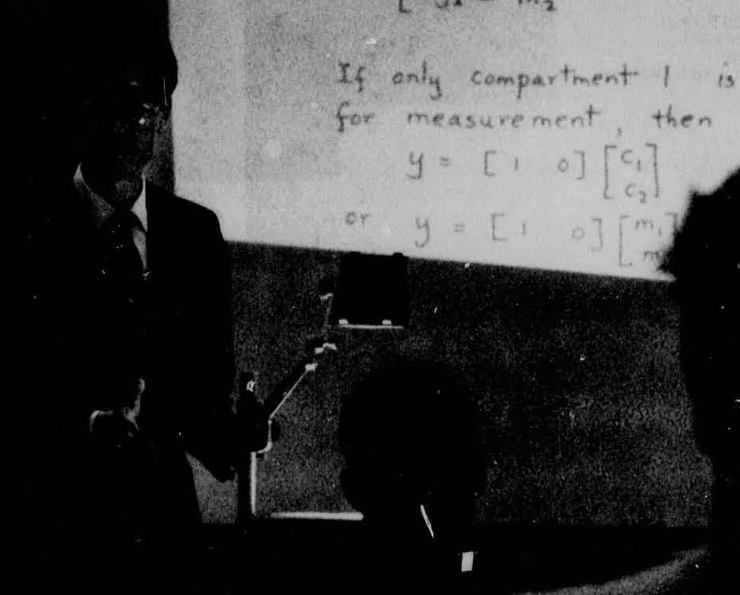
Catalog changes. Nothing really, it’s just that the PDF has changed to a two-page spread, which is really annoying to browse. Oops. There’s also this neat picture I wanted to show.
| « 1980 | Historical context | 2000 » |
1990: Undergraduate requirements
General Institute Requirements. The Chemistry or Biology requirement has changed to just Chemistry, apparently. There’s now also a Writing Requirement, with what looks to be a precursor to the Communication Requirement, which has a Phase One and a Phase Two.
Phase One could be satisfied with either a satisfactory score on the English Composition subject test, a 5 in AP English Language and Composition, passing the Freshman Essay Evaluation, taking some expository writing subject, or submitting a paper. Compare this to the CI-HW part of today’s requirement.
Phase Two is much like the CI-M requirement, and could be satisfied by either taking a writing subject in one’s major, taking some scientific writing subject, or submitting a paper.
HASS requirement. Did you know that this catalog has a glaring typo where it writes HAAS requirement instead of HASS requirement in the section title?
Anyway, the distribution requirement has changed. There are “HASS-D” subjects, in five HASS-D categories. You had to take one subject in either category 1 or 2, one subject in either category 4 or 5, and any subject from the remaining three categories. The categories were, in order, Literary and Textual Studies, Language, Thought and Value, The Arts, Cultures and Societies, and Historical Studies. So this is getting closer to today’s requirement, but not quite there yet.
| « 1980 | Undergraduate requirements | 2000 » |
1990: Schools and courses
Course numbers. What frustrated me about this catalog is that there isn’t a huge table with all the available courses. So these are the only changes I noticed:
- IX Cognitive Science is now an undergraduate course, and its corresponding department is now Brain and Cognitive Sciences.
- XII got Atmospheric added to become Earth, Atmospheric, and Planetary Sciences, its current name.
- XXI has split into six separate programs: XXI-Y Anthropology, XXI-F Foreign Languages and Literatures, XXI-H History, XXI-L Literature, XXI-M Music and Theater Arts, and XXI-W Program in Writing and Humanistic Studies. Why Anthropology isn’t XXI-A is a mystery to me.
- XXIV now has a proper Linguistics course, XXIV-2, with XXIV-1 being Philosophy.
- MAS is Media Arts and Sciences, which doesn’t have a course, but it is a department or something.
| « 1980 | Schools and courses | 2000 » |
1990: Student life
First-year P/NR. Starting with 1990, first-years got P/NR grading for all subjects they take in their first year, first semester and second semester. Yes, P/NR for both semesters in the first year. This isn’t the case today. The way it’s mentioned in the catalog is rather unusual, in that grades are P, D, or F, but D or F aren’t recorded on the permanent record. So isn’t that just P/NR? I dunno. This will continue to be the case until, I think, 2001?
Residences. It’s now the New West Campus Houses, with Ballad, Lawrence, Coolidge, Desmond, Fisk, and Thorn, with Chocolate City, French House, German House, Russian House, and Spanish House listed underneath. There’s also 500 Memorial Drive, which is still the official name of Next House.
What was previously just fraternities has expanded to Fraternities, Sororities, and Independent Living Groups, as we know them today, FSILGs.
| « 1980 | Student life | 2000 » |
1990: Subjects
Interesting subjects. I am running out of things to talk about because all the subjects are rather similar to today’s, but here:
- 6.311 Telephony. It mentions “manual switchboards, step-by-step, crossbar, and ESS offices”. Do half of those things still exist as part of “current telephone technology”? I don’t know.
- 8.S63 Computer-Aided Physics Laboratory. “Computers are essential in physics experiments and in theoretical calculations that do not yield to analytical methods.” It mentions “Languages available are BASIC, FORTRAN, and Pascal, all with high-resolution computer graphics.” High-resolution computer graphics that is probably a hundred times worse than the screen you’re using to read this.
- 10.977 Artificial Intelligence in Chemical and Biochemical Engineering. I suppose the 1990 equivalent of the phrase “machine learning” is “artificial intelligence”. You can see the requirement of “LISP programming”, because AI research back then apparently really liked LISP.
- 21.045 Forms of Desire: Lesbian and Gay Literature (New). “A history of the emergence of a conscious literature by/about lesbians and gay men.” Readings for the class included “pulp fiction, pornography, drama, film, memoirs, rock lyrics, cartoons, personal testimony”.
| « 1980 | Subjects | 2000 » |
2000
2000: Historical context
Catalog changes. The catalog is now published “in print and on the web”. The body font is now a thinner Helvetica weight, and the catalog also uses a narrower Helvetica at times. The cover has some strong 2000 vibes for some reason—is that Impact? Some parts of the catalog also have text that… reads way more casually.
MITHenge. It surprises me that not only the Infinite Corridor gets a mention, but so does MITHenge! Interesting.
| « 1990 | Historical context | After 2000 » |
2000: Undergraduate requirements
General Institute Requirements. Biology is now a requirement, the Science Distribution Requirement has been renamed to the REST requirement and reduced from three subjects to two. The HASS-D requirement was changed to just any three of the five categories. The only other change is in the Writing Requirement, where Phase One was split into a Preliminary Phase and Phase One.
Charm “Requirement”. How did this end up in the catalog, under the GIRs section? Charm School was an event that happened over an afternoon during January in IAP. Classes for this Charm School included CH.05 Body Language, CH.12 How To Tell Someone Something They’d Rather Not Hear, and CH.25 Don’t Be Caught Clueless. Why? Why?
| « 1990 | Undergraduate requirements | After 2000 » |
2000: Schools and courses
Course numbers. I have no clue what exactly has changed, given that I had no clue what the 1990 changes were exactly. Uh, XXI-Y Anthropology is now XXI-A, which is a reasonable name. CMS Comparative Media Studies exists, and some things under ROTC like AS Aerospace Studies, MS Military Science, and NS Naval Science now are separate. I dunno.
| « 1990 | Schools and courses | After 2000 » |
2000: Student life
Freshman Advising Seminars. Are a thing now. They’re still a thing today, but it surprises me that these were a thing as early as the 2000s—I was kinda expecting this not to appear until later.
Residences. The only change is that 500 Memorial Drive got a (Next House) after it. That’s it. That’s the only change.
| « 1990 | Student life | After 2000 » |
2000: Subjects
Subjects taught by the same professor. Mostly stolen from the original Twitter thread, here are some observations about subjects taught by the same professor today and twenty years ago. Many of these subjects that are “famous enough” that I’d bet lots of MIT undergrads would recognize these by their numbers:
- 2.009 The Product Engineering Process. Not quite the same professor, but Wallace taught 2.009 back then and is teaching 2.00B this spring. This is the first catalog we’ve seen that has 2.009, by the way, which is such a legendary class there’s a yearly blog post about it.
- 3.091 Introduction to Solid-State Chemistry. Sadoway is listed as teaching the Fall 2000 version, and Sadoway also taught Fall 2020 virtually. I would know, because I took 3.091 last fall!
- 5.112 Principles of Chemical Science (New). Previously this was 5.11, a single subject, which by this catalog has split to two subjects, 5.111 and 5.112. The latter is intended for students with some more chemistry background. Ceyer taught the course in Fall 2000 and in Fall 2020.
- 6.170 Laboratory in Software Engineering. Wow, this is a class that’s changed, even if it’s (co-)taught by the same professor. Jackson co-taught in Fall 2000 and taught it in Fall 2020, but wow, the descriptions are so different!
- 7.012 Introductory Biology. Lander co-taught it in Fall 2000, and Lander co-taught it in Fall 2020. Something something did you know Eric Lander can predict the future?
- 8.01X Physics I. Not quite the same again, since 8.01X doesn’t exist now. But Dourmashkin taught it in Fall 2000, and in Fall 2020 Dourmashkin taught 8.01. Dourmashkin will also apparently be teaching 8.02 this spring.
- 14.01 Principles of Microeconomics, 14.02 Principles of Macroeconomics. This is two of them! Gruber taught in Fall 2000 and Fall 2020, and Caballero taught in Fall 2000 and will teach this Spring 2021.
- 18.404J Theory of Computation. Taught by Sipser in Fall 2000, taught by Sipser in Fall 2020, and I would know because I took it. The description’s also exactly the same.
- 21M.700 Introduction to Acting. Although the subject number’s changed to 21M.600, the description’s practically unchanged. Mancuso is listed as a co-teacher then, and Mancuso also taught one of the sections of 21M.700 last fall.
- 24.900J Introduction to Linguistics. It was taught by Pesetsky in Fall 2000, and I took it with Pesetsky in Fall 2019. Although he didn’t teach 24.900 last fall, he did teach 24.902, which I also took.
| « 1990 | Subjects | After 2000 » |
After 2000
MIT stopped publishing course catalogs on paper beginning with the 2009–10 catalog. Or at least, they stopped publishing it widely, only having a small print run instead. I think the most interesting about this article is the mention that you can get the catalog in a CD. Wow. The last time I touched a CD was four years ago.
The official catalog website is catalog.mit.edu, and it has an archive of past catalogs. By this point the catalogs have grown so large that if you look at the PDF versions, the not subject descriptions part is around 500 pages, and the subject descriptions part is around 800 pages. Imagine lugging around a book of that size!
In practice, I only use the catalog website to, say, check degree charts. Most people I know use the subject listing on student.mit.edu instead. It’s older, but I think it’s just better in several ways.
Alright. There are parts of this I wish were better—while writing this post, I started wishing I had access to a history of, say, dorms, or student organizations, or buildings. Maybe I’ll end up distilling some of the information in this post to future posts about these things. But for now, I’m already at four thousand words longer than my previous longest post, so I’ll stop.
